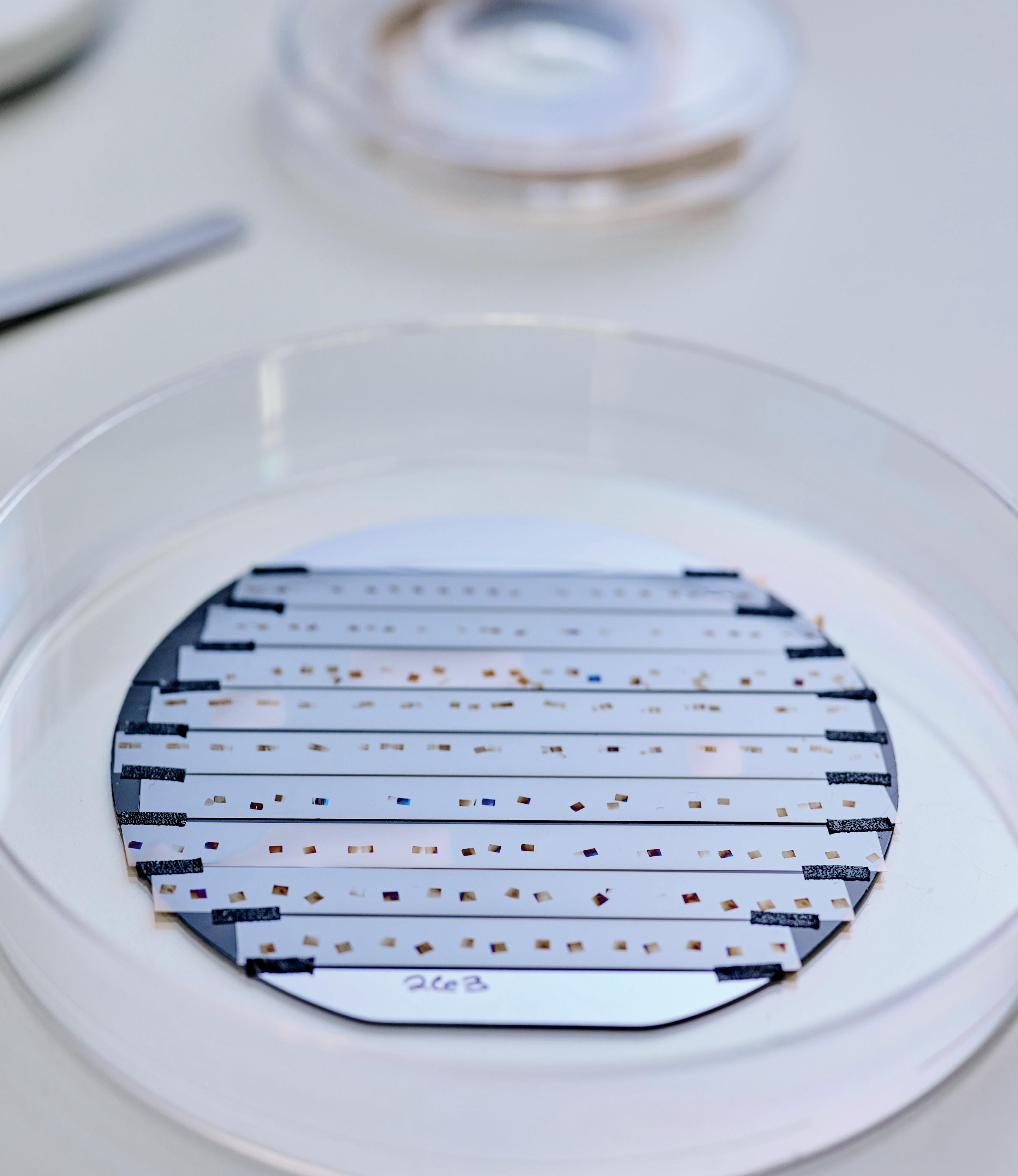

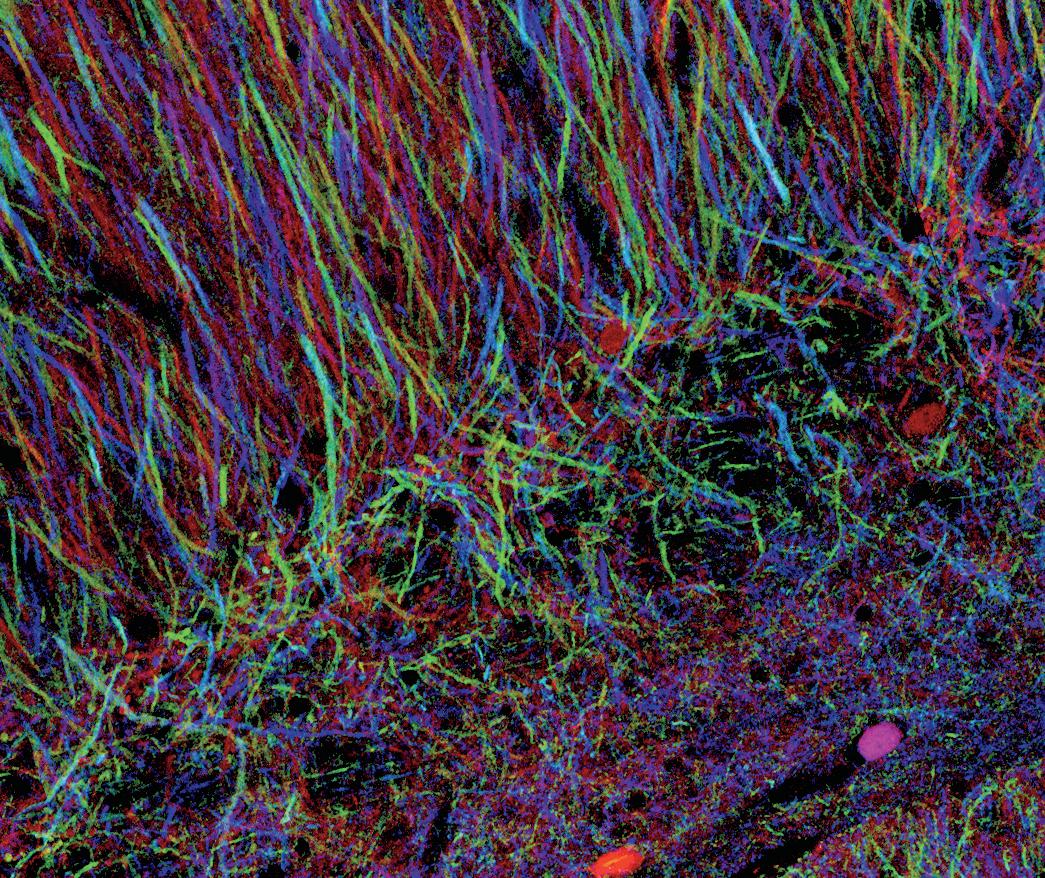

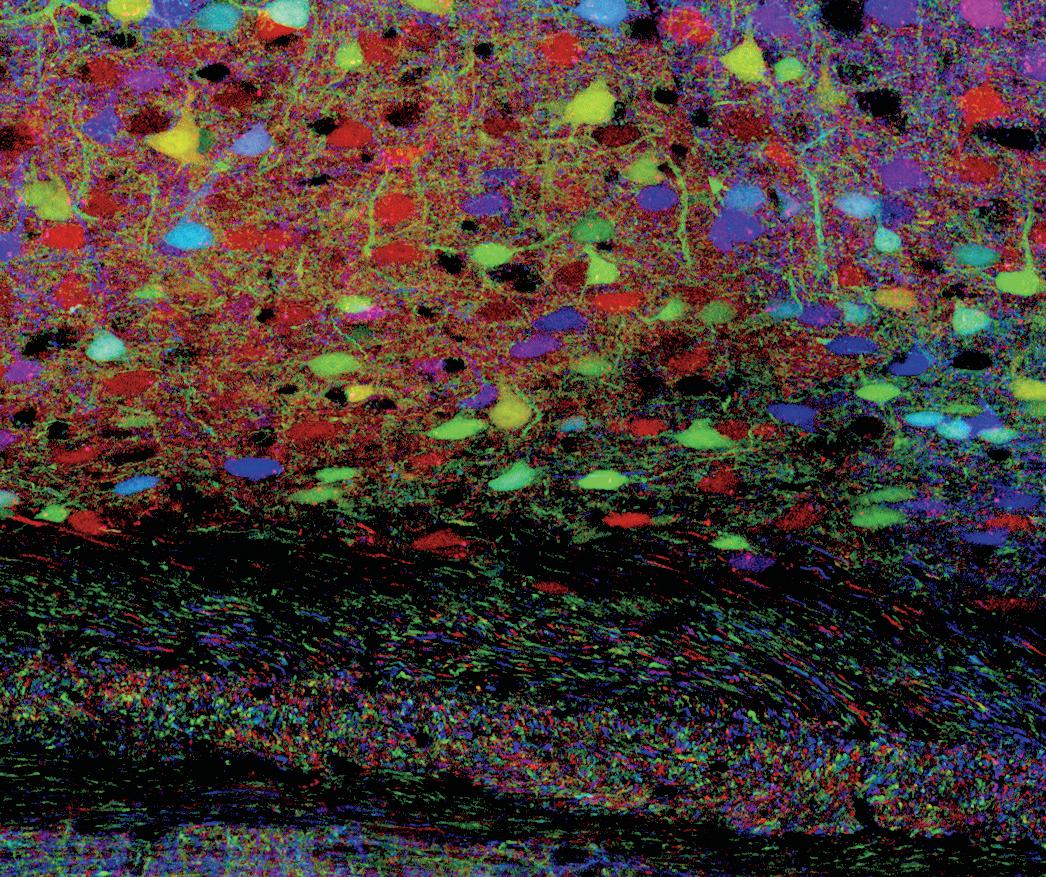
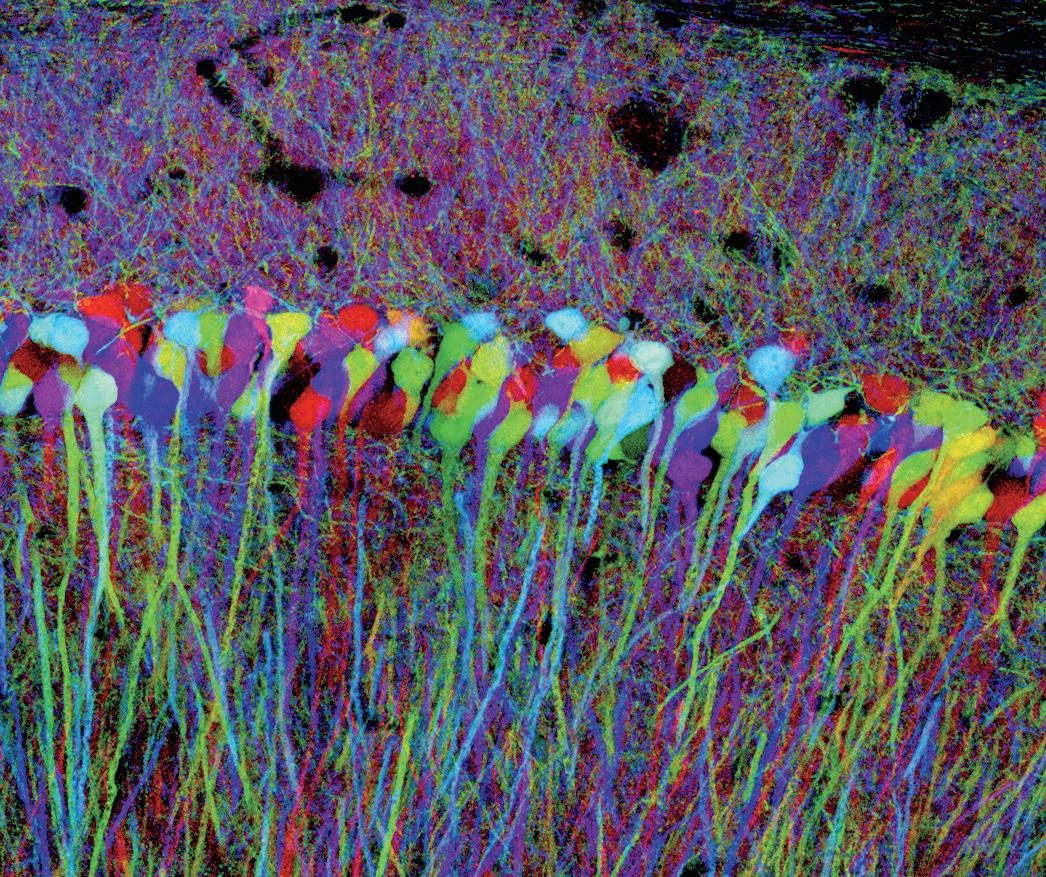
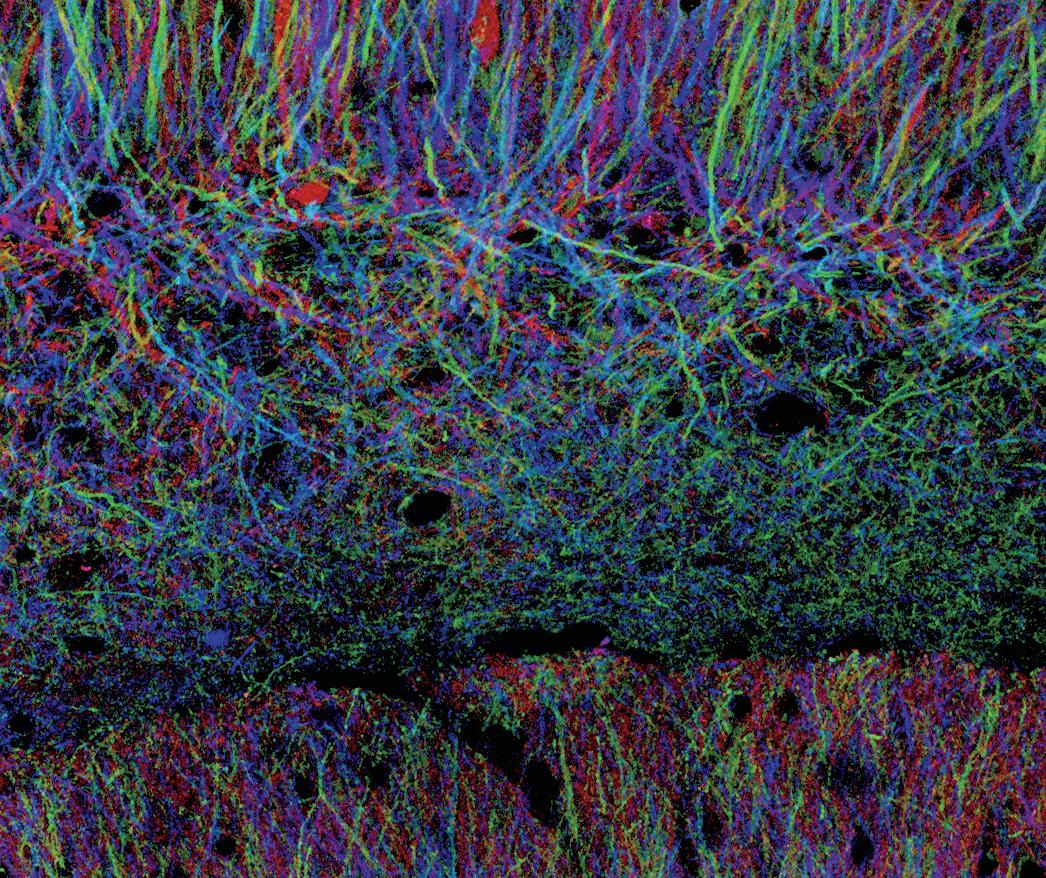
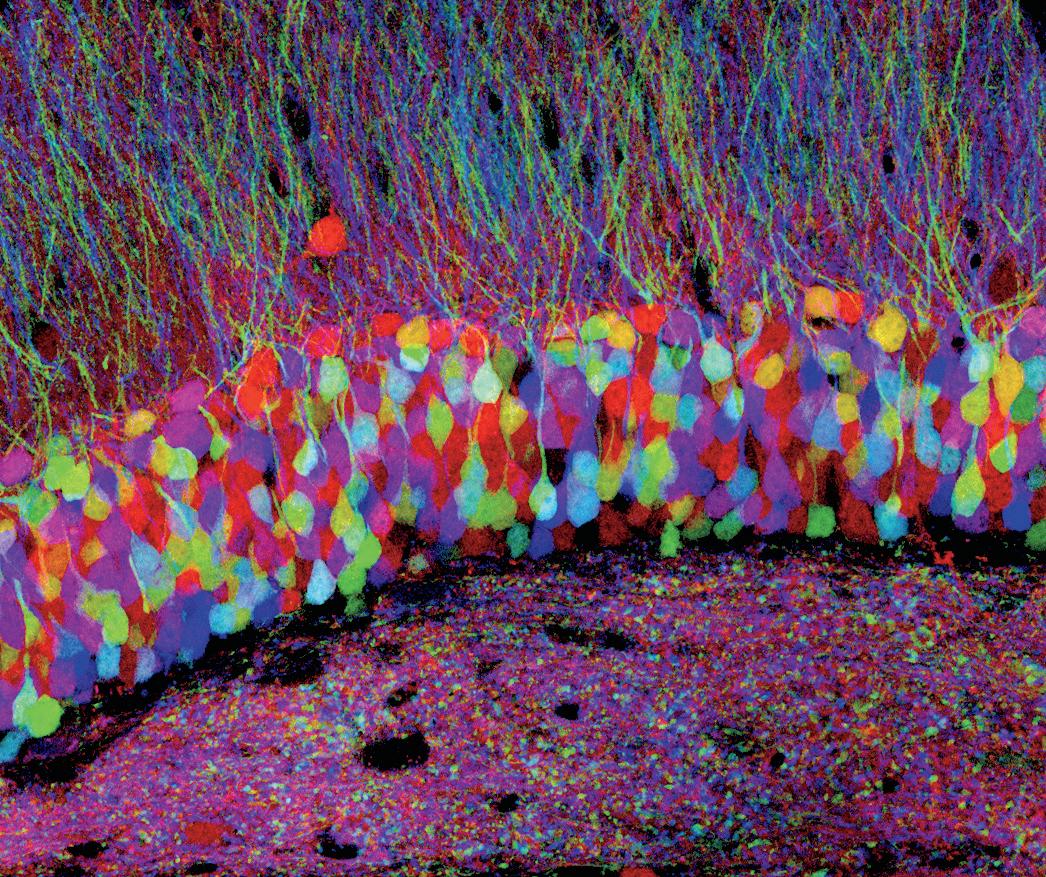

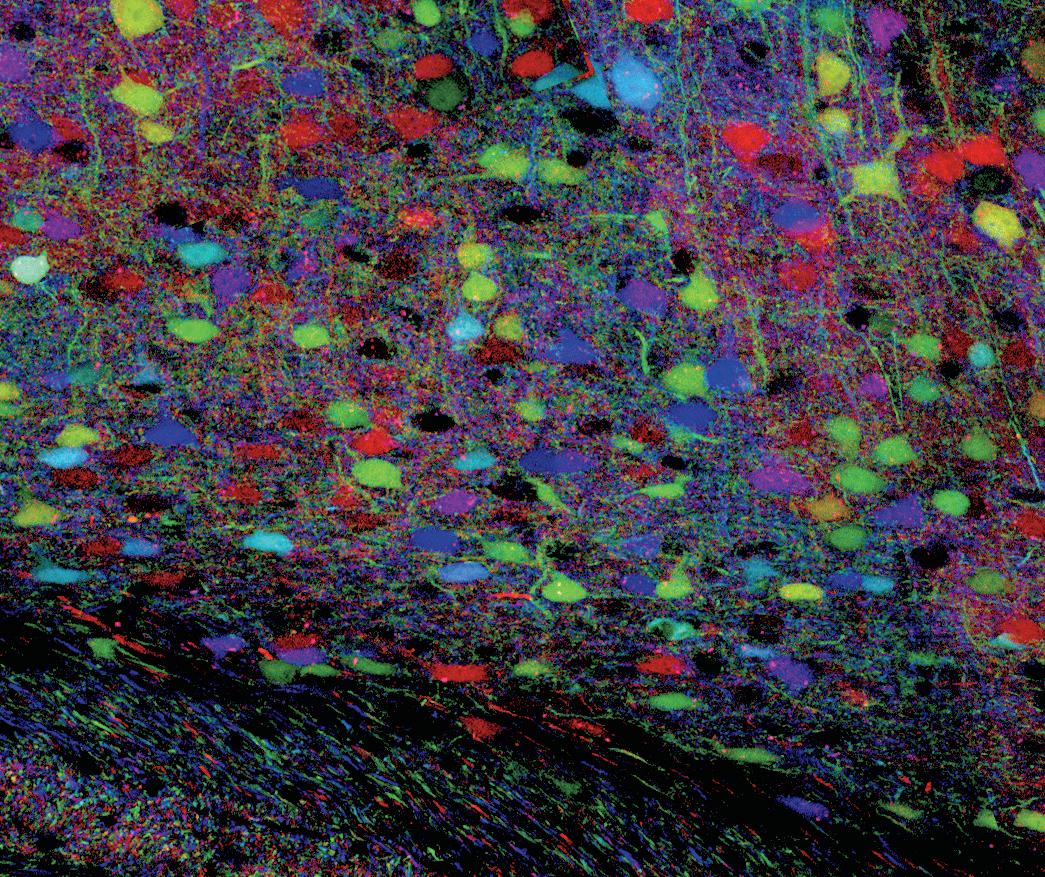

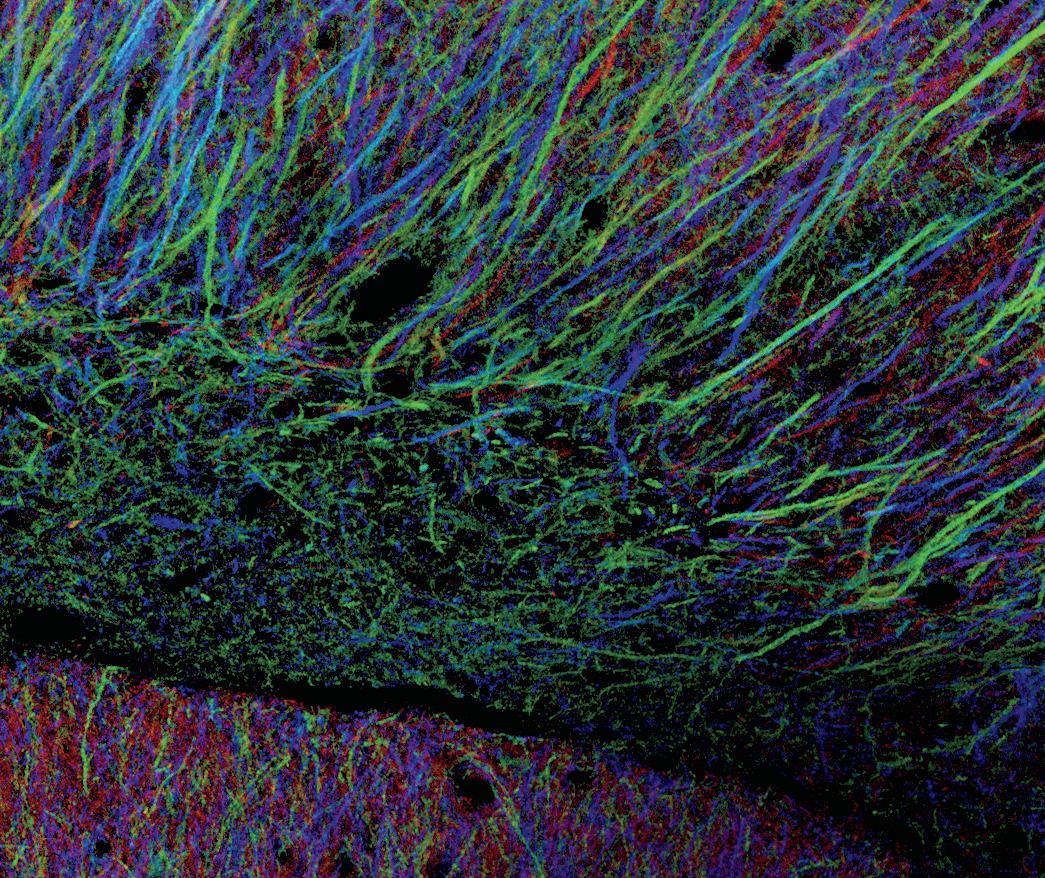
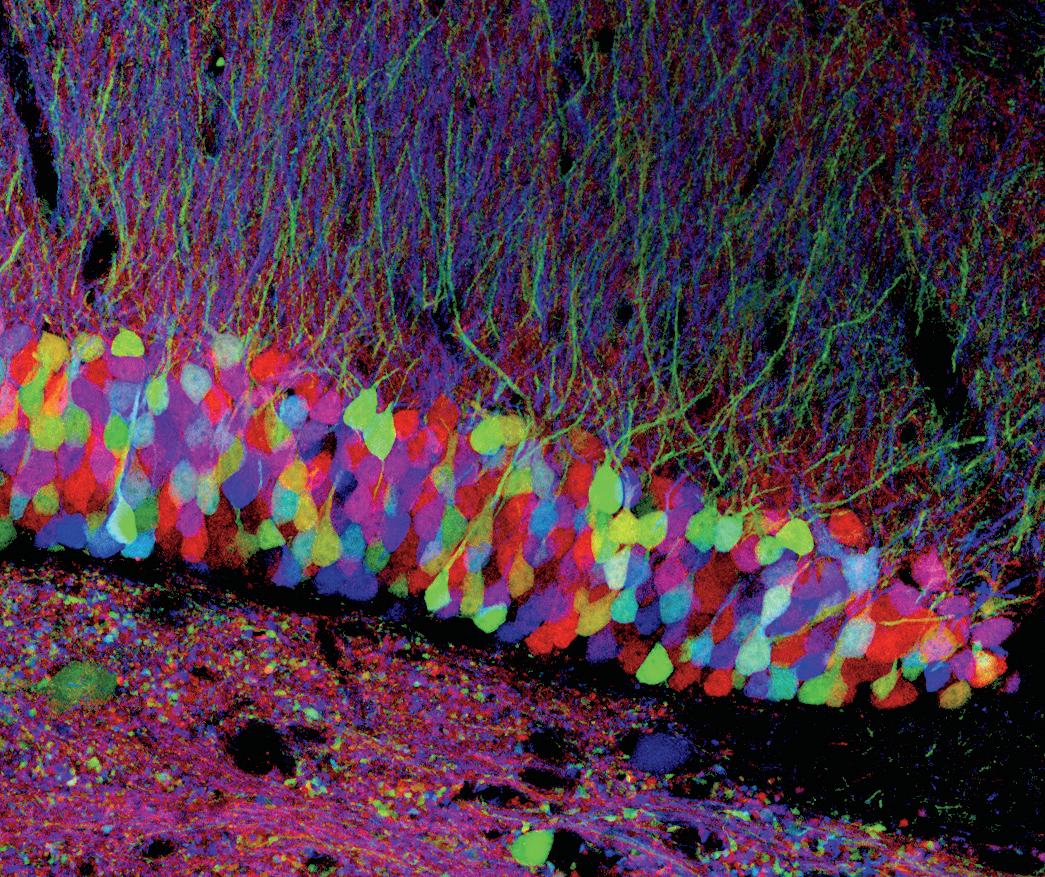














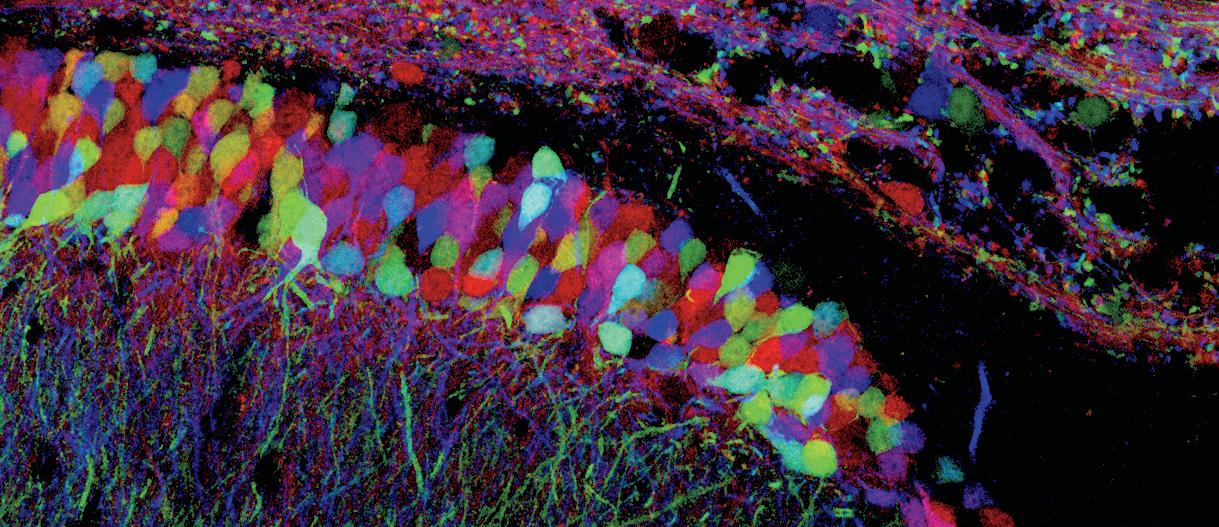


38 A Suitcase of Stories
Coach Charlie Butt’s remarkable journey from acclaimed athlete to legendary Bowdoin coach and squash champion began with a dramatic swim in a Chinese harbor. This summer, his daughter, Catie, published a book that tells his unlikely and impressive story.
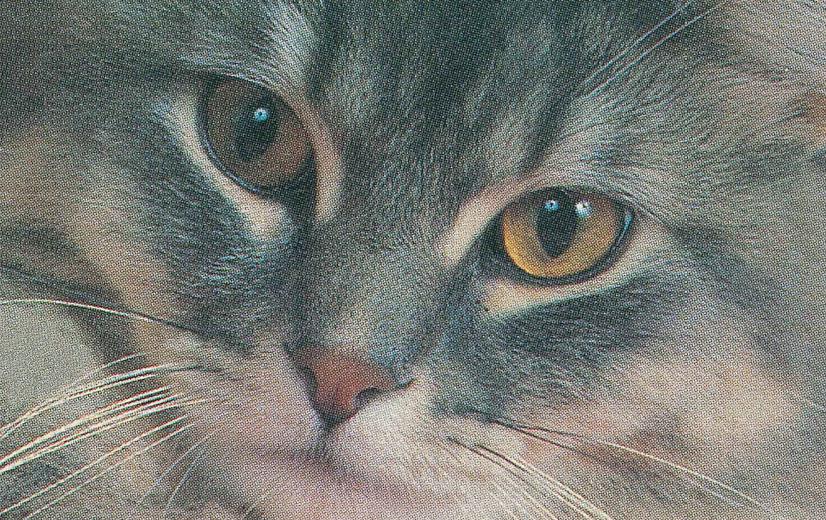
Professor Dallas Denery reveals a story from his life before academia that involves punk rock and a magazine for cat lovers.

22 The Brainbow Connection
As a kid, Jeff Lichtman ’73 wanted to examine the world. Now a neuroscientist, he is on a quest to map the brain.

After years of planning, Bowdoin is taking steps to preserve the legacy of the Pines. Much of it begins with life-giving light.
5 Sixty Years of Song: Piano instructor Naydene Bowder hits all the notes in recounting sixty years of teaching and learning through music.
7 Dine: Bowdoin Dining shares one of their many delicious vegetarian recipes, a portobello mushroom napoleon with a balsamic vinaigrette.
8 Fizz Biz: Bowdoin and Polar Beverages, the 143-year-old family business owned by Ralph Crowley Jr. ’73, share more than a mascot.
11 A Gift for Art: A gift has made possible an oral history with former—and first woman—museum of art director Katharine J. Watson.
15 Ultimate Road Trip Companion: An online road trip game “dropped by” student radio station WBOR this summer for more than 66,000 listener hours.

46 A Toolbox for Floods: Professor and expert on flooding Sam Brody ’92 on how communication and planning can shape a safer future.

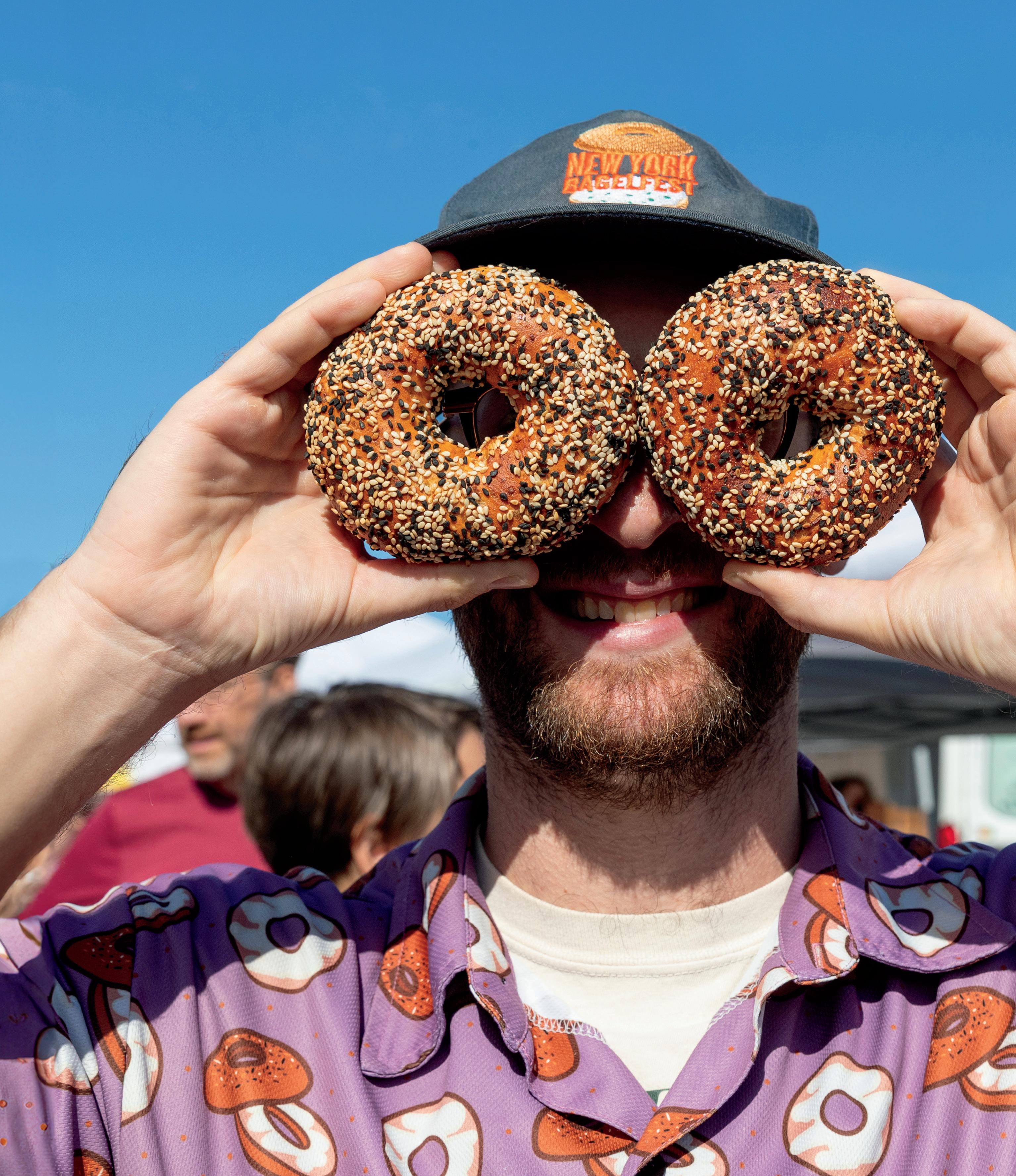
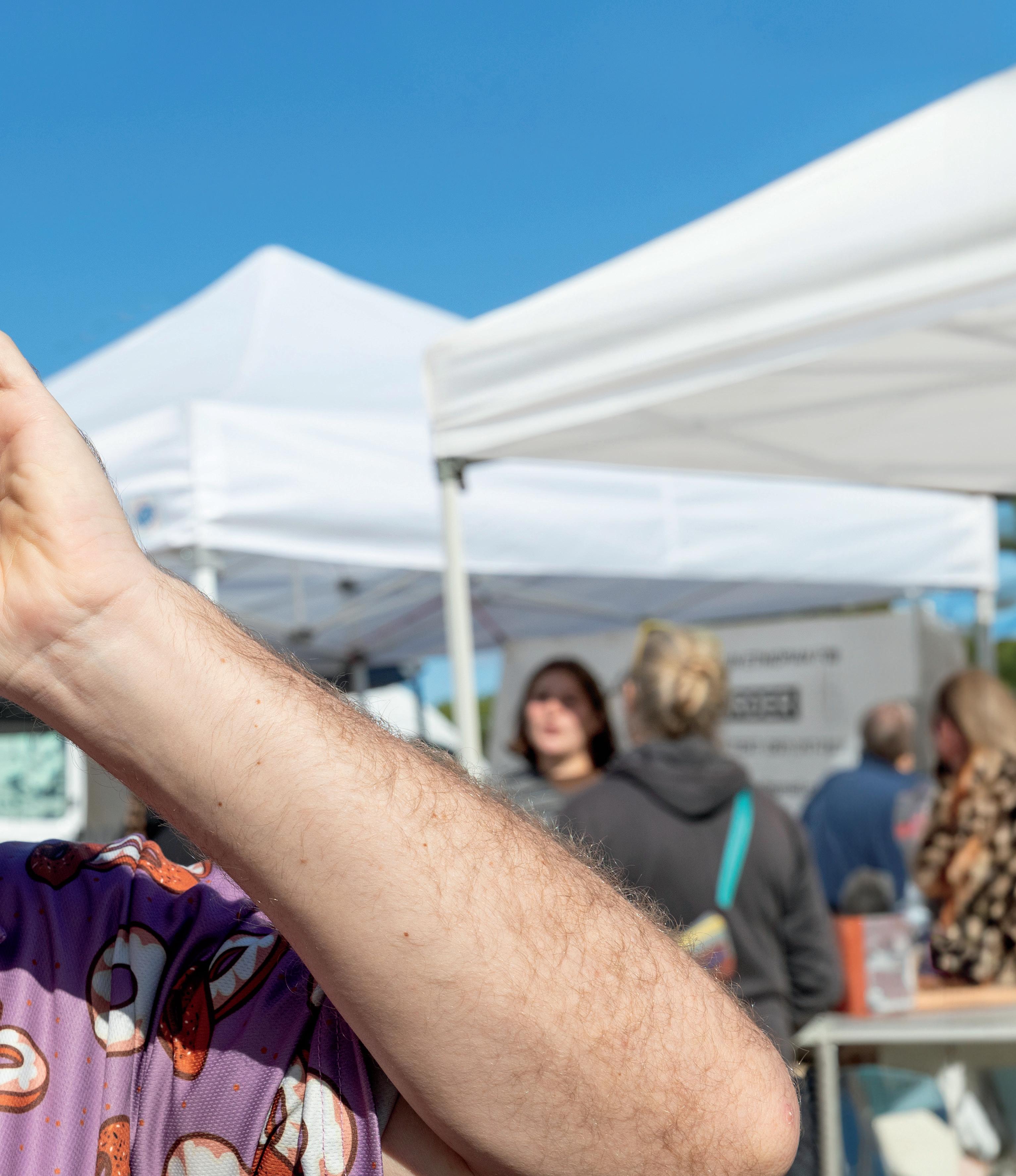
Smiles spread at Crystal Spring Farm in August as bagel lovers descended on the happy place that was the Maine Bagel Bake-Off. Sponsored by the Maine Grain Alliance, the invitation-only contest was the centerpiece of that weekend’s Brunswick Farmers Market. While bagel makers vied for the top prize with blueberry, garlic, and onion varieties, there was no denying a pervasive Bowdoin flavor to the event. Sam Silverman ’14 (pictured), known as New York’s “bagel ambassador” for having founded BagelUp, the company behind NYC Bagel Tours, the New York BagelFest, and a growing number of bagel-centric experiences, was part of the judging panel—alongside Tristan Noyes ’05— and the best bagel award went to Jeff Mao ’92, founder of Knead and Nosh in Brunswick.
YOUR MULTIDISCIPLINARY essays in praise of uncertainty (“No Doubt,” Spring/Summer 2025) addressed a central idea that has emboldened my professional practice in classrooms, courtrooms, and chapels, as well as in my family relationships. The idea is that, contrary to our cognitive preference for certainty and simplicity, the natural way of things is uncertainty. So, let’s embrace it, rather than erase it.
The teenage student seeking the “right” answers; the discerning juror seeking a verdict beyond a reasonable doubt; the penitent prayer seeking an answer to life’s essential questions— all are influenced by the age of reasoning, its pursuit of certainty, and its elusive effort to eliminate doubt.
And yet, it is the hard science of nuclear physics that has given us Walter Heisenberg’s uncertainty principle. I’m no physicist, but my understanding of the Heisenberg principle is that electrons continuously revolve around the nucleus of each atom. Their position can never be fixed in a certain position, since revolutionary motion is their natural way of being.
The recent popular movie Heisenberg tells of the explosive consequences of nuclear bombs when we manufacture the cessation of atomic revolutions. Heisenberg’s uncertainty principle
I was intrigued with your “Juicy Couture” article on alumna Ruthie Davis ’84 and her luxury high-heeled footwear. Her collaboration with Cassidy and Kelsey Tucker in their support of the Detroit youth community is to be celebrated. However, as a podiatrist and public health practitioner, I caution your readership when considering the Candy and Yardley spiked heels of six and four inches. One needs to condition themselves with appropriate break-in periods
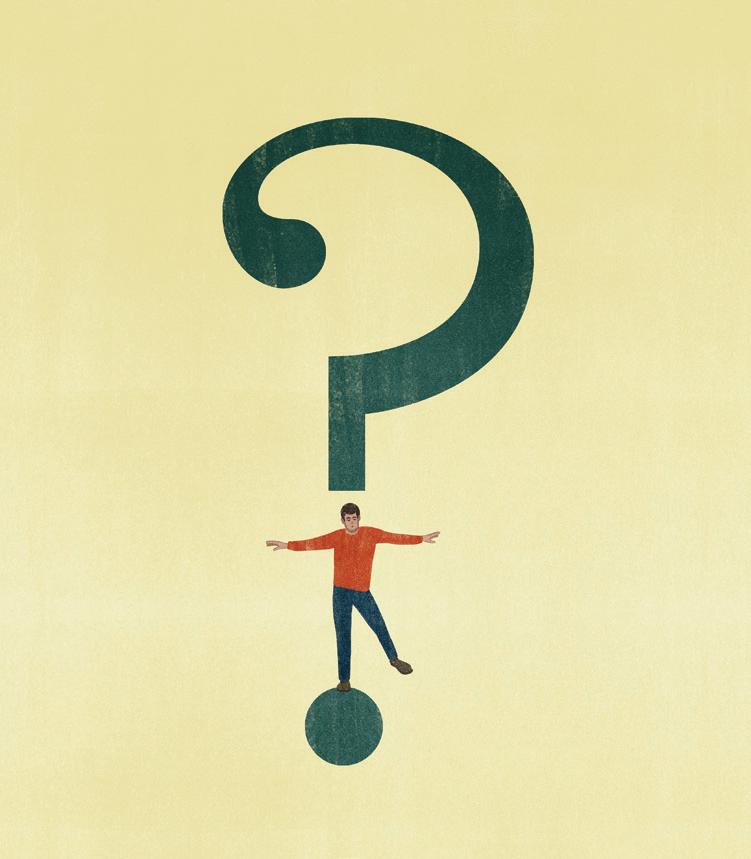
suggests that the basis of matter is uncertainty. It’s interesting to infer that the basis of what really matters may also be uncertainty.
Bowdoin’s liberal arts curriculum that encourages students to explore diverse disciplines nurtures this foundational understanding of the revolutionary principle of uncertainty.
Thank you to the authors and editors for making a compelling case in praise of doubt. Certainty is often overrated!
Chris Kraus ’82
and practice of heel-toe walking prior to initiating this level of high-heeled shoes. Not for the novice and never without risk.
James J. DiResta P’99
One of my book club members sent me this [Ed.: after reading Matt’s essay, “The Sure Thing,” in the feature about uncertainty in Spring/Summer 2025]: The “monkey Shakespeare” concept, stemming from the
Infinite Monkey Theorem, is mathematically debunked as practically impossible within the universe’s current lifespan. While the theorem states that an infinite number of monkeys typing randomly for an infinite amount of time would eventually produce any given text, including Shakespeare’s works, studies have shown that, even with all living chimpanzees typing constantly, it would take longer than the universe’s estimated lifespan to achieve this.
Matt Bitonti ’00
MAGAZINE STAFF
Editor
Alison Bennie
Designer and Art Director
Melissa Wells
Managing Editor
Leanne Dech
Senior Editor
Doug Cook
Design Consultant
2Communiqué
Contributors
Adam Bovie
Jim Caton
John Cross ’76
Cheryl Della Pietra
Trevor Geiger
Rebecca Goldfine
Sophaktra Heng
Scott Hood
Micki Manheimer
Martin Mbugua
Janie Porche
Tom Porter
On the Cover: Brainbow image courtesy of Lichtman Lab/Harvard (front). Slices of brain in a petri dish by Jared Leeds (back).
BOWDOIN MAGAZINE (ISSN: 0895-2604) is published three times a year by Bowdoin College, 4104 College Station, Brunswick, Maine, 04011. Printed by Penmor Lithographers, Lewiston, Maine. Sent free of charge to all Bowdoin alumni, parents of current and recent undergraduates, members of the senior class, faculty and staff, and members of the Association of Bowdoin Friends.
Opinions expressed in this magazine are those of the authors.
Please send address changes, ideas, or letters to the editor to the address above or by email to bowdoineditor@bowdoin.edu. Send class news to classnews@bowdoin.edu or to the address above.
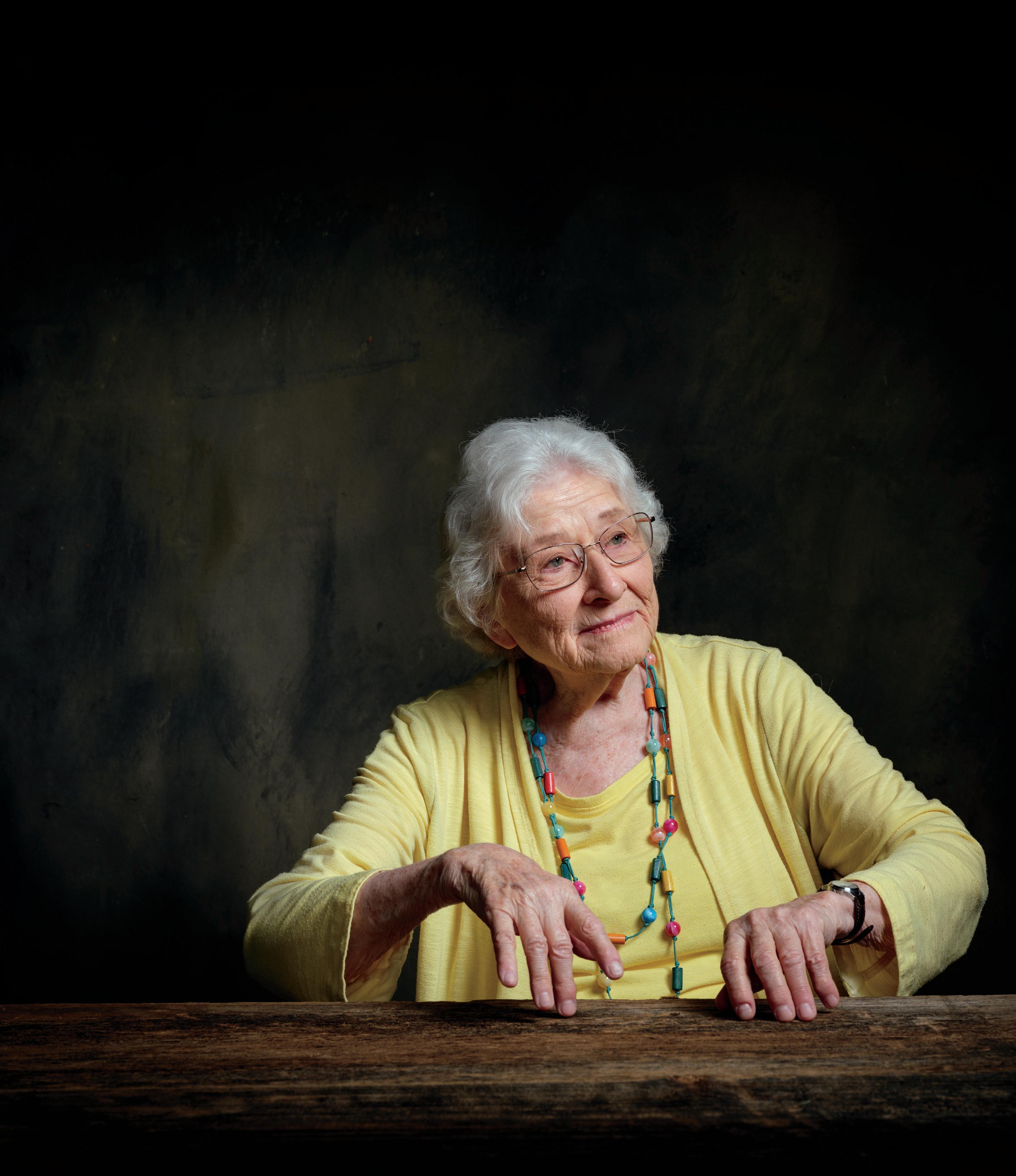
NAYDENE BOWDER CLASSICAL PIANO AND HARPSICHORD INSTRUCTOR
In 1939, every Saturday my mother would take me to WGAN in Portland where they had a children’s talent show, and I would sing on the radio. Somewhere there’s a recording of me at two singing, “Climb up my rainbow, slide down my cellar door, and we’ll be jolly friends forevermore.”
My first day at Juilliard, I was in saddle shoes and a plaid skirt, and there was a girl in front of me in line in the same; everybody else was in concert black. We started talking, and she said, “You sound like a Maine lobsterman,” and I said, “You sound like a Kennedy.” It turned out to be Dianne Goolkasian Rahbee, a wonderful composer—my piano students have won competitions all over the world playing her pieces. I was home in Maine in 1962 after getting my degree, and [Professor of Music] Bob Beckwith said, “I’ve got two or three boys down here at Bowdoin who want to continue piano. Could you come and give them lessons once a week?” That was the beginning of sixty years teaching here.
There’s a huge difference between Bowdoin before the ’70s and after. It’s been chaotic but so colorful—we don’t just have red, yellow, and blue, but everything in between, and we can mix and match as we choose. It’s fantastic.
I remember, with a couple of buddies from Girl Scouts, wondering if we would live to be sixty. I thought, “Make the most of it,” you know? I feel like a child. I hope I never grow up. I would wish for every student I teach, for every child I raise, for every person in the world, to find what they love. Love is what it’s all about.
The most wonderful thing I’ve discovered is this never stops. I’m not done yet! I will say, if the people we are leaving this country to are represented by students I have contact with at Bowdoin, I will leave this world very confidently.
For more from this interview, visit bowdoin.edu/magazine.
The teddy bear may have been created in honor of President Theodore Roosevelt, but it’s a polar bear from Robert Peary that lies in a place of honor at his “Summer White House.”
PRESIDENT Theodore Roosevelt famously advocated for speaking softly and carrying a big stick. On the home front at Sagamore Hill, his “Summer White House” in Oyster Bay, Long Island, a rather ferocious-looking polar bear rug still speaks volumes, representing admiration and gratitude from none other than Arctic explorer Robert Peary, of the Class of 1877.
Across the foyer from Roosevelt’s home office, the rug is splayed—head reared back with teeth bared—in a parlor that, according to National Park Service tour guides, served double duty as a sitting room for Roosevelt’s second wife, Edith, and as a waiting area for those meeting with her husband during his roles as governor of New York and then vice president under President William McKinley before he assumed the presidency after McKinley’s assassination.
“Peary was generous in giving souvenirs to his sponsors and supporters,” said Genevieve LeMoine, curator and registrar at the PearyMacMillan Arctic Museum.
President Roosevelt openly supported Peary’s efforts and was instrumental in arranging for his leave of absence from the US Navy so that he could continue his Arctic explorations.
Following a failed 1902 attempt to reach the North Pole, blamed on the limitations of using chartered ships, Peary set a course for a more capable ship and, with public support from the country’s twenty-sixth president, was able to muster the funds to begin construction of what he would name the SS Roosevelt
When Peary’s first attempt with the new vessel in 1906 again fell short of his goal, the Roosevelt
limped home badly damaged by ice, but Peary was undeterred, and his relationship with the president was as warm as ever.
Having made repairs to the ship, Peary stopped to visit Roosevelt on his way back to the Arctic in July 1908. A glass lantern slide in the Arctic museum’s collection captures an image of the explorer and president shaking hands, both decked out in white suits and hats.
The following spring, Peary made his successful trek. He sailed as far north as possible, to Cape Sheridan on the northeast coast of Canada’s Ellesmere Island, froze the Roosevelt into the ice, and used her for a base of operations as he and his team of Westerners and Inughuit used dog-drawn sledges to get to the North Pole.
It’s unclear at what point Peary gifted Roosevelt the rug, but we do know what happened to the ship that gave rise to that gesture of gratitude. When the Roosevelt was no longer useful to Peary, it was used for commercial shipping and, on one such journey, ran aground near the Panama Canal, where it remains on the ocean floor.


Professor of English Aaron Kitch has a special scholarly interest in William Shakespeare. He also has a side-hustle as a rock musician—chances are you’ve seen him in the ’80s cover band Racer X on campus. Kitch’s latest musical project is a departure from both. True Believer, available on a range of streaming platforms, is a concept album set in the Nevada desert around the fictional utopian community of Nazareth. Characters include a pair of charismatic preachers, a recovering alcoholic, an exotic dancer, and a queer teenager. The plot features, among other things, a doomed love affair, persecution by federal authorities, and an alien abduction. Kitch plays nearly all the instruments on the album, and he nods to his academic work by referencing Shakespeare’s Sonnet 43 in the song “Darkly Bright,” and there are other Bowdoin connections. The Meddiebempsters sing backup on the tracks “Testify” and “Fade Away,” and the album cover is the design work of art professor emeritus Mark Wethli.

Portobello mushrooms are actually the most mature version of the common white button mushroom, one stage above the cremini— all are part of the Agaricus bisporus family in different phases of development.
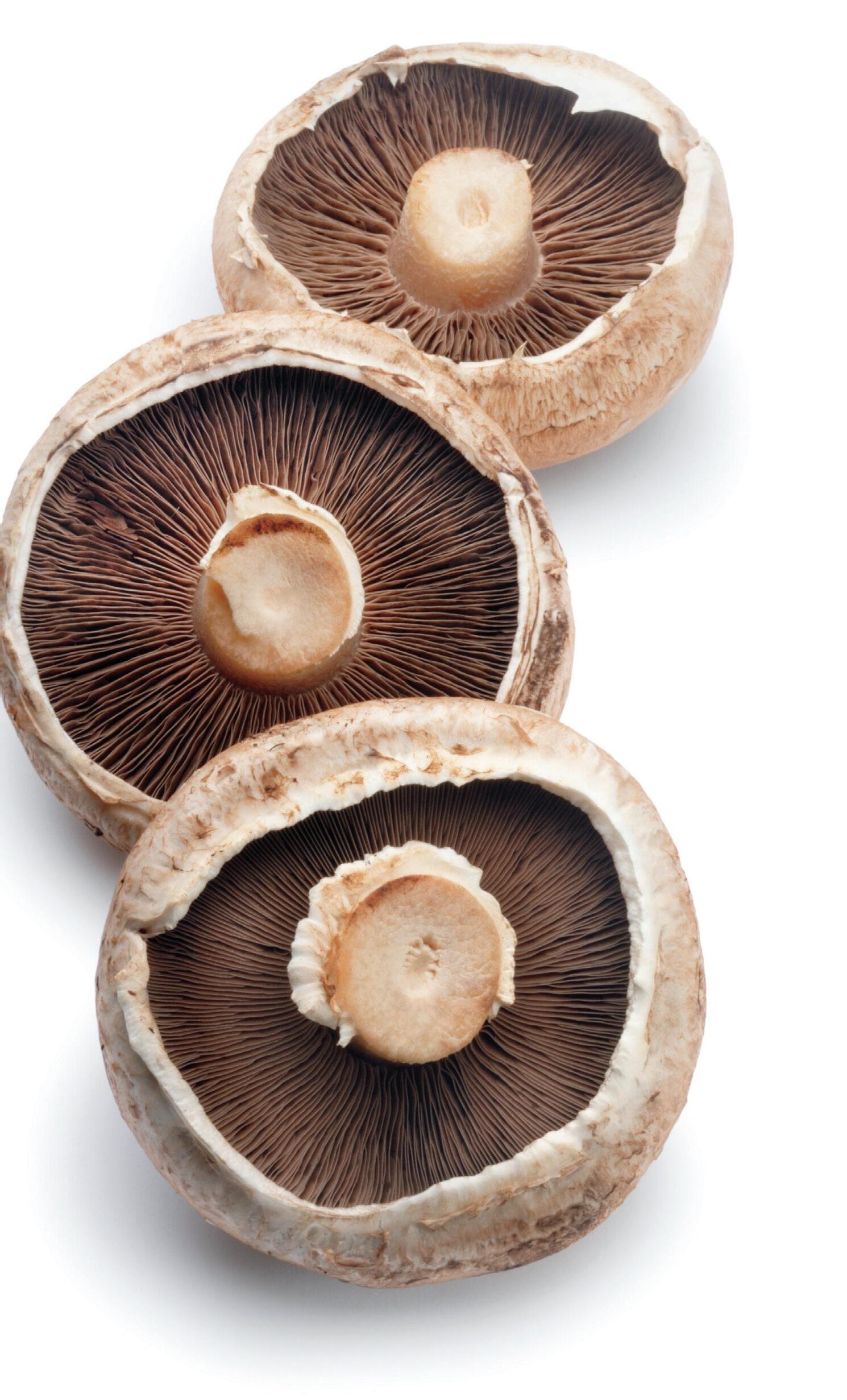

Recipe by Bowdoin Dining
This recipe makes a vegetarian side that looks fancy and tastes great. To make it a main dish, just make more!
1 tablespoon honey
1 ½ teaspoons Dijon mustard
¼ teaspoon salt
¼ teaspoon fresh ground black pepper
2 tablespoons balsamic vinegar
7 tablespoons extra virgin olive oil, divided
4 medium to large portobello mushrooms, approximately 8 ounces
8 thick slices summer squash, approximately 6 ounces
8 thick slices zucchini from a medium, approximately 6 ounces
4 thick slices red onion, approximately 4 ounces
4 medium slices tomato
12 medium slices fresh mozzarella from an 8-ounce ball
4 tablespoons balsamic vinaigrette (recipe at right)
4 ounces fresh basil, chopped or cut into chiffonade
Make the vinaigrette: whisk the honey, mustard, salt and pepper, balsamic vinegar, and three tablespoons of the olive oil in a small bowl. Set aside.
If using a grill or grill pan, brush the mushroom, summer squash, zucchini, and onion with the remaining olive oil on both sides. Grill over mediumhigh heat, turning once, so that each side is seared and the slices are softened but retain some structure. If using a skillet, heat the olive oil in the skillet (preferably cast iron) over medium-high heat and cook the mushroom, summer squash, zucchini, and onion, turning once and cooking the same way you would on the grill. Depending on the size of your skillet, you may have to cook the slices in batches so as to not crowd the pan and steam rather than sear them.
To build the napoleons, layer, starting with the mushroom, then alternating with the summer squash and zucchini, using two slices of each per stack. Place the stacks on a baking sheet or other oven-safe pan.
Top each stack with a grilled onion slice, a slice of fresh tomato, and three slices of mozzarella cheese. Drizzle each with a tablespoon of balsamic vinaigrette. Finish in the oven at 350 degrees for about 5 minutes or until the cheese is melted.
Top with the fresh basil and serve.
forced

Despite the mascot, Polar Beverages was not inspired by Bowdoin College. But a lot of other meaningful connections have bubbled up over the company’s long history.
Illustration by Jackson Gibbs
Polar Beverages, the largest independent sparkling beverage bottler in the country, has been in the Crowley family for 143 years. The company, based in Worcester, MA, began in 1882 as Crowley Ball Brook Straight Whiskey, when Dennis Crowley would hit the streets on payday, selling whiskey from a horse-drawn carriage for a dollar a bottle. Four generations on, his great-grandson, Ralph Crowley Jr. ’73, has led the company through tremendous growth and expansion as president and CEO since 1992. “Many of our friends assumed Polar Beverages borrowed the name and mascot from Bowdoin,” said Crowley. “Interestingly, the College became the Polar Bears in 1913 after Robert Peary visited the North Pole—Polar Beverages has had the name and mascot since 1882.” Ralph was the first in the Crowley family to attend Bowdoin, but there has been a steady stream since: Three of Ralph’s children attended—Kathryn ’02, who married Matthew McNeal ’02, Andrew “Dewey” ’09, and Sarah ’11; another daughter, Elisabeth, is married to Daniel McKinnon ’98. Crowley’s brother-in-law is Thomas McNamara ’78, and his nephew is Henry McNamara ’13. That’s a lot of Polar mixing!
The company introduced its polar bear mascot, Orson, in the 1960s, and a nearly twenty-five-foot version has waved to cars on I-290 from the roof of a company building ever since.
Polar is currently the official seltzer partner of
Crowley
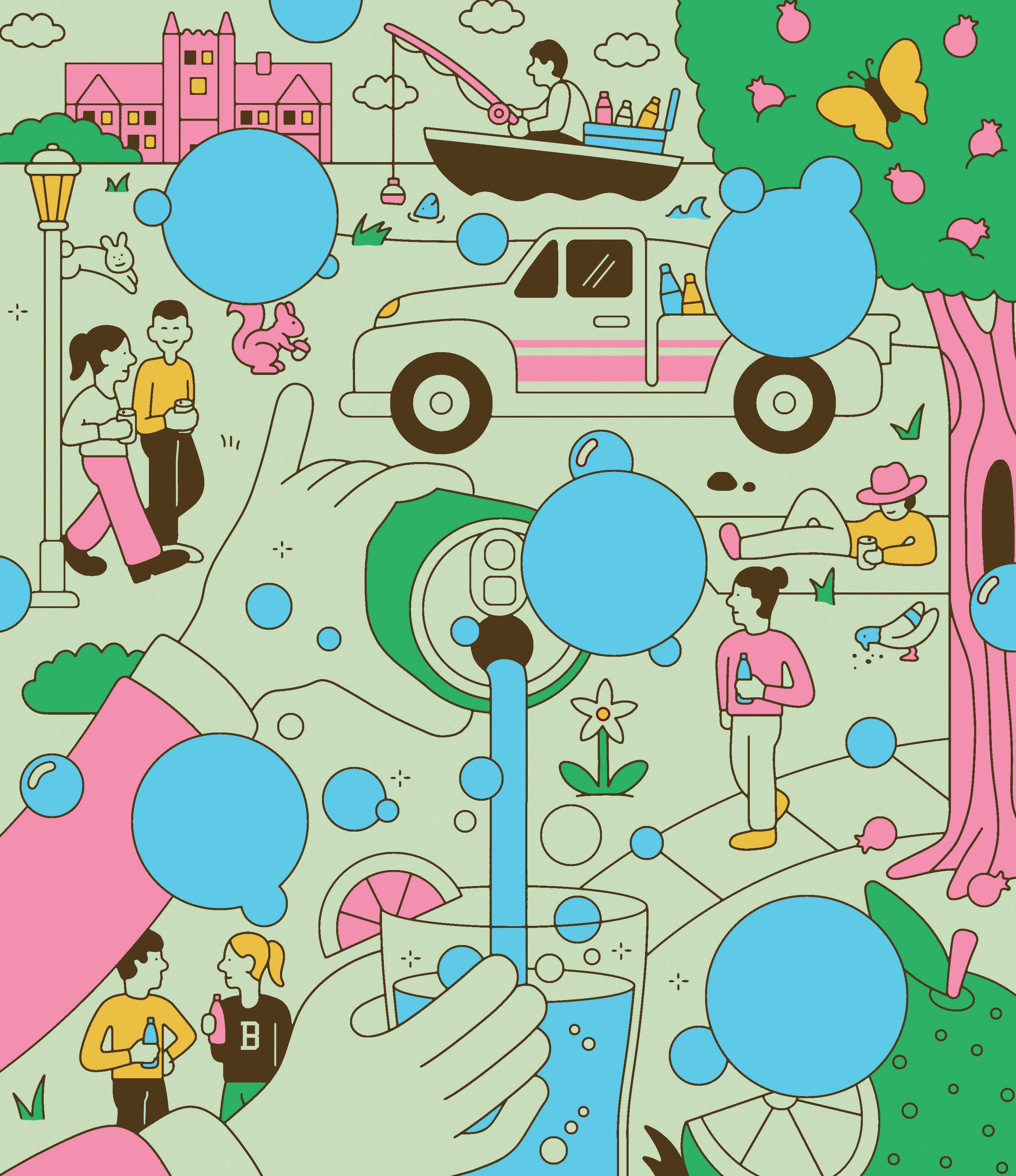
Following the wedding of Meghan Markle and Prince Harry in 2018, seasonal flavors included Vanilla Zen, “a resplendent recipe of noble vanilla with serene touches of pomegranate” that the company said was “inspired by our new American princess.”
As kids, Ralph and his younger brother Christopher sold bottles from the back of a truck at Holy Cross football games. Later, they worked the stadium, barking, “Get your ice-cold Polar beverages!”
America’s Test Kitchen named Polar Original Seltzer the best in its taste test of sparkling waters, and Slate was equally sparkly in its praise: “When a bottle of Polar tells you to expect a Ginger Lime Mule, brace yourself to be donkey-kicked in the tongue as hard as the flavor of a beverage with no added sweetener can possibly muster.”
Around Town
The scenic Dionne Farm, the last remaining piece of the original Crystal Spring Farm, is fitting into place.
IF YOU EVER ran or biked on Pleasant Hill Road during your time at Bowdoin or took the back way to Freeport, you probably remember the Dionne Farm, one of Brunswick’s most beloved rural landscapes.
It had been part of the larger, 356-acre Crystal Spring Farm purchased in the 1940s by Maurice Dionne, who, with his brother Bertrand, a veterinarian and member of the Class of 1937, operated a dairy operation that in its heyday sold locally popular Dee’s milk and ice cream. Maurice’s daughter Donna Dionne, a member of the Class of 1973, was the first woman named to Bowdoin’s Phi Beta Kappa chapter.
Keisha Payson, Bowdoin’s director of sustainability, rented an apartment on the property in the mid-1990s. “We got to spend three summers there” marveling at the views of the open fields and the bird life, she said. John Cross ’76, secretary of development and college relations,
has an even more personal connection. “In the span of four years, Dr. Dionne delivered my brother, my sister, and me at the Brunswick Community Hospital that he founded, formerly on the corner of Cumberland and Union streets in Brunswick.”
The farm is itself experiencing a kind of rebirth. Over the years, large parcels of the original property that had been sold off have been acquired by the Brunswick-Topsham Land Trust (BTLT), but one piece has long been missing—the twenty-five-acre homestead with the picturesque barn, atop of which sits the original Brunswick Town Hall clock, relocated in the 1960s before the town hall was demolished. In winter 2024, that final piece began to fall into place. A friend of the trust acquired the land and offered BTLT the gift of time to raise the funds to complete the original Crystal Spring Farm.
The seller, who remains anonymous, granted BTLT a two-year, private $2 million loan with the stipulation it be paid off by April 2026.
The trust met that goal early and is now planning a longer, more comprehensive campaign to fill a variety of needs, including moving the Saturday morning farmers market from its current location across the road to the Dionne Farm by early next summer.


Eww, David If you’re a little bit Alexis or find yourself “trying very hard not to connect with people right now,” you are clearly a fan of the television series Schitt’s Creek and may have caught a reference or two to a polar bear shot and wondered, why has this most enigmatic of potations been so cruelly withheld from the grand narrative that is my life? No need to pop a pill, cry a bit, and fall asleep early, bébé—we have the recipe. Mix equal parts peppermint schnapps and white crème de cacao and shake with ice for twenty seconds before straining into chilled shot glasses. It’s a cool and refreshing alternative to the banana rosé or anything else you might select at Herb Ertlinger’s fruit winery. For those wanting extra zing, a splash of vodka may also be added. You just fold it in.
Listen
In 1977, Katharine J. Watson joined the College as the first woman director of the Bowdoin College Museum of Art (BCMA), a post that she filled until 1998 and that at first also included directorship of the Arctic museum. Those twenty-plus years, which began not long into coeducation at Bowdoin, saw a great deal of change at the College and in the world. An anonymous donor wanted to capture Watson’s thoughts and stories for posterity and made a gift to provide an oral history. Watson sat for eight interview sessions with Edgar Allen Beem, freelance writer and author and former Maine Times art critic, last spring and spoke extensively of her career, artists and colleagues and exhibitions from her time at the BCMA, why art matters, her favorite work in the museum’s collection, and more.
Find them all on the library’s digital collections site at bowdo.in/katharine_watson.

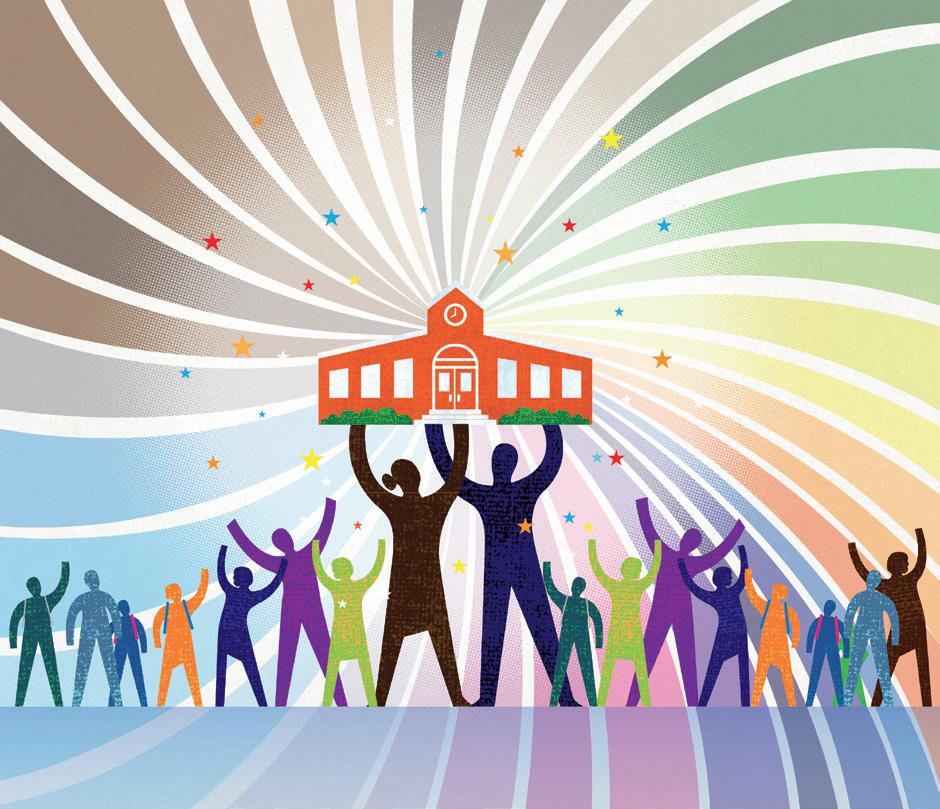
Safe Passage celebrated its twenty-fifth anniversary on September 25 in the First Congregational Church in Yarmouth, Maine, a location that reflects the organization’s ties to the state.
Yarmouth native Hanley Denning ’92 founded Safe Passage in 1999 to tutor children whose families made their living scavenging and recycling trash from a huge landfill in Guatemala City.
Since its founding—and continuing after Denning’s death in 2007 in a car accident—scores of people from Maine have contributed to its impact.
“Today we have over 10,000 individuals in our database from Maine,” said development director Rachel Meyn Ugarte. Hundreds of volunteers—including Bowdoin student and alumni groups—have traveled to Guatemala City to volunteer. Between 2003 and 2019, 160 Bowdoin students on fourteen alternative spring break trips worked with Safe Passage.
“The bridge from Maine to Guatemala is so tangible. That is something we want to celebrate with Mainers, whose foundational support was pivotal to Safe Passage’s success,” she added. Safe Passage now runs schools from early-childhood programs to ninth grade for more than 500 students, supporting them as they continue at local high schools. It will open a new middle school this winter.
Many program participants have inspiring stories. The first to graduate from medical school started a job this year at the city hospital. Another, trained as a mechanical engineer, is working at the airport. Safe Passage’s educational model could be an example for other communities, Meyn Ugarte said. “We’re working at the root of migration,” she added. “As these families are able to thrive in Guatemala, they don’t need to migrate to the US.”
Photographer Gordon Parks documented American life and culture from the 1940s into the 1970s. Born into poverty and segregation in Fort Scott, Kansas, Parks was inspired by photographs he saw in a magazine, bought his first camera at the age of twenty-eight, and became a self-taught photographer.
In January 1944, at the height of World War II, Parks photographed Herklas Brown, owner of the general store and Esso gas station in Somerville, Maine. Parks traveled to the state under the auspices of the Standard Oil Company to record its contributions to the war effort and to document the home front. His photographs chronicled oil and gas facilities and those who operated them, Esso gas station owners in small towns, and people whose work depended on fuel and other Standard Oil products. Consistent with his work before and after, Parks made it his mission to get to know his subjects and show their humanity. He photographed Brown at his Esso station, in his store, and with his family at the dinner table. Parks spent a month in Maine that winter and then returned in August to resume his work in the state. At a time when transportation, food, and lodging were a challenge, and notably as a Black man traveling alone, Parks nonetheless created a compelling documentary record of rural America that offers insight into this historic moment.
In partnership with the Gordon Parks Foundation, sixty-five of Parks’s photographs for this project are on view at the Bowdoin College Museum of Art in the exhibition Gordon Parks: Herklas Brown and Maine, 1944 through November 9, 2025.
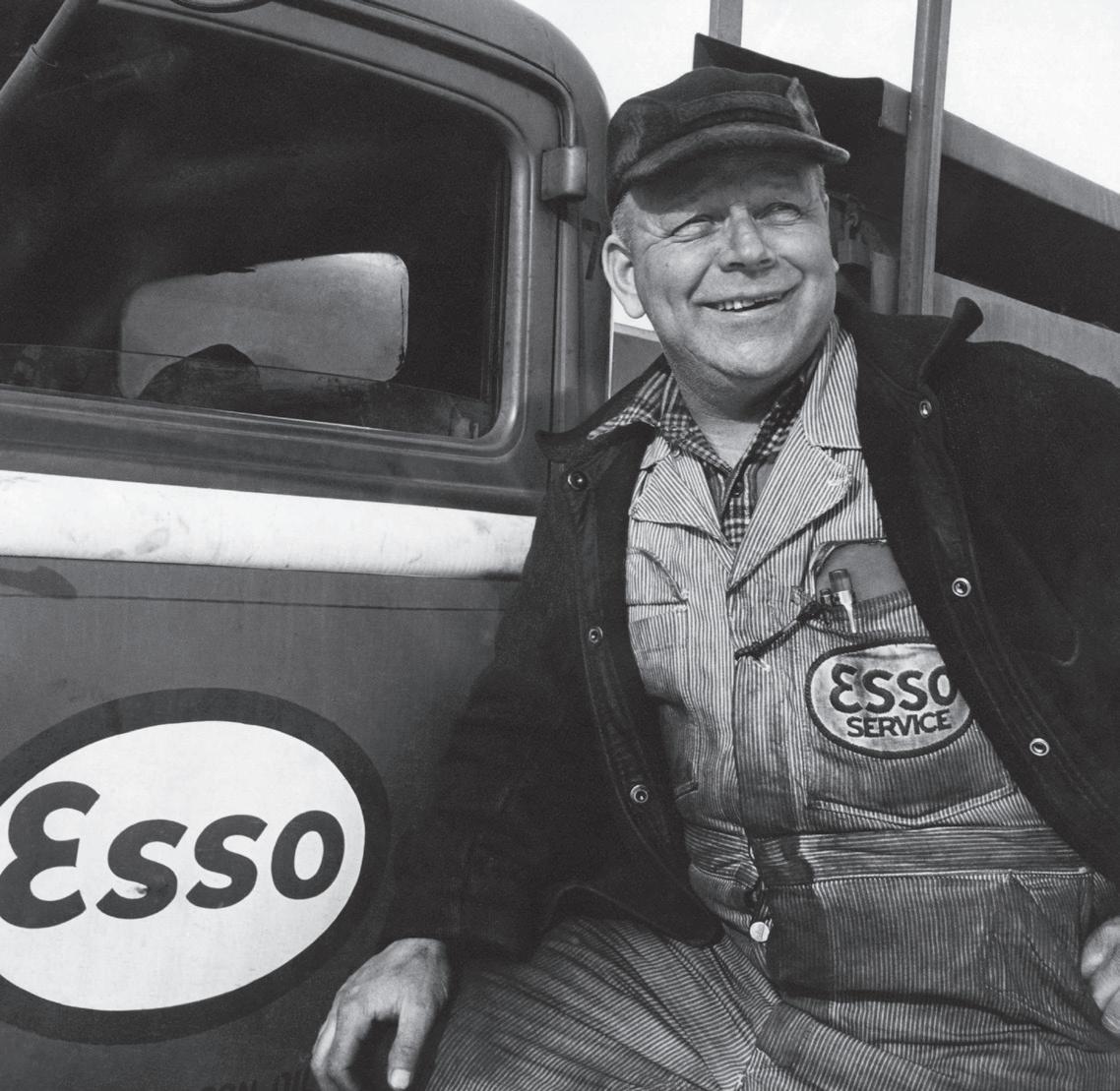
An employee of Standard Oil Company, Somerville, Maine, February 1944.
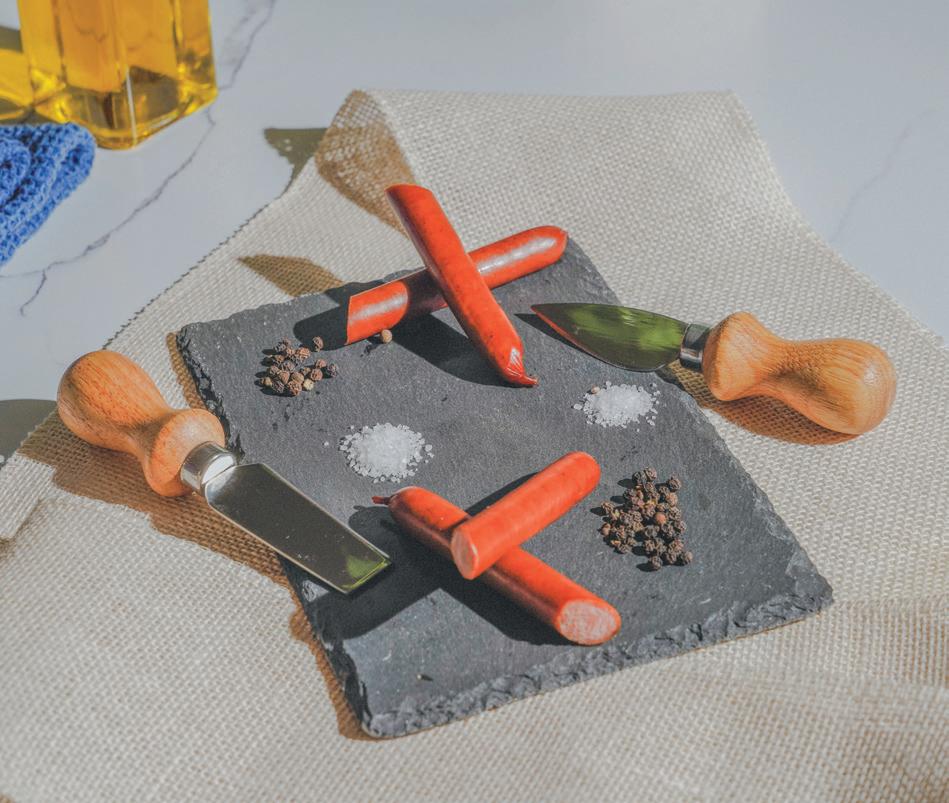
Alumni
An alumna and her husband were inspired by their roots in food and farming to create meat stick products they feel good about.
WHEN MOST PEOPLE think of meat sticks, “high quality” might not be the first thought that comes to mind. The Newcastle, Maine, farm Singing Pastures is on track to change that. Touting their Craft Meat Sticks as “the meat stick for people who don’t usually eat meat sticks,” Holly Jones Arbuckle ’91 and her husband, John, have set out to create a staple snack for clean eaters looking to sink their teeth into something natural. Their efforts have been rewarded, with their Roam Sticks products winning several awards at competitions both at home in Maine and across the country. The pasture-raised pork stick took home the $25,000 first prize on the reality TV show Greenlight Maine, in which Maine entrepreneurs make innovative business pitches to a panel of judges. They also won the $5,000 prize at the Naturally New England Pitch Slam Competition, which focuses on businesses specializing in natural products. That prize came with an invitation to the national competition Naturally Rising, where Singing Pastures won an Emerging Impact Award. Continuing to innovate, they have recently added grass-fed bone broth and collagen to the sticks. Celebrating their wins, Holly dispelled the idea of “rugged individualism in farming,” saying, “If you are successful at anything, someone helped you”—an inspiring message in what may be an unexpected package.

Campus bikeshare bicycles have a new look this year. The seven Bowdoin bikes, custom-made by Priority, have three speeds, fenders, and a rubber chain to prevent snags and grease stains. After completing a quick online safety course, students can check them out at the library circulation desk and then grab them at a special bike rack just outside. Bikes are trackable in case of any problems, and they must be returned by the time the library closes. Each includes a lock and a basket for trips into town and comes with a collapsible helmet— and some strong encouragement to use it.

Master luthier Dana Bourgeois ’75 is celebrating two big anniversaries this year— his fiftieth Bowdoin College reunion and fifty years in the business of building guitars. While the first brought him back to campus last May to reconnect with old friends and colleagues, the second milestone is being commemorated with the release of a 50th Anniversary Collection from his namesake, Bourgeois Guitars. Already a specialty business, producing around 400 instruments by hand each year, Bourgeois’s 50th Anniversary Collection is limited to just twenty-five guitars worldwide. Based on his iconic Soloist model, these anniversary instruments honor Bourgeois’s artistry, blending classic design with the innovative techniques that mark his half-century of craftsmanship.
Bourgeois unknowingly launched his career during his junior year at Bowdoin, when he built his first guitar, working out of his room in the fraternity now known as Quinby House. “It was crude. But it worked,” he said. Within a few years, he had opened a shop in Brunswick and earned a reputation as a skilled guitar repairman. But his love of learning, perfectionism, and deep respect for traditional guitar-making didn’t let him stop there. Five decades later, Bourgeois produces some of the highest-quality instruments on the market, with guitars famously played by Doc Watson, Natalie Maines, Luke Bryan, Ry Cooder, Sierra Hull, and many more. Still living in Brunswick, he commutes each day to his shop in Lewiston, Maine, where he continues to oversee the production of every guitar.
As Jane Austen’s 250th birthday approaches, English literature scholar Ann Kibbie says the great novelist’s real message goes beyond the world of love and romance.
THIS YEAR marks a landmark anniversary for fans of one of the greatest English language novelists. Jane Austen, who wrote about the lives and loves of the British landed gentry from the female perspective, was born on December 16, 1775. Those fans include Associate Professor of English Ann Kibbie, who teaches Austen and whose scholarship includes representations of money and capital in early modern literature. Kibbie says her favorite response to Austen’s work comes from the twentieth-century poet W. H. Auden. “He wrote that, despite the image of Austen as a prim and proper spinster, ‘You could not shock her more than she shocks me.’ What did he consider so shocking? Her focus on that most forbidden of subjects, not romance but money,” asserts Kibbie.
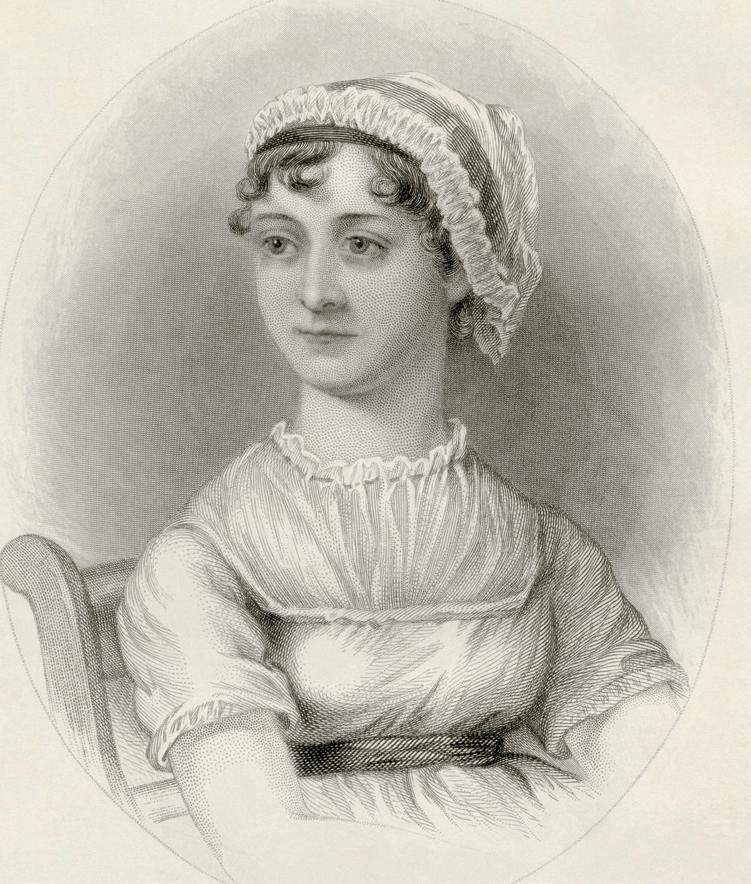

The summer road trip is a staple of Americana. Since the early twentieth century, the idea of loading family and friends into a car or camper to find out where the road takes you has symbolized discovery, freedom, and fun. In a new, online era, this kind of adventure can happen anytime and take you anywhere—including the headquarters of WBOR, Bowdoin College’s student radio station.
That’s where participants in the online game “Internet Roadtrip” found themselves earlier this year. The game uses Google Maps to put players in collective control of a virtual vehicle on a digital road trip by having them vote frequently on which direction to “drive,” whether to honk the car’s horn, and even what to listen to on the radio—a choice that depends on what actual stations are in range of their position on the map. In Maine, WBOR was frequently the station of choice, with the crew reporting 121,946 unique listeners during May and June—the road trip’s
peak period—for a total of 66,176 listener hours. Many of the players developed a friendly rapport with the student DJs at WBOR, who had noticed the unusual influx of new listeners and decided to connect with them by giving out travel advice and taking song requests. The result was a playful kind of cult following, with many players changing their screen names and making memes to express their newfound love for the station.
On the day the car “dropped by” the WBOR station office, DJ Janet Briggs ’25 was there to greet the players with classic French jazz—and a classic internet prank: “WBOR is rickrolling us,” wrote one player as they liveblogged the experience. (“Rickrolling” is when a link seems to take you one place but actually leads to the music video for Rick Astley’s 1987 song, “Never Gonna Give You Up.”) While the trip eventually took the players outside of the station’s range, many collaborated on a parting gift befitting an institution as characterful as WBOR: a collage of doodles, well-wishes, and praise for their new favorite radio station.
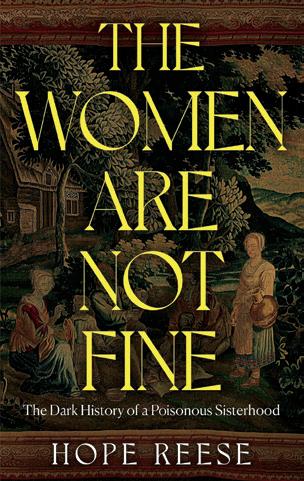
The Women Are Not Fine: The Dark History of a Poisonous Sisterhood
HOPE REESE ’06 (Brazen Books, 2025)
The poor and abused women of Nagyrev were desperate. Midwife Zsuzsanna Fazekas offered them a solution: arsenic. Journalist Reese pieces together archival records and the work of historians, sociologists, and psychologists to write not just a crime story but a timely, haunting exploration of what happens when women’s suffering goes unanswered.
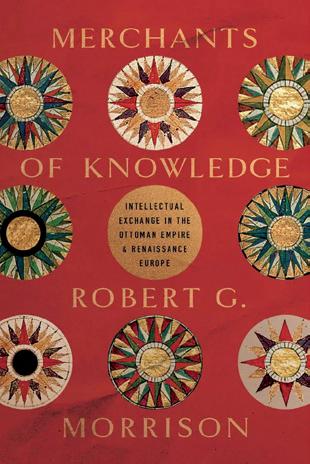
Merchants of Knowledge ROBERT G. MORRISON
George Lincoln Skolfield Jr. Professor of Religion and Middle Eastern and North African Studies (Stanford University Press, 2025)

The
You Forget CHRISTOPHER
’82 (Subplot Publishing, 2025)

I Am No Guide: Pearl Jam Song by Song BRIAN STIPELMAN ’99 (Fonthill Press, 2025)
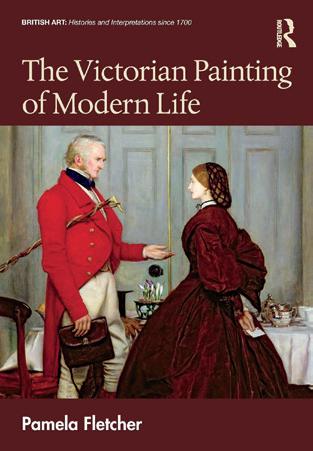
PAMELA M. FLETCHER ’89
Edith Cleaves Barry Professor of the History and Criticism of Art (Routledge, 2025)
28
15
By the Numbers
Each May at Bowdoin, the student body undertakes a collective spring cleaning. Dorm rooms are emptied of personal items to make way for the next occupants. Graduating seniors sift through their belongings to see what they’ll take with them and what they’ll part with.
To meet this tsunami of everyday objects, Bowdoin’s Sustainability Office ramps up its Give and Go recycling program to ensure as little as possible goes to waste. The office’s staff and student team takes on the task of collecting and sorting stuff for Goodwill or for Bowdoin’s Freecycle program.
If Give and Go is Bowdoin’s great purge, Freecycle is its great accumulation. In early June, gently used items for dorm rooms, kitchens, and common areas are organized and displayed at 10 Cleaveland Street, where summer students can peruse the free wares—like plates, desk lamps, and cutlery—and take what they need. In late August, Freecycle opens to first-years, international students, and transfer students, and then to students in all other class years.
28
34
200
35,400
Pounds of
5
Approximate number of
3,000
850
Items available for taking, including 135 plates, 130 desk lamps, 122 pots and pans, and 112
535
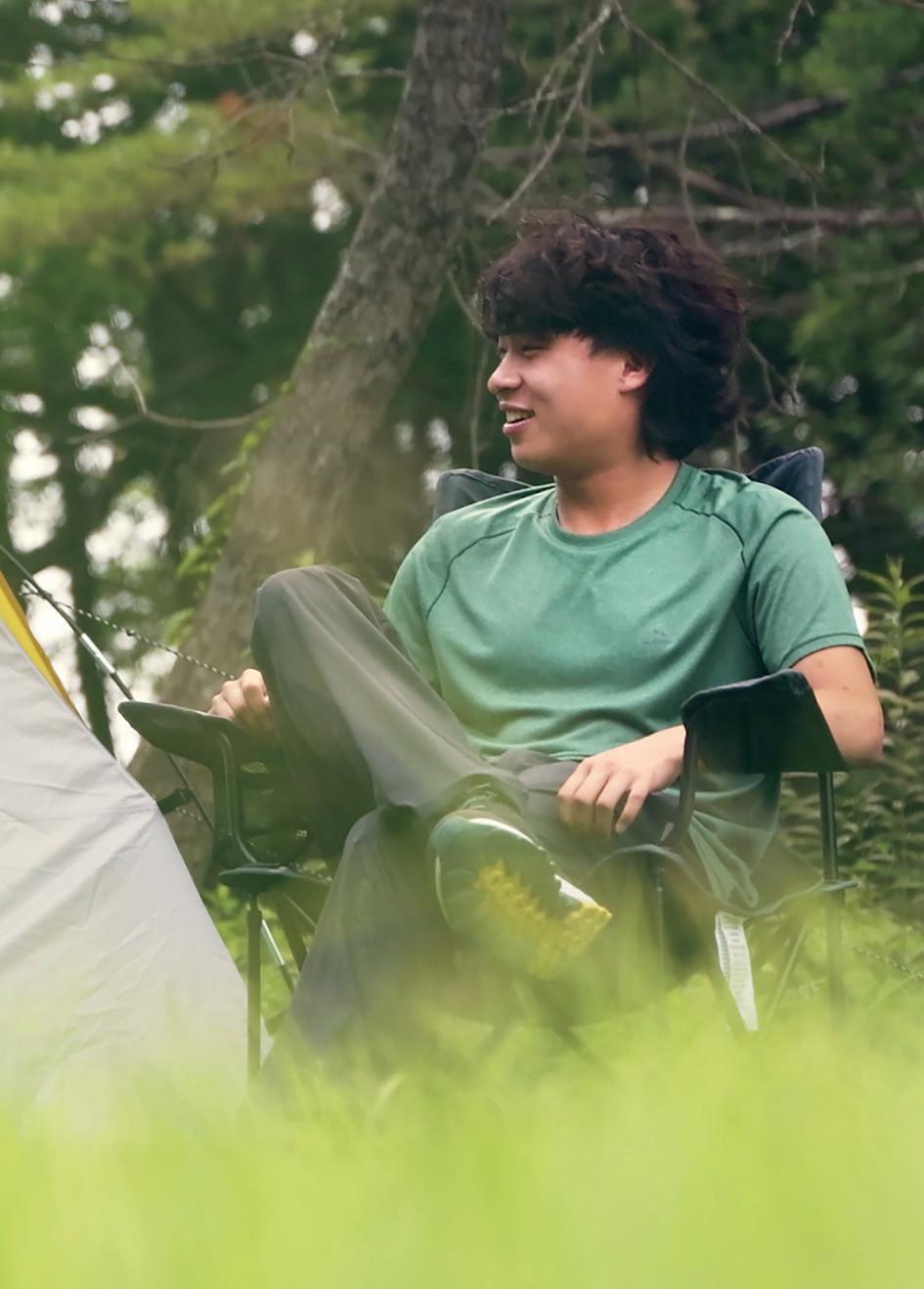
Opportunity A computer science intern at L.L. Bean becomes a social media star for the company.
IN THE SHORT promotional reel, Zai Yang ’27 walks across forest gullies and along shell-lined beaches. He stops in a field and pitches a tent with a friend, all while casually showing off a new line of the company’s more affordable clothing and gear. “The video was completely intern-led,” Yang said, crediting student workers Matthew Solan and Fisher Hirsch for directing and editing the short, and Ruby Hill for co-starring with him. Yang’s primary task as a summer intern was to use his computer science skills to build a new web application for customer service employees. But he also enjoyed all the outdoor trips he took with other interns—supported by free L.L. Bean gear—and the chance to work for a famous Maine company. “What drew me to them was how well they treat their customers, employees, and the earth,” he said.
Sound Bite
“Your future employer, whether a firm, nonprofit organization, or a government, will hire employees with skills that AI cannot replicate.”
—ASSOCIATE
PROFESSOR OF ECONOMICS ERIK NELSON, GIVING THE 2025 CONVOCATION ADDRESS

Athletics
Field hockey coach Nicky Pearson earned her 400th Bowdoin career win on September 17, as her team beat Wellesley 3-0, scoring all three goals in the first quarter. Head coach since 1996, Pearson is just the tenth coach in Division III field hockey history to hit the 400-win milestone. In her time at Bowdoin, she has led the team to eight NESCAC titles, a perfect 20-0 season, the College’s first-ever team NCAA championship, and four Division III crowns. She has been named NESCAC Coach of the Year nine times and National Field Hockey Coaching Association Coach of the Year four times.
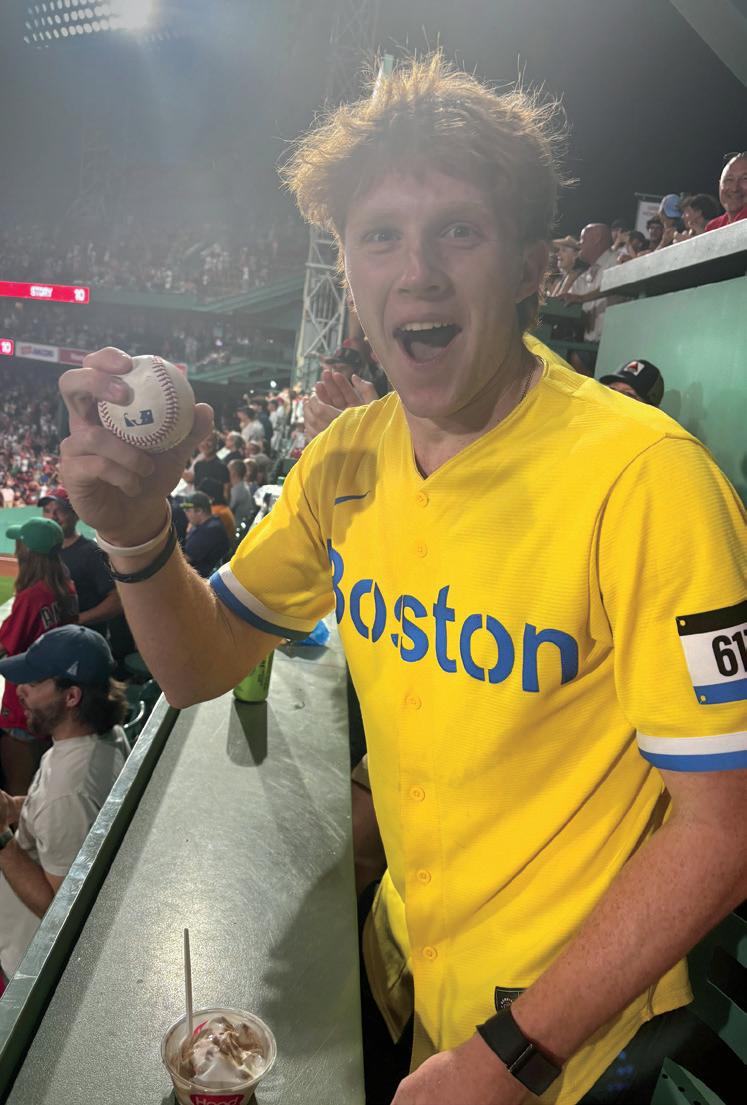
From the baseball diamond at Fenway Park comes a real gem of a Trevor Story story, though the real tale is someone else’s to tell. The Red Sox shortstop’s fifteenth home run of the year ripped into the stands above Fenway’s famed Green Monster during a game with the Colorado Rockies. On that warm July night came the coolest move of the game: Ryan Jaillet ’29, wearing a Red Sox jersey and sitting in seats that were a high school graduation gift from his parents, reached up and just casually grabbed Story’s home run ball out of the air—barehanded. “It was the bottom of the seventh inning, and Trevor Story was up to bat,” recalls Jaillet. “I was mid-scoop on my ice cream when my brother yelled, and I looked up and saw the ball coming right to me. Everything just came naturally after that.” Naturally, indeed; Jaillet, who played catcher for Andover High School in Massachusetts, is planning to play ball for Bowdoin this spring. That three-run shot gave the Red Sox a commanding lead on the way to a win that night— and Jaillet the story of a lifetime and the ball prove it.
History
A career in historic preservation lets history majors channel their passion for the past into safeguarding buildings and neighborhoods that help tell the stories of a community.

Executive director of Lincoln County Historical Association
The association maintains three buildings on the National Register of Historic Places: the 1754 Chapman-Hall House (pictured), the 1761 Pownalborough Court House, and the 1811 Old Jail and attached 1839 Jailer’s House. Gilmore is also an expert in Maine’s grange halls, community buildings people have been gathering in for 125 years, originally to advocate for rural people, farmers’ rights, and women’s standing in the community. “Each of these places has an incredible story to tell as it helps us interpret local history, and we’re constantly working to uncover fuller narratives that deepen our understanding of the past,” she says.
Former director of Portland’s historic preservation program
Andrews is a big reason Portland is as charming and beautiful as it is. Among her many achievements are the rehabilitation of Lincoln Park—the city’s oldest park—and its distinctive cast-iron fence (pictured) and designating Munjoy Hill, once home to many immigrant workers, as a historic district. “Portland’s working-class neighborhoods tell as important a story as architectural gems and the wealthier neighborhoods,” she says.
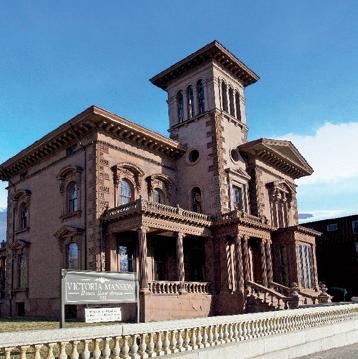
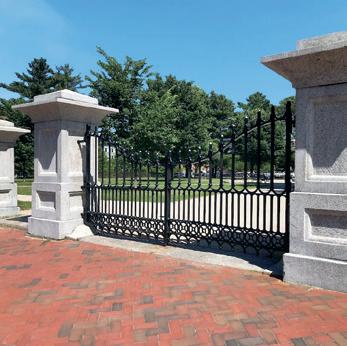
Director of Victoria Mansion, a National Historic Landmark and museum in Portland
Victoria Mansion (pictured) was built in the mid-nineteenth century in the style of an Italianate villa by a businessman from Leeds, Maine, who ran luxury hotels in Boston, New York City, and New Orleans. Today the mansion strives to tell stories of its past, including those of servants who kept the house running and enslaved people who “unwillingly underwrote the construction” of the building. He says, “If you open yourself up and really look, you can connect with the people of the past through the things they left behind, buildings included. And this, like foreign travel, is an enlarging experience, one that broadens our perspective as human beings.”
Art
The Bowdoin College Museum of Art’s (BCMA) connection to the 2025 Met Gala is a study in how the holdings of the College’s world-class museum shine brightly, even outside its walls. The theme of this year’s gala, “Superfine: Tailoring Black Style,” was about exploring Black dandyism through fashion and is also the name of a companion exhibition at the Costume Institute at The Metropolitan Museum of Art. Included is the BCMA’s Portrait of a Gentleman, an oil-on-panel painting by an unidentified artist that “perfectly incarnates the ease and self-possession that we are hoping to convey,” said exhibition curator William DeGregario. The BCMA loans about a dozen works each year, said curator Cassandra Mesick Braun, adding that on that particular day there were three such requests on the docket, including another from the Met. Placement in such a prestigious setting can be a feather in the cap of a loaning institution, but it also can be a heavy and complicated lift. There are formal letters of request, myriad conservation concerns to manage—as well as meticulously safe shipping—and sometimes travel for a museum staffer to oversee an installation. For those whose work is providing art visibility, the effort involved in sharing pieces with new and different audiences is just part of the joy, even when arranged from afar.

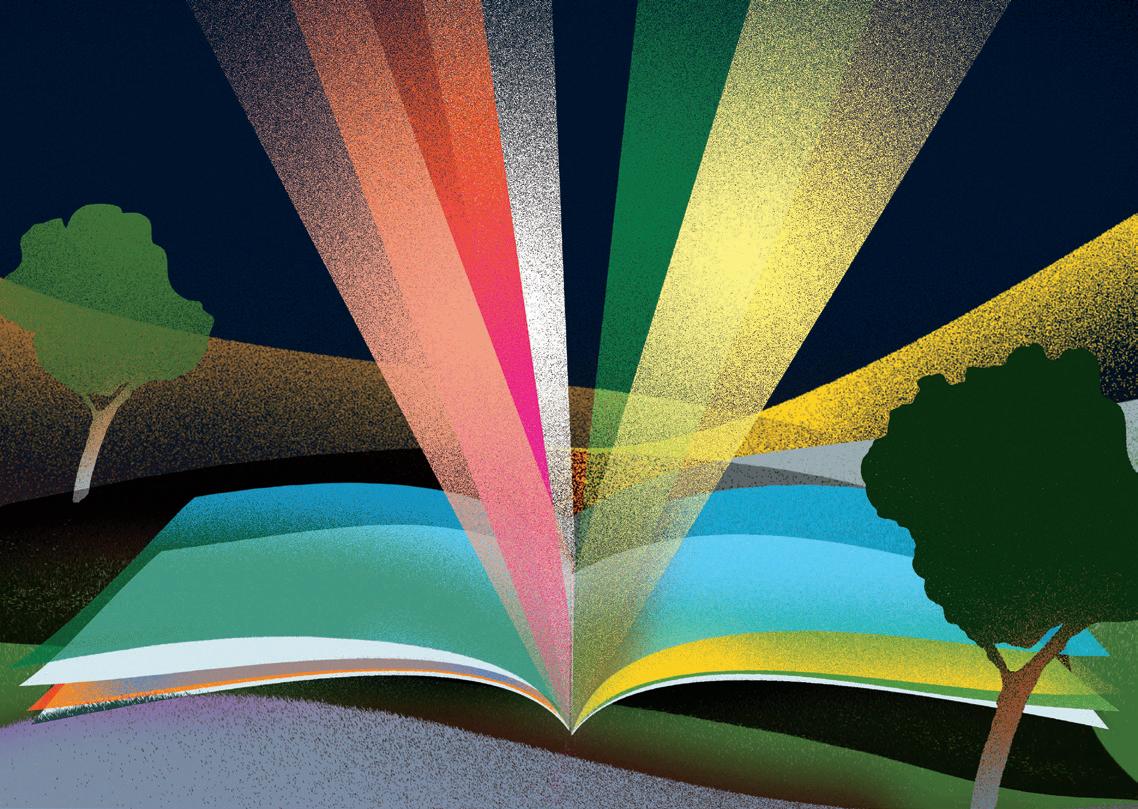
Advice
To create a reading guide for his fellow graduates as they launch their careers, Chris Zhang ’25 reached out to faculty and staff for book recommendations.
“In the spirit of a liberal arts education and lifelong learning,” he began his appeal, “you can suggest any book…from your discipline that you believe would be of interest to a Bowdoin graduating senior.”
As he approached Commencement, Zhang said he felt a loss about the classes he hadn’t taken and the professors and staff he hadn’t met and wanted a last opportunity to learn from them. After sending out a request via the Campus Digest, he received submissions ranging from contemporary and nineteenthcentury novels to books on philosophy, history, politics, and self-improvement. Some who recommended books stayed true to their disciplines; others suggested books outside their fields.
Philosopher Aliosha Barranco Lopez thought seniors would appreciate Emily Austin’s Living for Pleasure, An Epicurean Guide to Life. The book, she noted, “will help you think about how to live a good life. It is philosophically rich and a joy to read.”
Classics professor Michael Nerdahl suggested More Everything Forever, by Adam Becker. “A fine illustration that insistent claims of scientific ‘rationality’ are driven by surprisingly irrational and ideological motives,” he wrote.
Max Lykins, a visiting assistant professor in government, thought graduates should read, or reread, the classic Russian novel The Brothers Karamazov. “A liberal arts education prepares us to ask enduring human questions, like what is justice? Is God real? Are we responsible for what we do? Brothers offers some of the most profound answers to those questions that I’ve ever read.”
Zhang is making his way through the list, starting with The Immortal Life of Henrietta Lacks, which received two nominations, The Mushroom at the End of the World, a Francis Spufford novel called Red Plenty, and Mr. g. The last one, recommended by astrophysicist Fe McBride, offers, she wrote, “an insight into the beginning of the universe, as told by a theoretical physicist in the form of a parable.”
Professor of History Dallas Denery reveals a story from his life before academia, in which he begins as a punk rocker and ends as the author of a piece in a magazine for cat lovers.
SHORTLY AFTER the September 1989 Loma Prieta Earthquake in California, I found myself in need of a job. My four-year punk rock “career” had finally petered out in July. Our label had dropped us after our first album failed to find much of an audience beyond our local fanbase, and a three-month cross-country tour, though tremendously educational (among other things, I now knew where to find the world’s secondlargest twine ball), had done little to make it seem like stardom was just over the horizon. A bit disappointing to be sure, but not devastating, as a career in music wasn’t a particular ambition of mine. That aside, punk rock had never paid the bills, so all along I had been making ends meet summarizing legal depositions in my little apartment in San Francisco for a Berkeley law firm. Unfortunately, the earthquake had made it impossible to cross the Bay to Berkeley—the Bay Bridge was partially destroyed, and BART had been shut down for inspections. My days as a deposition summarizer, like my days in punk rock, were through.
Finances dwindling, I decided to look for whatever full-time work I could find, and so, one day, I walked from my flat in North Beach to a Financial District job placement agency. I met with a woman in her mid-forties (her name forgotten after all these years) dressed in black, with hair dyed to match her clothes. She asked about my work history, how fast I typed, when I could begin, and then she looked at my résumé. “I see here you studied philosophy in college. I study philosophy too, mostly in connection with my ongoing investigations into ancient Egyptian theosophy.” She then stood up, went to the window, and asked me to stand next to her. Both of us now looking down from twelve floors up at the busy afternoon streets, she asked, “Do you see all those people down there?” I told her that, yes, I could see them. “I sometimes think they are nothing more than ants that I could
squash with my thumb.” It was not the sort of thing I ever thought I would hear at a low-level corporate job interview, and its connections to theosophy—at least given my limited knowledge of theosophy—remained murky. I don’t remember how I responded, if I responded at all, but it did leave me with a somewhat warped expectation of the mysteries awaiting me just below the surface of the San Francisco legal world.
Within a week I was working full time as a legal secretary. I had never worked in an office, much less as a legal secretary, and while I wouldn’t call it fun, it was interesting. I suddenly found myself submerged for eight hours a day in a world entirely new to me, with its own traditions and passions. One of those passions, it turned out, was for cats. All of my coworkers were cat crazy. They covered their desks with framed cat photos and daily tear-away cat calendars. They hung motivational posters from the walls showing kittens suspended from twine (“Hang in there, baby!”). As I didn’t much care for cats and was the only man in the steno pool (as we already no longer called it in 1990), all of this left me outside much of the daily secretarial socializing and conversation that happened before and during and sometimes after work.
Sadly, none of this absolved me from having to join in one of the office’s core traditions, the Secret Santa. Every Christmas, every legal secretary needed to purchase one present to be randomly distributed among us at the annual office holiday lunch.
I am a terrible gift shopper and innately a bit of a cheapskate, but I did like my coworkers who, to a person, were easy to work with and made efforts to make me feel part of the team. My artistic impulses muted, what with my band no more and my days taken up transcribing endless tapes of letters and legal briefs, I decided that my Secret Santa gift would be a cat-themed Christmas story given to my fellow secretaries.
I could attempt to enter their cat-loving social world while not spending a cent and not actually having to participate in their cat-loving social world at all!
The result was “A Kitty Kat Christmas,” the story of how Kimberly Kitty Cat discovers the true meaning of Christmas in three chapters totaling eight pages. Briefly: Kimberly is caught in a snowstorm, cold, shivering, maybe lost, and certainly scared, until Mary, her five-year-old owner, finds her, brings her inside and sets her in a blanket before a roaring fire (Chapter One). Having been so cold and scared and now being so warm and comfortable (though possibly coming down with a cold—“meow-choo!”), Kimberly dozes off, only to be suddenly awakened by a large man in a red suit who leaves a mountain of gifts beneath the Christmas tree (Chapter Two—the dream sequence). In the morning, Kimberly awakens, surprised to discover not a mountain of gifts beneath the tree, but only a few, because Mary’s family is not rich. But Mary, far from disappointed, is so happy and grateful for what she has been given that Kimberly learns the true meaning of Christmas: It is not how much you get, but how much you love (Chapter Three).
However enthralled you may be with this brief summary of “A Kitty Kat Christmas,” let me assure you, it is a terrible, terrible story. I don’t think I wrote it to be terrible, but it is, undeniably and objectively, terrible. I have no recollection what any of my colleagues thought about it except one—the woman from the job placement agency whose interest in ancient Egyptian theosophy led her to imagine the possibility of squashing people with her thumb like ants. For reasons never clear to me, she appeared in the office one day as our new receptionist and remained so for the rest of my time there. Perhaps she had discovered that being a receptionist paid better than finding people jobs as receptionists, or perhaps her tendency to transform placement interviews into reflections on the theosophical insignificance of pedestrians had compelled her superiors to suggest she find a new line of work. To this day, I regret never asking what precipitated her career change.
As I left work the day after the office holiday lunch, she stopped me. “Dallas, I loved your story!” I thanked her and was about to move on
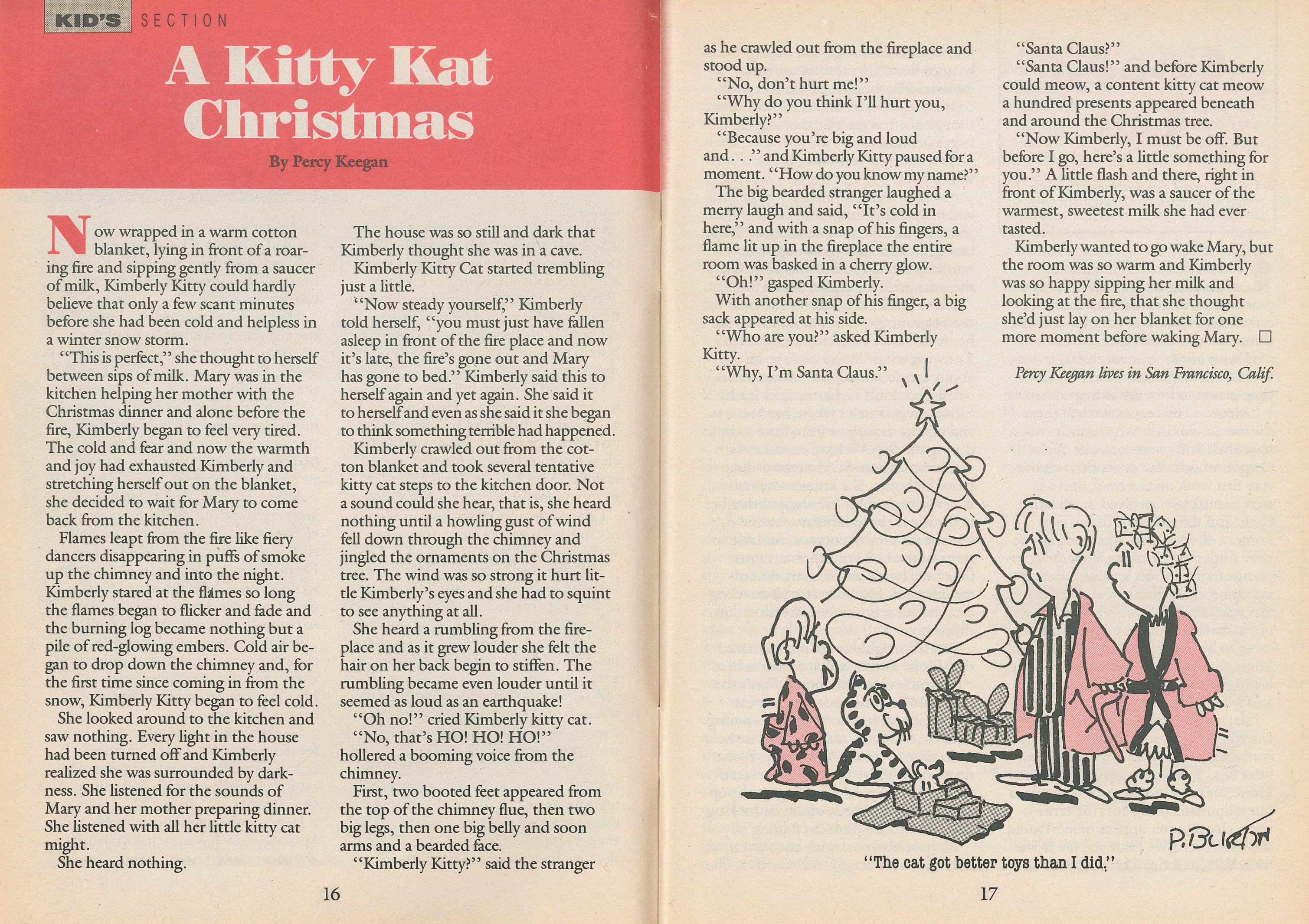
when she added, “You need to publish it here,” and showed me a copy of I Love Cats magazine. “You really think I should?” “Oh, yes, it’s exactly their kind of thing.” I read the magazine that night, and she was correct, “A Kitty Kat Christmas” was exactly their kind of thing.
The next day I mailed my story to the editor under my grandfather’s name, Percy Keegan. I received a response about a month later. “I have good news and bad news,” the editor of I Love Cats wrote. “We want to publish your story, but only Chapter Two. We will pay you $40.” I immediately accepted, although I did explain how this editorial decision undercut the true point of the story as Chapter Two, the dream sequence, merely sets the stage for the moral of the story (“It is not how much you get…etc.”), which only comes at the end of Chapter Three.
I also explained why, even though my name “really was” Percy Keegan, I needed them to sign the check to “Dallas Denery.” None of this received any response and, when the check arrived, it contained no additional correspondence. I was hardly surprised. This was the same company that published Quick and Easy Crochet—their plates were full.
I remained a legal secretary for about another year, even after most everyone else—lawyers and secretaries alike—were let go after the firm lost its major client. But my time there was coming to an end anyway. I had started studying Latin through an adult extension program as I contemplated going to graduate school to study medieval philosophy, with the goal of becoming a college professor. Unsurprisingly, being a college professor is not at all like being a legal
secretary. Among other things, instead of writing stories about cats discovering the true meaning of Christmas, you end up writing essays about writing stories about cats discovering the true meaning of Christmas. This, evidently, is what we mean by “scholarship.”
Professor of History and Associate Dean for Curriculum Dallas Denery II is an intellectual and religious historian who is interested in questions like “Why do we care about the past?” He has written a great deal about lying, including his most recent book, The Devil Wins: A History of Lying from the Garden of Eden to the Enlightenment, and—now—two pieces about kitty cats and Christmas.
To read the entire three chapters of Denery’s “A Kitty Kat Christmas,” visit bowdoin.edu/magazine.



BY MICHAEL BLANDING PORTRAITS BY JARED LEEDS

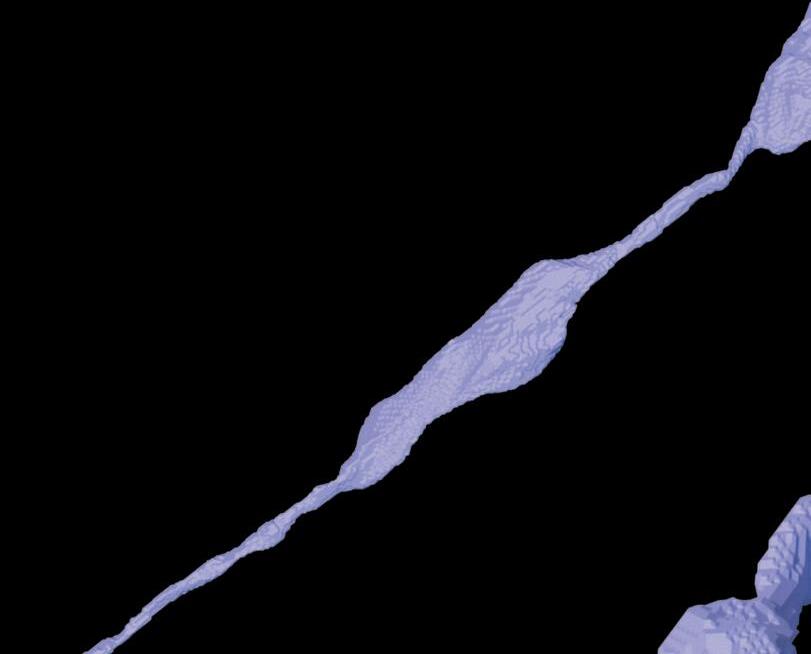





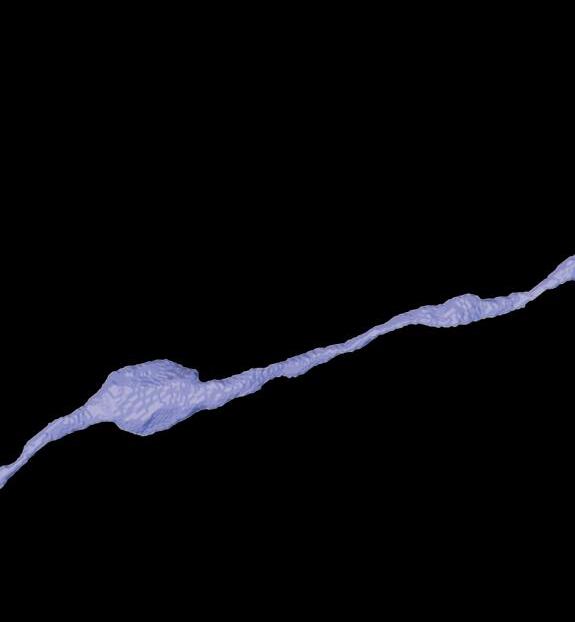

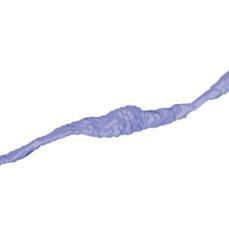



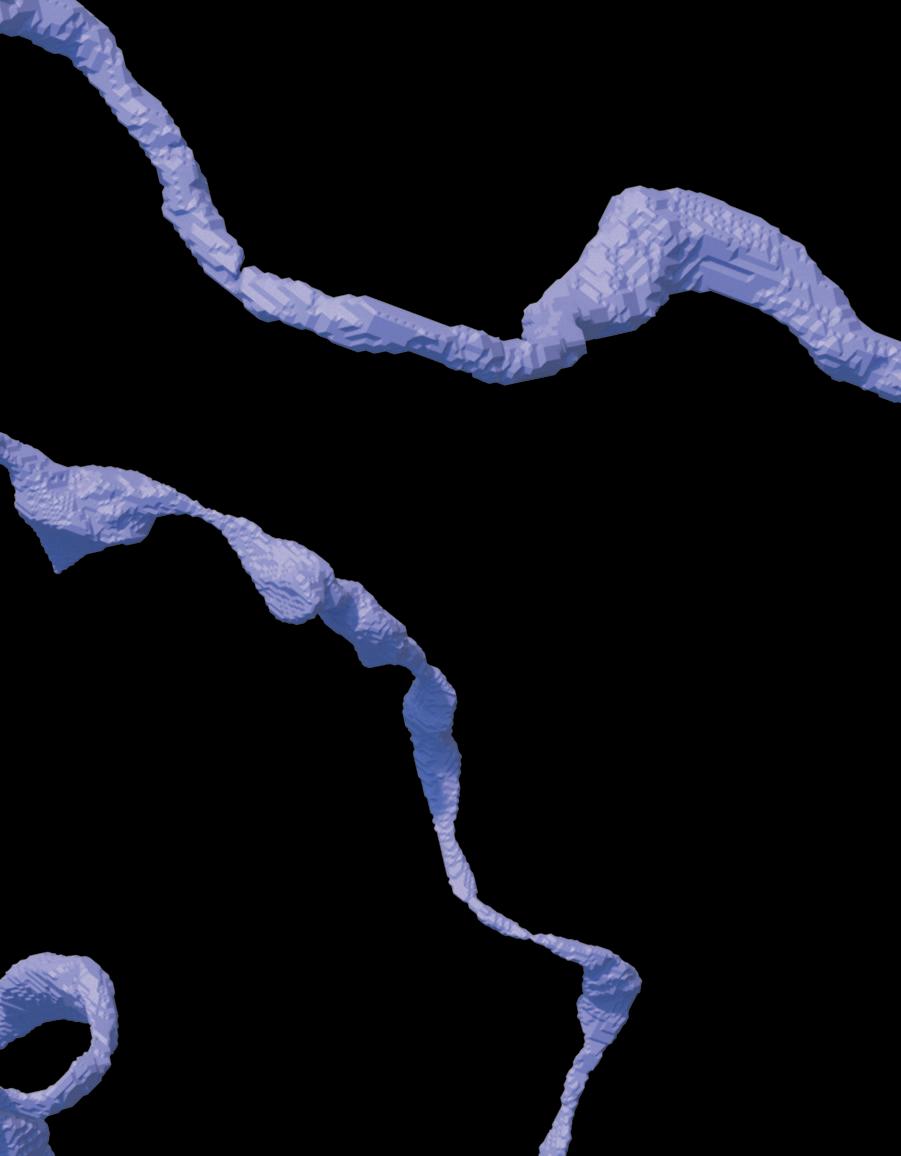






B R A I N B O W



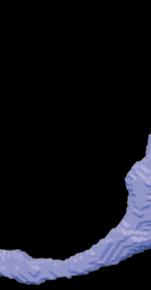











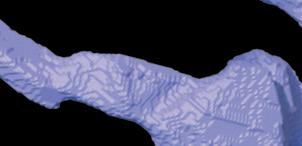



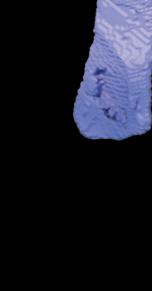

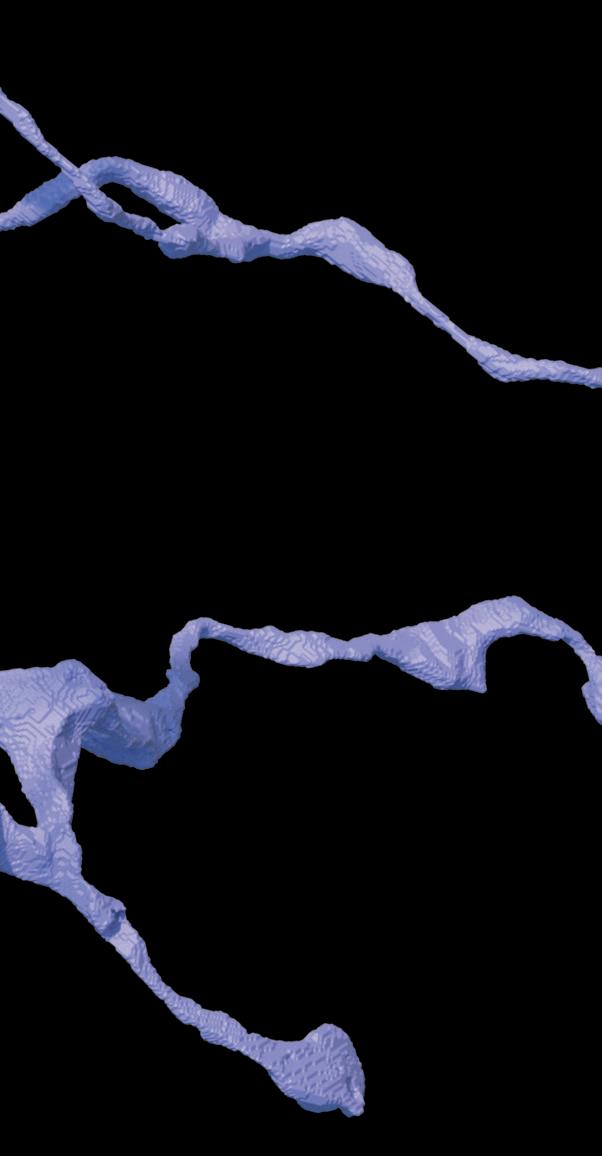






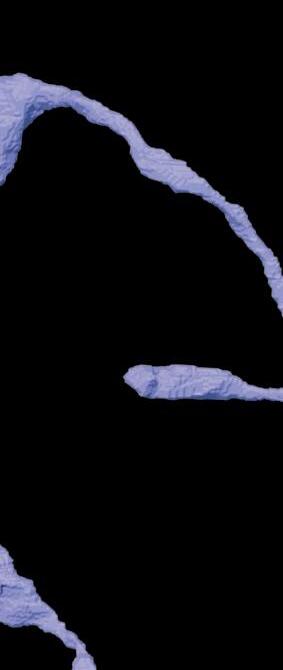

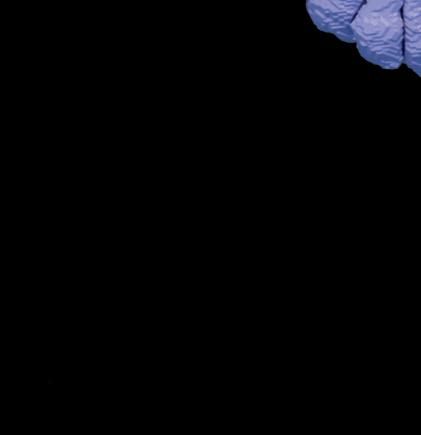






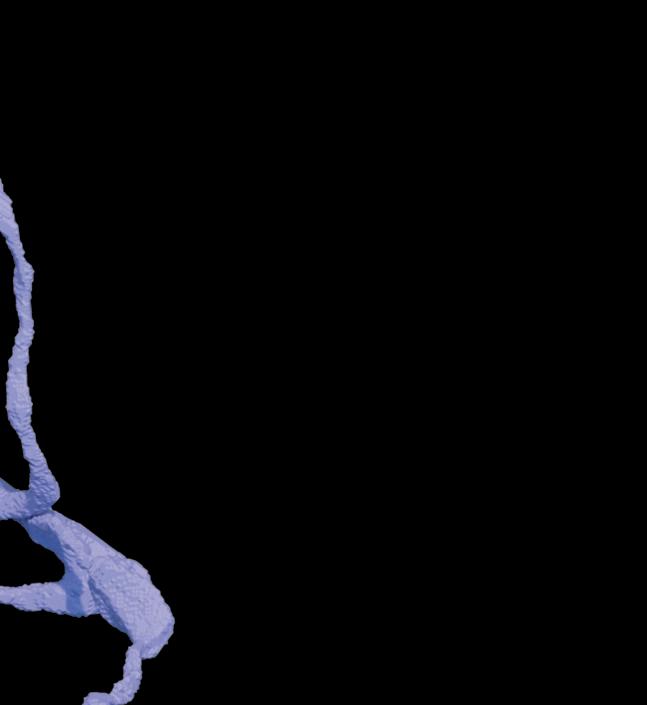



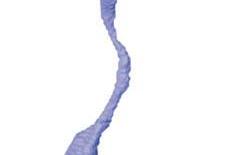


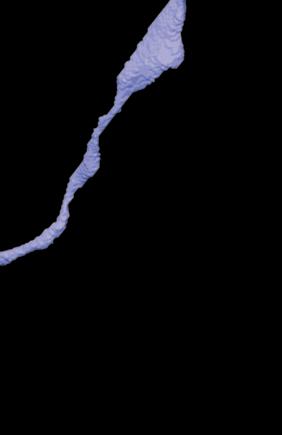


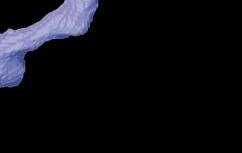









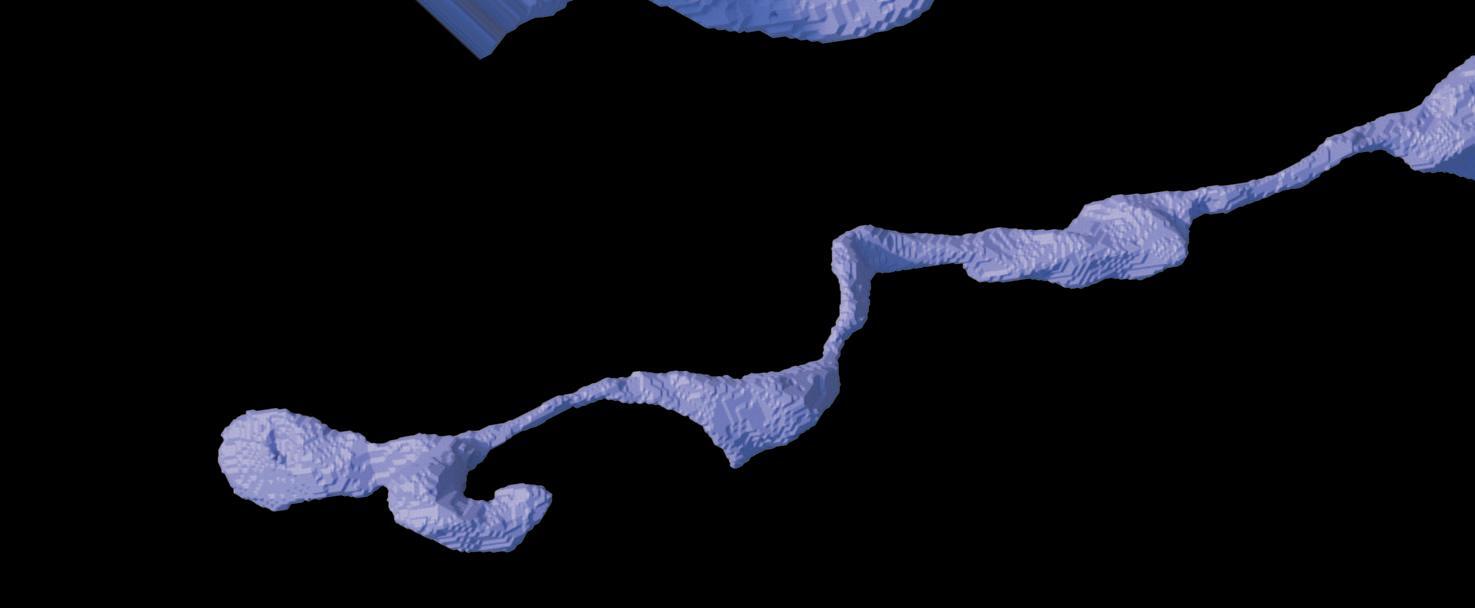










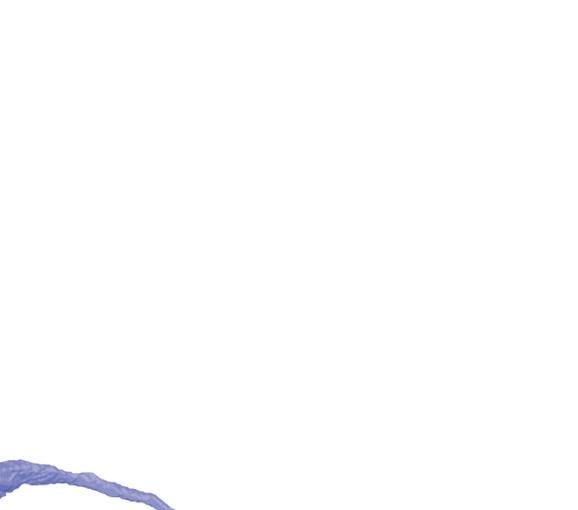
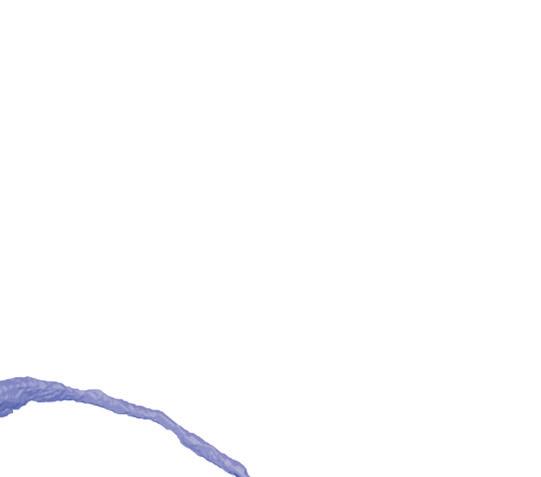



















Opening spread:
During their work to build a view into the human brain, Jeff Lichtman’s team discovered rare loops in some axons carrying signals away from the cell they called “whorls.”
Opposite page:
Lichtman examines a piece of tape containing very thin slices of brain embedded in resin and arranged in a way that resembles a film strip.
A Brainbow image showing different cells by color. In this innovative cell-labeling technique, hundreds of unique color profiles can be used as cellular identification tags.
“THINK OF AN AMERICAN FLAG,” says neuroscientist and Harvard professor of molecular and cellular biology Jeff Lichtman ’73, sitting in the office at his lab. In response, he says, you might envision a field of blue, speckled with fifty bright stars and laced with thirteen red and white stripes. “You’d have no trouble rendering that, and it doesn’t take a week—you render it instantaneously,” says Lichtman. “I could have asked you to render your mother, or your pet dog, or your child—it doesn’t matter, it’s there immediately.”
Easy—but here’s the hard part: Where in the brain is that memory sitting? “Is it a physical entity? Does it weigh something?” Lichtman asks. “It has to be something so stable that even if you’re not using that memory—sometimes for decades—it’s still there, just like it was yesterday.” We might imagine a vast file cabinet in the brain, with drawers labeled “American flag” and “mother” and files made up of proteins or other material waiting to be retrieved.
Lichtman has a different theory, on the forefront of brain science: that everything we know and learn is embedded not into any particular molecule, but rather in the connections between nerve cells. “Each memory is not a chemical, it’s a pathway through this vast morass of wires,” he says. “What’s being triggered is a movement of information through that wiring system in the brain.” While the Human Genome Project has mapped the genes in the body and examined their functions, Lichtman believes that when it comes to the brain, genes are not as important as cells and how they are connected. He’s spearheaded an ambitious project to map the brain that he’s dubbed the “connectome,” tracing the millions of miles of neurons packed into that relatively small space to understand how people learn and remember, as well as why sometimes the wiring goes wrong. Last year, Lichtman was appointed dean of science for Harvard’s Faculty of Arts and Sciences. A week later, he and his lab colleagues published a landmark paper in Science announcing the largest image of the brain to date: a digital three-dimensional rendering of a cubic millimeter of human brain tissue that contains 57,000 cells with 150 million synapses between them—1,400 terabytes of data in all.
The scale of the image is staggering. “Words fail us, not because we’re so emotionally overcome, but because the complexity of the wiring diagram cannot be put into sentences,” he says. “It’s like trying to describe all of New York City—even if you had a complete map of every single thing going on, words would not be able to capture it.” To overcome those limitations, Lichtman has developed innovative techniques to depict the brain visually, including a collaboration with Google using artificial intelligence to color tiny cells and parts of cells within. Already, the techniques have revealed never-before-seen structures with the potential to revolutionize brain science. There’s no telling what he might find on the way to his ultimate goal of mapping the complexity of the brain in its entirety.
When Lichtman was a kid growing up in Westchester, New York, his father did something early on that transformed his son’s life. A hematologist at a nearby hospital, he placed his old Leica medical-school microscope in the bedroom Lichtman shared with his brother. “I don’t remember him giving us any instructions, but I used it to look at everything—throughout my childhood, there was no aspect that wasn’t scrutinized.” He remembers keeping a Tupperware container of smelly pond water in the bedroom, spending hours watching paramecia and other protozoa swimming around “a whole gigantic world.”
Even now, a microscope sits on the desk in his sunny office, and Lichtman uses it regularly to illustrate points to students. “I actually can’t imagine an office without a microscope.” At Bowdoin, he aspired at first to be a writer or musician, but science was effortless when those subjects were not. “Biology was just a natural for me,” he says. “The advice I give to young people now is to choose what you find easiest—because if you keep pushing on what you find easy, you are going to get to a point where you find it hard, and by then, not many people will be at your level.”
Lichtman took his own advice, going into an MD/PhD program at Washington University in Saint Louis. Still, the liberal arts environment
in his undergraduate years not only shaped his career but also influenced his thinking. “I give Bowdoin a lot of credit for encouraging that liberal arts worldview, where you are really not a complete human being if all you do is advanced math or electronics,” he says, recalling evenings at professors’ houses and long conversations over dinner that blurred the line between classroom and life.
“He is a true philosopher of science,” says Bobby Kasthuri, a former student at Washington University and longtime collaborator. “Jeff is a natural contrarian, but there’s a kind of gentleness to his contrarian nature.
He’ll talk about radical ideas but in a laid-back fashion.” With the rise of molecular biology, neuroscientists increasingly looked to explain cellular behavior through genes and the molecules they produce, developing a theory that pathways were strengthened in the brain through the transmission of chemicals between synapses. Lichtman, by contrast, developed a belief that it wasn’t chemicals as much as the physical structure of the brain that determines its function.
“Jeff has long argued that it’s very hard to go from molecules to behavior,” says Kasthuri. “His argument is that cells are the fundamental
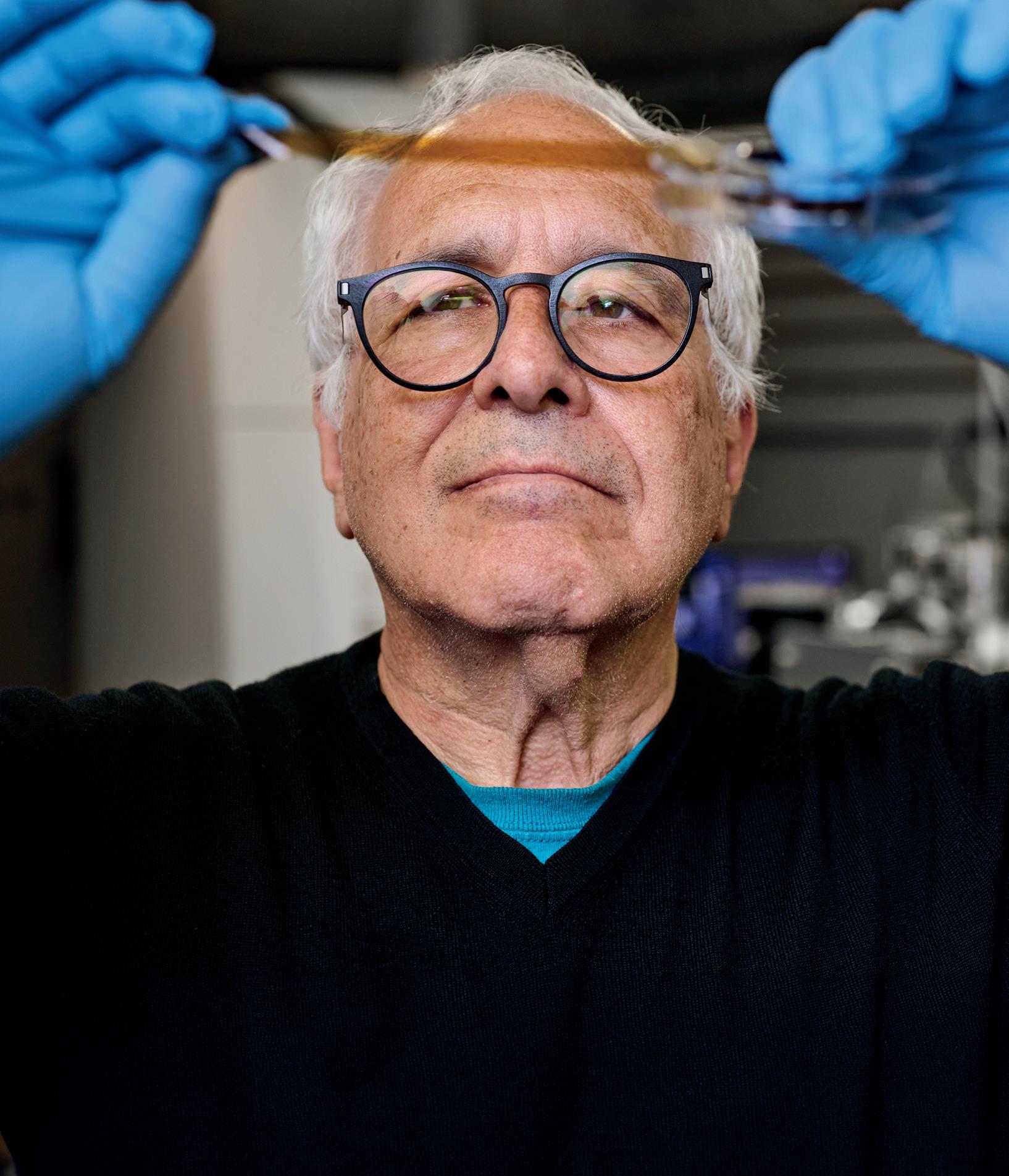
The techniques have revealed never-before-seen structures with the potential to revolutionize brain science.
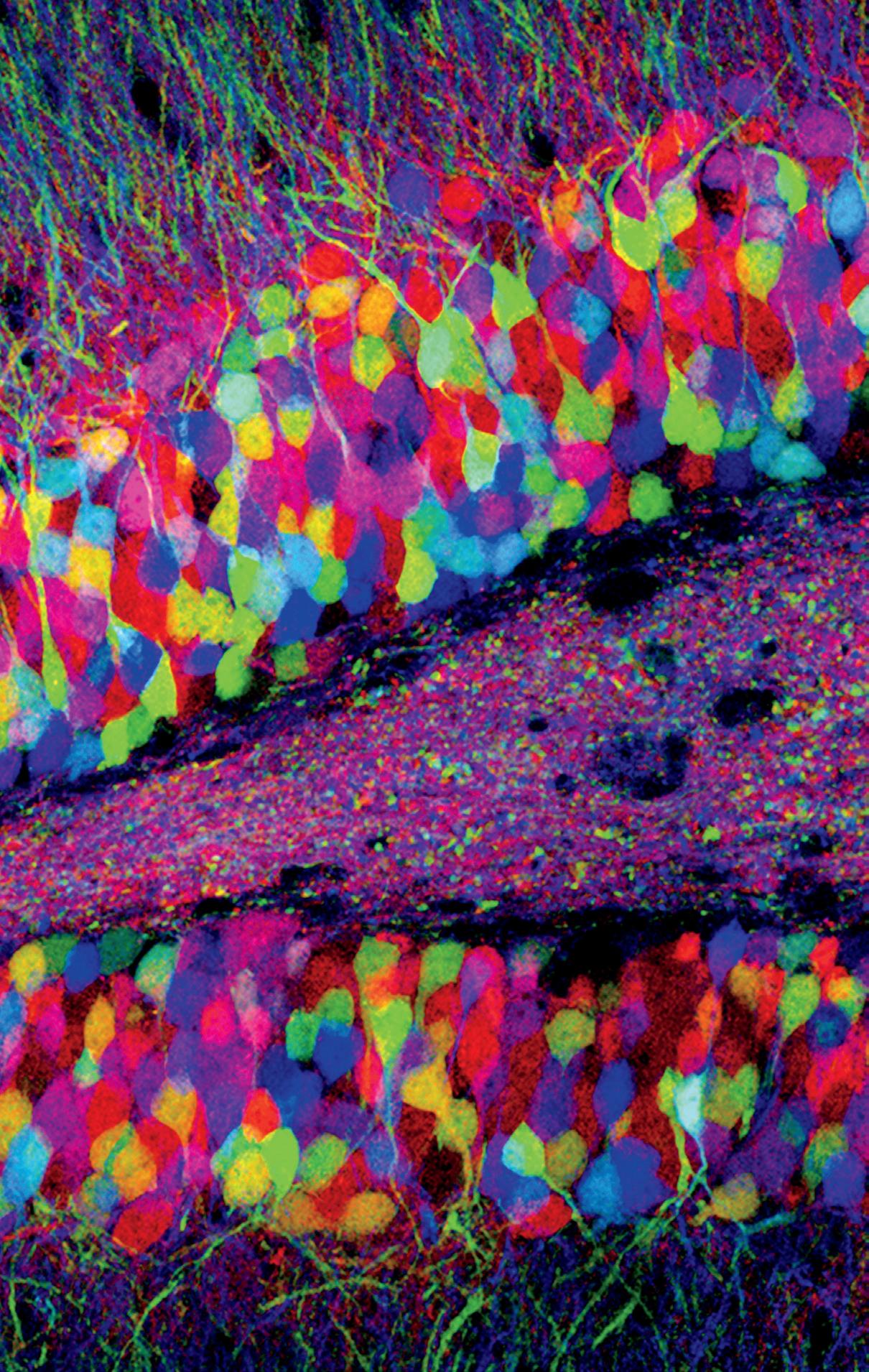




units. The way they connect is what really matters.” That view reshapes how we think about the brain and how it develops. Most people assume that our brains get more complex as we age, accumulating connections, but Lichtman sees it differently. “You are not building a wiring system as you get older, you are sculpting one,” he says. “You start out with wires for everything, and you ultimately keep the things you learn and get rid of the rest.”
As we prune connections, he says, older people literally get set in their ways. “They would call it wisdom,” he says. “You might call it being stuck in the past.” The process carries broad implications—psychologically, sociologically, even politically. “Different adults can see the same thing in radically different ways,” Lichtman says. “That is because they’ve developed different pathways based on what they’ve read, heard, and thought about. It becomes very hard to change that.”
On the other hand, he says, humans’ ability to change their brain wiring has made them uniquely resilient and adaptable as a species. “There was a time when humans didn’t live indoors or wear clothes,” Lichtman says. “We certainly didn’t read or write. Now we are not only able to encode information in our brains but also pass it along to others. That means
humans keep changing because of this profound ability to adapt our wiring diagrams to the world we live in.”
The same adaptability can also have a darker side, helping explain some forms of mental illness. Children raised in a dysfunctional or abusive home might adapt in ways that lead to emotional and behavioral problems or addiction. Other diseases, such as Alzheimer’s and epilepsy, seem to have a genetic component as well. Decades of attempts to pin those conditions on a single gene, or even a combination of genes, have failed. Lichtman speculates that in reality the causes are more complicated, stemming from problems that grow out of a miswiring in the diagram of the brain. “And until now, seeing that diagram has been impossible.”
in mapping how nerves connect, laying the groundwork for the new field of connectomics. After earning his MD/PhD in 1980, he became a professor at Washington for two and a half decades before moving to Harvard in 2004. At first, he used physiological techniques to stimulate nerve cells to determine which were connected. Nerve cells, or neurons, consist of a long spine called a dendrite, ending in a spiky structure called an axon, which connects to other nerve cells across small gaps called synapses.
Clockwise from top left:
A pyramidal neuron from a human brain sample, with axons showing the rare whorl pattern. Of the millions of axons in the data set processed by Lichtman’s lab, only a few had these whorls.
After the brain sample is sliced into 30-nanometer-thick sections and imaged, the images are reconstructed in a stack so that the components can be viewed in 3D.
A section of mouse brain cortex showing a large dendrite (red) with axons and synapses—the points where signals pass from one neuron to another.
Neurons colored to differentiate size and to show layers. Large neurons are colored red and small ones blue.
That conviction leads him back to a principle that has influenced him since his childhood pond-water watching: the power of observation. Science is always performed through hypothesis and experimentation, he says. Whether it’s astronomers charting galaxies, particle physicists smashing atoms, or Darwin deriving evolution from finches’ beaks, sometimes the most fundamental discoveries arise from simply seeing what’s out there. If we want to cure diseases of the brain, first we must understand what the brain looks like—just like someone would need to know the way a car works to fix an oil leak or a wiring diagram to fix an electrical system. “We’re just starting to look at these wiring diagrams, and already we’re seeing things that aren’t in any textbook, just because no one has had a way to look for them before.”
Lichtman first started tracing these neuronal connections at Washington University, looking at clusters of nerves in the peripheral nervous system called the autonomic ganglia, which control subconscious functions such as sweating, goosebumps, or salivation. He laughs while recalling how he explained his dissertation work to his mother. “I told her I found this huge reorganization of the writing diagram of the salivary gland. She said, ‘What the hell—you went to school so you can study saliva in rats?’”
Beyond those specific structures, however, Lichtman was making groundbreaking progress
Lichtman realized he could more elegantly trace those connections using color. Traditionally, scientists stained a few cells at random, hoping to glimpse a connection. Stain too many, and the result was a blurry mess. Lichtman had a different idea. Using a recently discovered gene from jellyfish that produced fluorescent proteins, he realized he could manipulate it to create red, green, and blue proteins in mouse cells. By inserting those genes into cells and randomly exciting or inhibiting them, he could produce a spectrum of colors from proportions of those three colors, similar to the way a color television creates a rainbow of color through three colors of backlit pixels.
He called it the “brainbow.” Under black light, the neurons glowed in a riot of colors, each distinguishable from their neighbors under the microscope. Publishing the results in an article in Nature in 2007 that coined the word “connectomics” for the first time, Lichtman was able to showcase images of the brain that were not only informative, but also stunningly beautiful, resembling a lit-up fiber-optic Christmas tree.
While the technique worked well for the peripheral nervous system, the random colors failed to provide the resolution necessary in the densely packed central nervous system. To make sense of that tangle, Litchman and his colleagues would have to use a different approach. From his office, he leads the way down an elevator to the basement, where he shows off a machine that looks like a film projector called the automatic tape-collecting lathe ultramicrotome (ATLUM). The device, Lichtman explains, uses a diamond knife to cut sections of brain thirty nanometers thick—a thousand times thinner than a human hair.

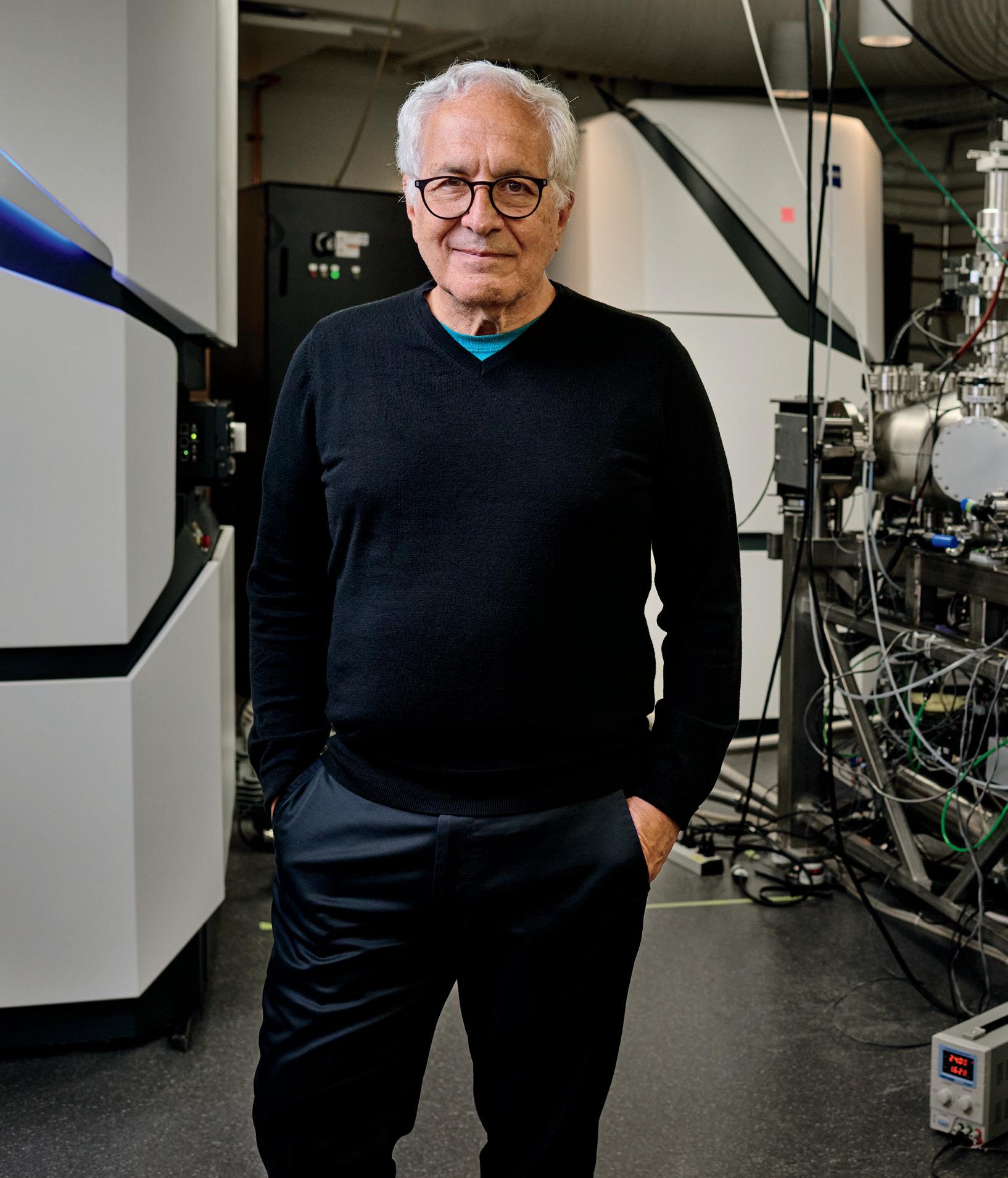
Lichtman in his lab. To his right and behind him are multibeam electron microscopes that use ninety-one parallel beams to create the imaging speed necessary to process the enormous datasets they use. To his left is a new gas cluster milling system that allows them to generate image stacks with slices as thin as what you would get if you cut a single sheet of paper into 5,000 ultra-thin sheets.
Those sections are collected on a silicon wafer, which can be imaged separately by an electron microscope and then recollected digitally to create a three-dimensional section of tissue. After digitizing the brain slices, the scientists collaborated with Google, which worked to stitch those black-and-white images into a seamless three-dimensional representation of the brain. Using artificial intelligence, technicians have been able to trace individual neurons and color them with enough differentiation to distinguish not only individual cells, but also parts within cells.
At the pace of traditional instruments, Lichtman calculated that the tens of thousands of images for a cubic millimeter of brain would take seventeen years to complete. So, he and his colleagues built faster systems, including an
electron microscope the size of a refrigerator that can beam a shower of sixty-one streams of electrons at a time, reducing the time necessary to six months. They are now working on a new machine that will image ninety-one images at a time, connected to a device with a tangle of parts and wires that will automatically shave pieces of brain and feed them into the machine without need for human interaction.
The amount of computing power to accomplish the task has been so vast that Google has had to develop entirely new software to allow multiple computers to work on the task at once. Google research scientist Viren Jain compares it to technological innovations produced by NASA as it has worked to solve problems of spaceflight. “There are these kinds of grand problems, where if you choose something hard
For Lichtman, finding new structures like this is a thrill akin to discovering new species of animals in an unknown land.
enough, you end up inventing something that is more broadly useful.”
Back in his office, Lichtman shows off the results as he zooms on his computer monitor through a vast virtual landscape of colored wires that represents a tiny section of the cerebral cortex of a forty-five-year-old woman who was undergoing neurosurgery for epilepsy. Within that, he and his fellow researchers have discovered previously unknown brain structures. In one, which he has dubbed “whorls,” axons look like a mass of spaghetti all twisted up. It’s the kind of thing that could only be discovered in a dataset this enormous. “Very few axons in the dataset are doing this—maybe twenty out of 200 million—so it’s very rare,” says Lichtman, who speculates it might be related in some way to epilepsy, potentially serving as a marker for the disease.
In another structure he calls a “superconnection,” a nerve cell makes dozens of connections to the same cell. “For most connections, all it takes it one dendritic spine passing by a cell to create a synapse that can carry information,” Lichtman explains, zooming in to show a colored wire that connects to a cell in dozens of places, going up one side and down the other. “Instead of making one synapse, it’s making fifty-two.” He hypothesizes that these strong connections might represent firmly rooted learning, where a concept becomes automatic— the way we might instantly imagine a man with a stovepipe hat and beard from the single word “Lincoln,” or step on the brake as soon as we see a red light while driving. “You don’t have to think, ‘I have to take my foot off the gas and put
it on a brake pedal,’” he says. “It’s an automatic fast path through the brain.”
For Lichtman, finding new structures like this is a thrill akin to discovering new species of animals in an unknown land. “Suddenly there are all these birds and reptiles you’ve never seen before,” he says. “That’s how it feels, like an explorer arriving on a new continent.”
As Harvard’s new dean of science, Lichtman has been working to re-create that same spirit of exploration for students, rethinking how to approach scientific inquiry in an age of the internet and artificial intelligence. “One of the crises of science teaching is that all the information known in the world is available at the fingertips of every student with a cell phone,” he says. “I wanted to come up with a program where ChatGPT would be useless.”
The solution he came up with is a new program based on what he calls GHPs—genuinely hard problems—including the physical roots of mental illness, the nature of dark matter, and the solution to climate change. “These are problems where, despite the best efforts of modern science, we’ve made no progress,” he says. “So, students are not at as much of a disadvantage as you might think, because all the people who know everything still haven’t gotten it right.”
Students would take a class their first semester on campus in which faculty present a number of these problems, he says, and then they’d pick a faculty member who would suggest courses they could take and books and papers they could read to try to solve it over the next four years. “If they are successful, they get a Nobel Prize,” Lichtman quips. More to the point, however, they’ll get something even more essential for a budding scientist: training in a way of thinking to confront the unknown with excitement over the possibility of discovering something new.
“Most education in the sciences consists of courses in which someone tells you, ‘Trust me, you are going to need this later in life,’” he says. “But it doesn’t serve them well when we give them a bunch of things to memorize that they could get off the internet. Most of our students have gotten into Harvard by focusing on accomplishment, but that’s different than battling a
very hard problem, where you might fail many times before succeeding.”
The prime attribute he’s hoping the program engenders in students is curiosity. “Good scientists are confronting problems every day that they don’t have the answers to,” he says. “Every night they are thinking about them, and every morning, they wake up still thinking about them—they just can’t help it.”
He might just as well be talking about himself, as he works to expand on the small piece of brain he’s already helped image. With the new microscope system at Harvard, along with a similar one at Princeton, he thinks he and his collaborators can image a piece of brain ten times larger than the one in their Science paper in just two years. “If we had twenty-five of these instruments, we could do a whole mouse brain in two years,” he says. Of course, that would require massive amounts of data analysis and storage, on the order of exabytes—that is, millions of terabytes—but the payoff could be incredible. “No mammal’s wiring system is known at all,” he says. “Once we had a normal mouse, we could then do a mutant animal.”
By comparing the two, neuroscientists could potentially understand brain disease in an entirely new way, developing therapies to target the connections in the brain the same way that the Human Genome Project has led to innovative new molecular therapies. The truth, Lichtman says, is that no one knows exactly what they’ll find, what new structures await discovery in the microscopic depths of the human brain, and how they might transform our understanding of learning, memory, and illness. “People who do this work consider themselves explorers,” Lichtman says again. “We just want to see what’s out there.” On his desk, the microscope awaits—as it has for all his life—a reminder that discovery begins not with answers, but with a willingness to look closely at the world.
Michael Blanding is a Boston-based investigative journalist whose work has appeared in The New York Times, WIRED, Smithsonian, Slate, The Nation, The Boston Globe Magazine, and Boston
Jared Leeds is a lifestyle, portrait, and documentary photographer based in Boston.

Trees clean the air, fight climate change, boost our moods, and cool and protect our environment. Even a small patch of forest builds a habitat and ecosystem for other forms of life. At Bowdoin, our campus trees are part of the visual landscape, and the Pines in particular are part of the lore and the magic of Bowdoin. But they don’t persist and thrive without attention. After years of research and planning, Bowdoin is taking steps to preserve the legacy of the Bowdoin Pines. Much of it begins with life-giving light.
BY KEA KRAUSE


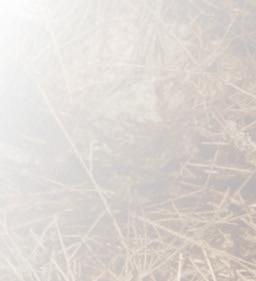
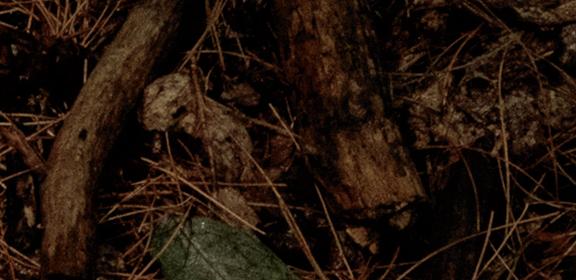


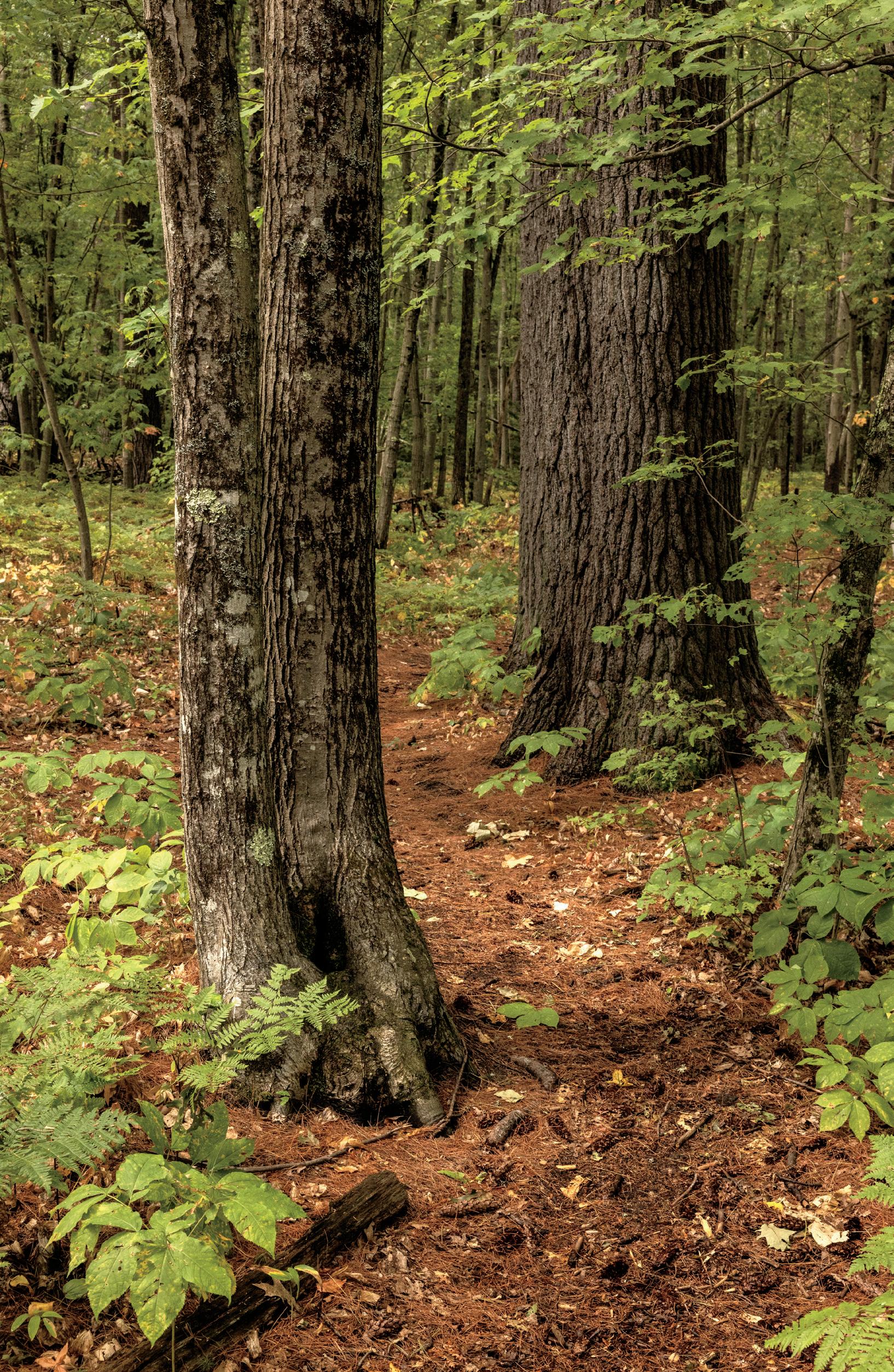






Tin these woods wants to play—in shafts and speckles that squeeze through the canopy, casting spotlights that move and shift across the wooded floor. A lattice of needles and leaves overhead dapples the world below. It is a forest, but it is also shimmering river rock, grainy super 8, a salmon’s spotted back, a child’s kaleidoscope.











needles to 150 years—hiding in plain sight in the heart



In other words: it is a midsummer’s day in the Bowdoin Pines, a thirty-three-acre patch of forest on the northwest corner of the College’s campus. Off a parking lot behind the offices at 85 Federal Street, this stand of tucked-away white pine can go unnoticed by harried drivers along the busy Bath Road it sits next to. But, in fact, some of those trees have been standing head to the sky for any passerby to see for close to 150 years—hiding in plain sight in the heart of Brunswick is one of Maine’s only old-growth forests. In recent years, it has come to the College’s attention that it needs a little help.

“The forest is a living, breathing thing,” remarks Tom Doak, executive director of Maine Woodland Owners. “It’s changing all the time.” Which is why, after decades of the College allowing nature to run its course, trees began to fall—both within the Pines and from the Pines out onto Bath Road. After a series of particularly powerful storms in 2018 and 2019, it became clear that the forest had indeed changed. Trees had gotten sick; some had died of old age and some because of the aggressions of the white pine weevil, a pesky beetle that targets a tree’s leader branch, killing it off in service of its larvae and with it the tree’s future growth. Plants of concern like knotweed and periwinkle had moved into the understory, and hardwood trees like oak and maple began to win in competition with the ancestral pines. A committee was formed to address the forest’s woes, and from the committee came a plan, which in part enlisted the expertise of Doak—a forester by training who was more than happy to help, having grown up in Maine being dazzled by trees. “I remember driving as a kid by the Bowdoin Pines and being so impressed by them,” recalls Doak. “One of the reasons I got into forestry, frankly, was the impact of the Pines.”
In theory, the plan was straightforward: return the portion of the Pines off Bath Road to white pine dominance by removing the problematic
trees flagged by Doak and Harold Burnett, a forester with Two Trees Forestry, opening up the canopy and allowing for the growth of a large cohort of pine seedlings, the result of a 2023 abundance of seeds, known as a mast year. In practice, there were many more factors than the trees to consider. “We were worried that our actions would be misinterpreted or misunderstood or outright opposed,” says Burnett, as he explains that community outreach prior to the remediation of the Pines rivaled the remediation itself in terms of importance. Beyond what the Pines meant to the campus—to current and former students and even to some of the College’s curriculum—the Brunswick community uses the one-kilometer trail that winds through those woods for dog-walking, bird-watching, and nature breaks more generally, and the sight of the heavy equipment used to clear out trees can be alarming, especially when it comes to some of these centenarian trees, Doak says.
As I walk among them, the light plays tricks along the furrowed bark of a massive trunk, luring my gaze upward. The first thing to know about the white pine: its trunk is flawlessly straight, like a vertical runway to the sky. So linear are the trunks that in the 1600s, word from the colonies made its way back to the King of England that there was a species of tree in the New World that produced perfect ship masts, and soon the king’s minions were marking pines for the taking. Maine pine would become the solution for modernity’s many needs: the wood is soft, abundant, and ideal both for framing a house and for flooring one. Thoreau condemned the use of trees for anything other than marveling, writing in his book The Maine Woods, “strange that so few ever come to the woods to see how the pine lives and grows and spires, lifting its evergreen arms to the light—to see its perfect success, but most are content to behold it in the shape of many broad boards brought to market, and deem that its true success!” You reckon with stories like these when you let yourself peer eighty feet from base to canopy of one of these giants, the juxtaposition of its hale trunk and its dainty, feather-like needles a contradiction worthy of Thoreau’s notion of perfect success.
It’s no wonder Doak, Burnett, and the rest of the committee were worried about what some


THE FOREST IS A LIVING, BREATHING THING. IT’S CHANGING ALL THE TIME.


might feel when they saw machinery moving into the Pines. But just as there is a misconception that big equipment always means destruction, there is another that caring for a forest invariably means leaving it alone. As Doak explains, the mission of forestry falls somewhere in the middle of this spectrum of purposeful intervention and complete neglect. “You’re not playing with nature,” he says. “You’re just kind of figuring out ways to assist it.” Encouraging the Pines in one direction—white pine dominance—and away from what would happen if the woods there were left untouched also raised another important question about how to care for a forest: What would Bowdoin’s stewardship ethos be? More simply, what is stewardship in this case?
TONY SPRAGUE arrives at the trailhead in crisp office attire and a pair of hiking boots. Sprague, Bowdoin’s campus planner, is going to show me the results of the remediation of a section of the Pines that took place over three weeks this past June. As part of the plan, a pocket of woods has been left entirely untouched and will serve as both a test control to compare with the managed sections and an outdoor laboratory for the College’s science programs. It is the reserve that you first walk through when you head out of the parking lot behind the offices.
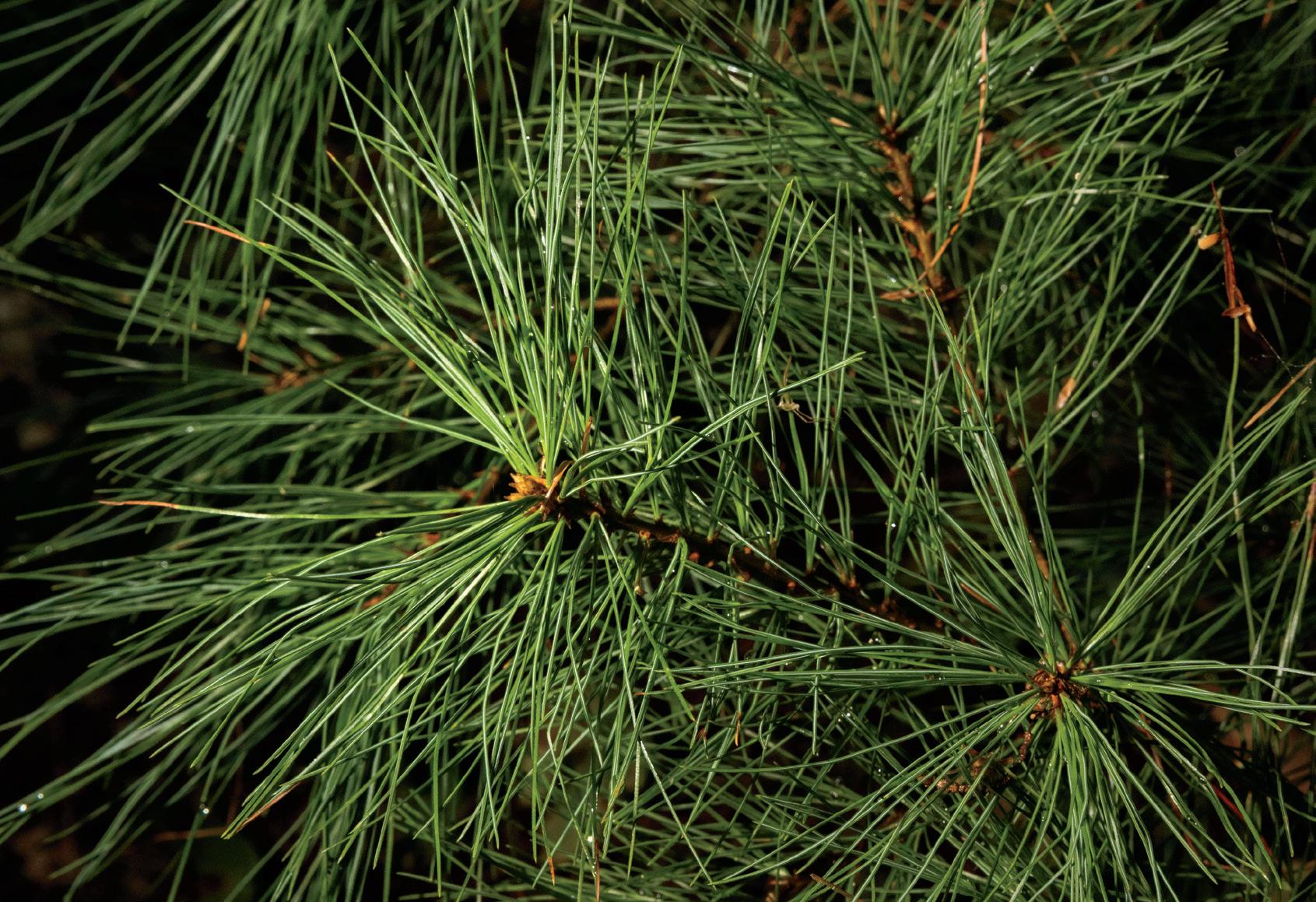
Sprague leads the way through this first dense passage of the loop. “This section has transitioned further away from white pine dominance,” he says, explaining the logic of the placement of the reserve plot. “The amount of intervention that would’ve been necessary to try to restore [this space] would have been more than anybody would’ve been comfortable with.” I follow along behind Sprague, noting little orange flags stuck in the ground off the trail, indicating where student work is underway, like a study on the effect of road salts on ground cover. A gray flash of a squirrel interrupts the balayage of green. The reserve feels like typical roadside woods: oaks and evergreens intermix, while ferns unfurl at their bases. There is bittersweet— another plant of concern—and partridge berry, and if you close your eyes and listen for them, a lot of birds. Mostly pine warblers today. The light is aggressive, and so is the humidity.
“We’re not looking to come in and turn this into a park,” Sprague continues about the plan’s philosophy, and, as we turn a corner and enter into the active management section, I see exactly what he means. The shift in tree density is stark, as is the transition from greens to browns. Gone are the hardwood trees and a majority of the understory, laying bare the occasional boulder, the tree stumps of the sickened or dead trees, and at times, even the tracks of the equipment that has been used to remove all the biomass. The occasional white pine stands out in the midst of the managed area, and I can finally get a good look at one, though I am admittedly distracted by the change from just twenty feet prior. Something has clearly happened here, and it takes a second to remember that that something is in fact a good, healthy thing.
The three resources a tree needs to survive are water, nutrients, and sunlight. And in a forest, light is the limiting factor—often it is the resource a tree isn’t getting enough of because of the crowding of other trees in its vicinity. For humans caring for a forest—foresters—the options of watering or fertilizing a forest aren’t realistic, which leaves the most feasible option: manipulating the light. By moving light around, giving more sunlight here and less sunlight there, you are—via photosynthesis—choosing who gets fed, and therefore, who grows. In removing
the oak and maple, the ailing trees, and the unwelcome plants of the understory and leaving behind some of the heartier pines, Burnett and Doak were giving those trees the best shot at continuing to thrive and also opening up precious real estate in the sky for sunshine to beam down on the fledgling pines just inches out of the soil.

BY MOVING





LIGHT AROUND, GIVING MORE SUNLIGHT HERE AND LESS SUNLIGHT THERE, YOU ARE—VIA PHOTOSYNTHESIS— CHOOSING WHO GETS FED, AND THEREFORE, WHO GROWS.



In the active management area, light pours in, and suddenly I watch where I’m stepping. Along the path’s edge and within the tread imprinted in the loamy floor are the forest’s newest additions—white pine seedlings, nothing standing between them and the sky, little waxy pom poms bathing in the sun. Through the removal of so much vegetation, light has become available to both the old and new guard. One of the outcomes stakeholders are hoping for is that the seedlings from the mast year can push their roots deeper into the sandy soil and their burgeoning trunks further toward the light and grow into the next generation of white pines on the Bowdoin campus. Doak, Burnett, and others have their doubts. The seedlings must compete with a robust duff layer—a strata of leaves, pine needles, and other woody flotsam—that covers the forest floor. There’s early evidence that the leaf litter is creating obstacles for the budding pines.
But if there is any tree that likes these sorts of odds, it’s the white pine, an early successional tree that doesn’t mind dry soils and is a bit of a sun worshipper, sometimes to its own detriment. A forestry friend once told me that, when it comes to sunlight, a white pine is like a child with all-you-can-eat access to candy who will make herself sick if she’s not cut off. In too much light, a pine will grow out instead of up. But for the restoration of the Bowdoin Pines, it’s fine for the seedlings to binge the light, necessary in fact.
“Over this next three- to five- to ten-year period, we want to see this cohort of young pines begin thriving,” Burnett says. “How do we keep those young pines continuing to develop ten, twenty, thirty years from now?” Burnett is one of several people who believe that for the management of the Bowdoin Pines to succeed, an institutional memory surrounding the project must be formed. Forestry is a slow practice; you might not see the results of choices you made concerning a stand of trees for seventy or even a
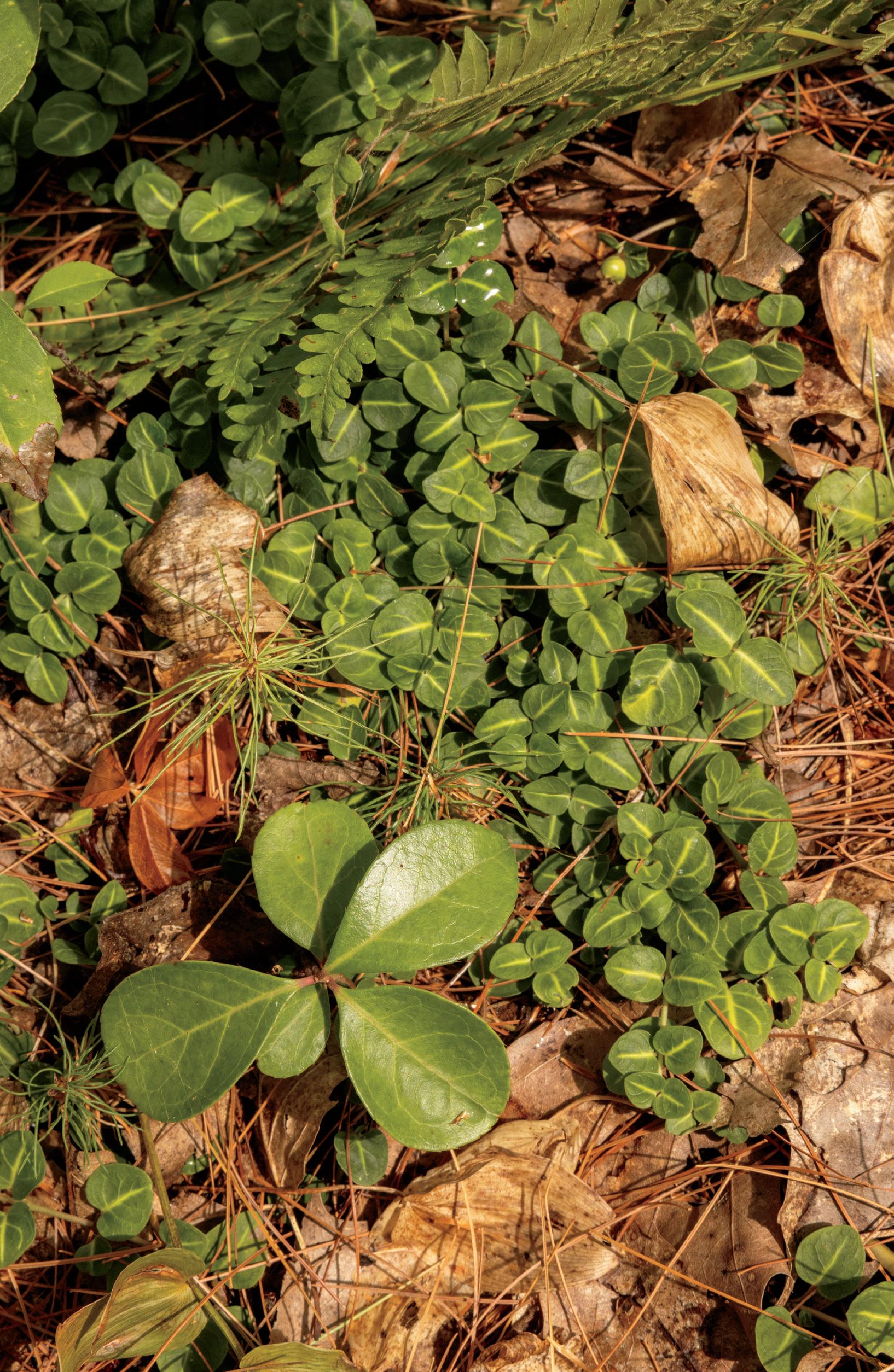
hundred years. It’s what makes foresters conservative with their designs, and it’s why historical records matter. Prior to the committee’s initiative, work hadn’t been done in the Pines since the 1960s, and documentation of it was difficult for Burnett to track down. In deciding how to move forward, Doak and Burnett both had to piece together what had been done in decades past, which included forensic investigations of both the woods and the local historical archives.
“This project is not an every-year type of thing,” says Sprague, as we hide out from the ferocious sun under the shade of an elderly pine. “But we are going to look at the impacts of it over time.” Data sites have been set up throughout the forest, where groups will take regular photos of the same spots and gather observations on the changing conditions. “We want to set up the data so that people in fifteen years can know how things have gone from this plan, and then be able to determine their actions [accordingly],” he explains. Like sunlight, attention to the Pines over time is a valuable resource.
The Pines are busy with activity as we finish our walk. A woman strolls with her limping yellow labrador, and a group of volunteers from the Midcoast Wood Bank collect donated cord wood from the remediation work that they will distribute to community members in need this fall. The forest is a living, breathing thing indeed, as Doak has observed, but in a place like the Bowdoin Pines, humans are just as much a part of the ecosystem as the chipmunks dashing over a downed tree trunk or a pine cone in free fall from the canopy. Sprague and I say our goodbyes, and I embrace another lesson I am learning about the Pines: a single loop on the trail is never enough—the fear of missing out on what the forest will do next is too great. I set my phone on Do Not Disturb and steer my course away from Bath Road and back into the thick woods.
IT’S OVERCAST on today’s visit, but at least the heat is down. In the management area, the light isn’t so blinding as to steal attention from the pines, and now they want mine as I walk through the woods. When I was talking to Burnett, he told me, “In the aftermath of the harvesting, the remaining big trees just pop out,” and today they are particularly arresting—trunks that

would take holding hands with two other people to circle, bark so sturdy as to seem geological, filigree needles by the thousands in every state of bloom and decay.
“White pines hang on to their needles for only a single winter,” explains Barry Logan, director of Bowdoin’s biochemistry program and a professor of biology who holds an occasional class in the Pines. “They grow for a year, they overwinter, and they are active for a year. Then they are shed. That’s like the minimum threshold for being an evergreen.” I’ve asked Logan to tell me why white pines are wonderful, and he comes back with the fact that they are borderline deciduous. In late September to early October, if you head to the Pines, you will see the telltale yellows of fall among the evergreens because the white pine sheds 50 percent of its canopy during the season. A conifer impersonating an oak or a maple—trees that shed 100 percent of their canopy in autumn—that’s a reason to return for another visit after the equinox. In his book The Old Ways, Robert MacFarlane writes that “Familiarity with a place will lead not to absolute knowledge but only ever into deeper inquiry,” and this is my experience having become a regular in the Pines: Every iteration is its own new mystery.
“I’ve been at Bowdoin for twenty-seven years now, and it’s humbling for me to appreciate that I’ve been here long enough for the forest to change while I’ve lived here,” Logan reflects as we discuss the fact that forests aren’t operating on human time scales. “That to me is just an awesome—in the nineteenth-century definition of the word—thing to contemplate.”
Herein lies the opportunity. The slowness of a forest’s evolution allows for a deepening of our inquiry, as MacFarlane puts it. Attention to a place over the course of time—as a field of study and data collection, as an effort to finally create that missing historical record, as a means of enjoyment and escape—maybe that’s stewardship.
Now we watch and wait and allow time to answer the questions posed by the committee and the management plan. Will the seedlings from 2023 take off, or will they need more of a human hand? Is complete removal of plants of concern feasible? What will happen in the reserve area where the intention is to just do




nothing and allow the forest to move on its own? These results will come ten, twenty, thirty years from now. But that doesn’t mean there aren’t results to be seen now. Take the pine warblers, for example. Doak got to know and love them using his birding app. “Those pine warblers are not going to be here if there are no pine trees,” he said when discussing the downstream ecological risks of doing nothing to help the Pines.
“They’ll be someplace else, and that will be fine, but they won’t be here.” It’s a small thing, but ensuring the birds’ home stays intact ensures the accompaniment of their song along the trail. Human impact on the Pines is part of their history and an essential part of their future.
“We’ve entered into the history of this forest by making a decision to do something in 2025,” muses Logan. “We’re making another moment in the story. And one I feel good about.”
Kea Krause is a Maine-based writer who was born and raised in the Pacific Northwest. Her piece “What’s Left Behind” was anthologized in The Best American Science and Nature Writing 2016, and her work has appeared in National Geographic, Wired, and many other media outlets.

INQUIRY.
Greta Rybus is a freelance photojournalist based in rural Maine. Find her work at gretarybus.com.
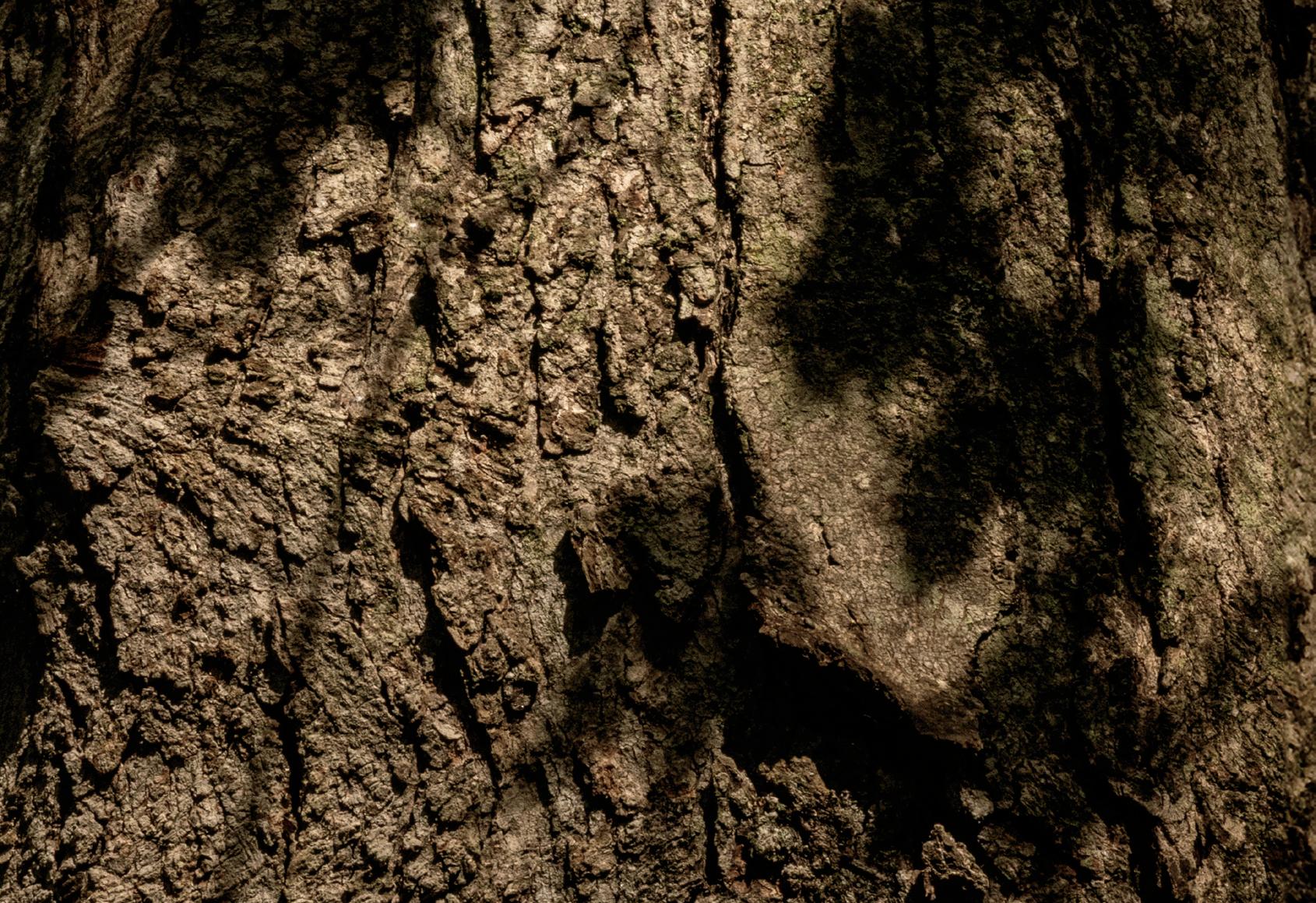
Soccer and swim coach Charlie Butt’s improbable journey from acclaimed Shanghai athlete to legendary Bowdoin coach and national squash champion began with a dramatic swim in a frigid Chinese harbor, a daring escape, and a small brown suitcase. Nearly seventy years after that fateful February day, Charlie’s daughter started asking questions. This summer, she published a book that shares his unlikely and impressive life story with the world.
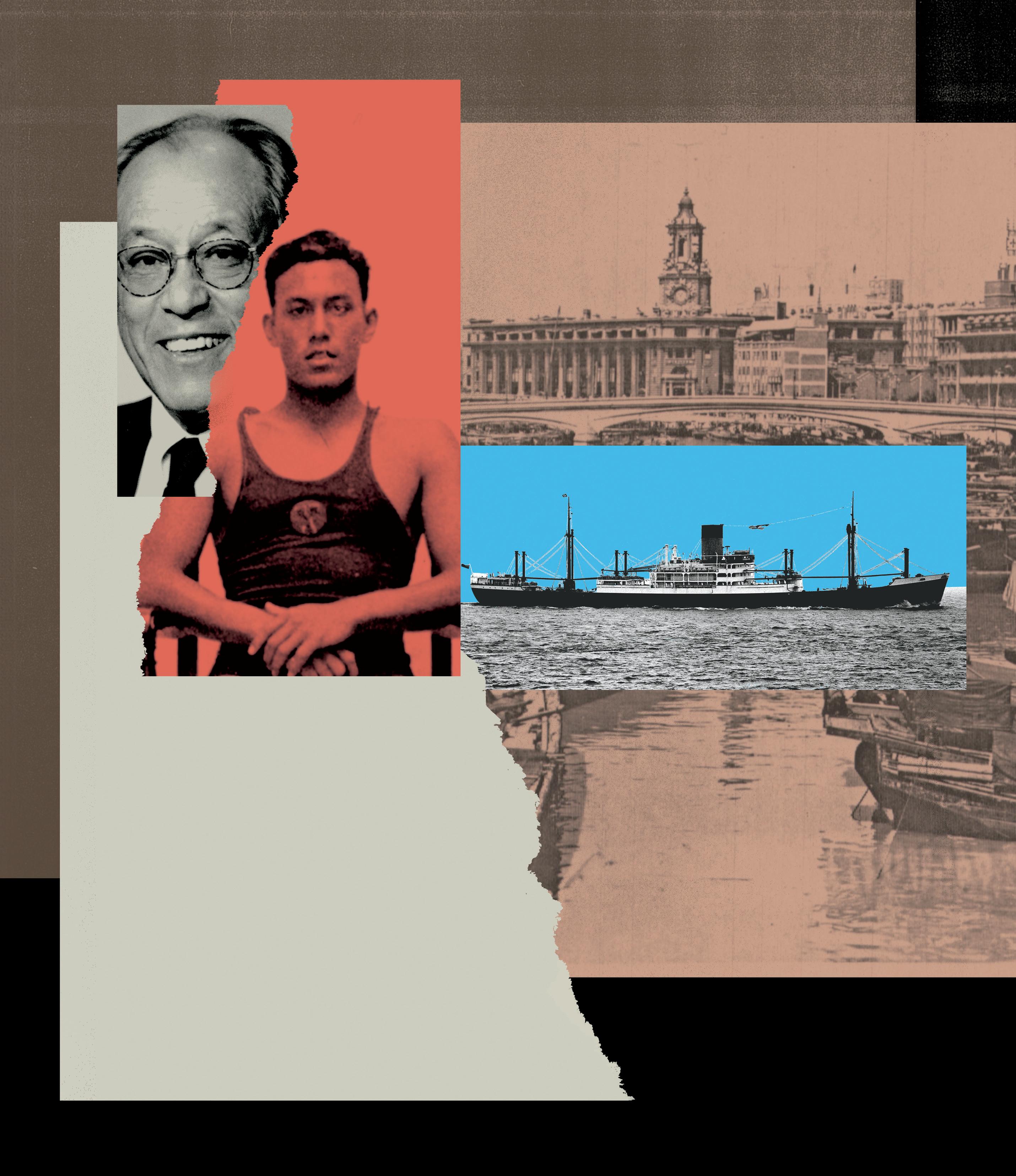
BY IAN ALDRICH ILLUSTRATIONS BY MARK HARRIS
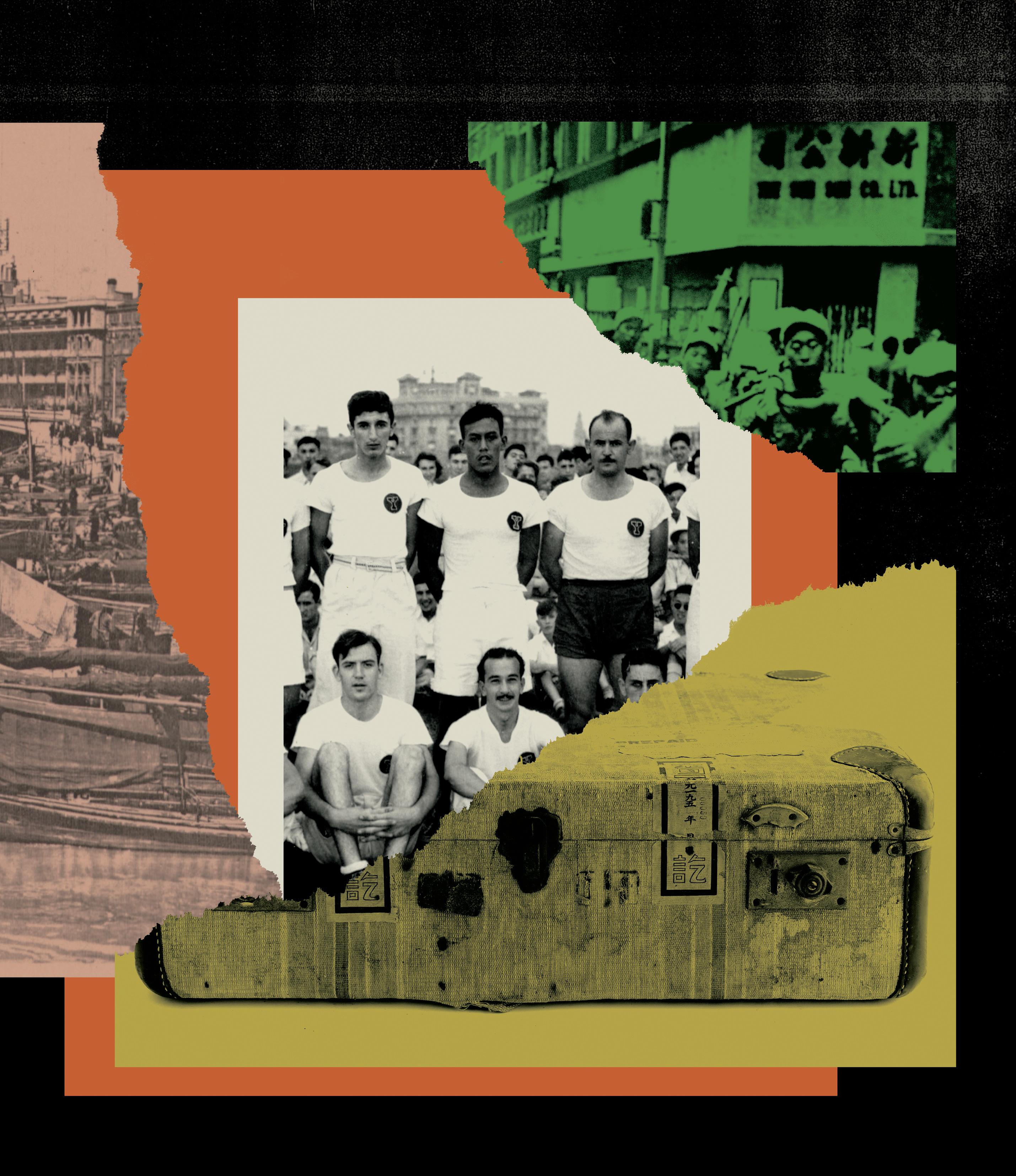

THE SIT-DOWNS felt like a gift. That was overwhelmingly clear to Cathleen “Catie” Butt even in the moment she took her seat next to her father in the solarium of his home in Harpswell, Maine. There, amid the ocean views and a steady rotation of salty snacks, coffee, and visits from his adoring dog, Cosmo, her ninety-three-year-old dad unspooled the story of his fascinating life with an energy and clarity that stood in defiance of his waning health. But then, Charlie Butt had never let an obstacle, no matter its size, get in the way of something he wanted to do.
The prompts he had managed to bring with him when he stowed away on a British cargo ship leaving Tientsin for Hong Kong helped. The yellowed photos of his youth in Shanghai. The weathered newspaper stories documenting his many sports triumphs there. The personal histories and pages of transcripts from a round of interviews that Charlie had given several years before—Catie pored over it all. Who was this person? What happened here? Where was this? How did you get here? After so many years of largely staying quiet about parts of his past, Charlie had at last sat down with his daughter to help him reflect on what had come before.
Opening spread:
Charlie as a Bowdoin coach and as a young athlete in Shanghai; the Race Course, circa 1940, where Charlie competed; a British freighter like the one Charlie stowed away on; Charlie on one of the many YMCA teams he played with; People’s Liberation Army troops march in Shanghai; the suitcase Charlie carried during his daring escape.
Above:
A penny found in the lining of Charlie’s suitcase; the safety belt from his work on the Throgs Neck Bridge; the front of a card sent to Charlie clearing him of tuberculosis; a sampan like the one that rowed Charlie to the freighter in Tientsin Harbor; Charlie in Shanghai in winter; the bow of Trein Maersk and credentials for his work on board; an immigration appointment notification sent to Charlie in Springfield, MA.
“My dad was very good at compartmentalizing his life,” says Catie. “Which is what he needed to do. He wanted to focus on where he was and what he needed to do: creating opportunities, solving problems, and not being weighed down by the past. So, if you didn’t know to ask, you wouldn’t have known he had this whole other part of his life that he had come from.”
A presence on campus for four decades, Charlie needs no introduction to many in the Bowdoin community. He arrived in Brunswick by way of Springfield College and Long Island, New York, in the fall of 1961, and over his career he didn’t just pioneer Bowdoin’s entry into swimming and soccer, he fostered generations of success. The accolades are long: undefeated seasons, New England Championship appearances, rosters of All-Americans, rounds of coaching recognitions, and inductions into various Halls of Fame.
But the familiar story is also incomplete. Charlie’s childhood in a complicated and changing Shanghai, his determined path to America and later Bowdoin, the underpinnings

of his new life in Maine—these were stories Catie Butt wanted to explore when she first sat down with her dad in March 2018. Charlie died that September, but in those final six months together, the two made the most of their time, and the result of those sessions— along with hundreds of hours of research Catie clocked after her dad’s death—is captured in her new book, Charlie’s Way: The Life, Laughter, and Legacy of Coach Charlie Butt. Published in collaboration with Bowdoin College, proceeds from the sale of the book directly fund the Charles J. Butt Scholarship Fund.
“He really was an inspiring person,” says Catie. “He was resilient and hard-working, but he also cared about others and was openminded. He had this incredible life, both at Bowdoin and before it, and I wanted people to know the full story.”
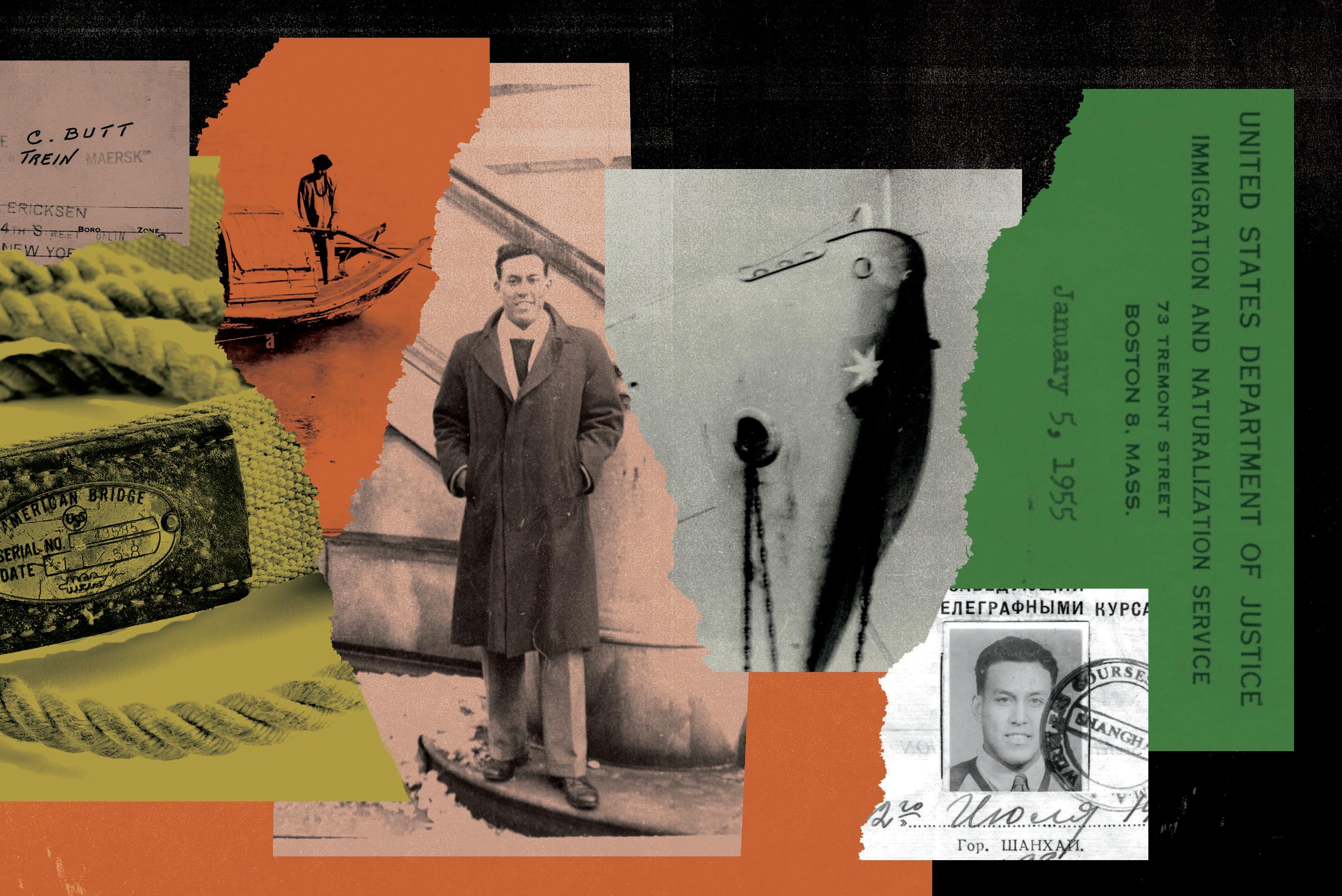
“If you didn’t know to ask, you wouldn’t have known he had this whole other part of his life that he had come from.”
IN THE OPENING PAGES of her book, Catie writes a telling detail about her father. “Dad could only have come from a city like Shanghai, and the more I learned about its history, the more I could see how being not just Eurasian but Eurasian from Shanghai had made Dad the man he became.”
The Shanghai that Charlie Butt was born into in 1925 was a city tumultuously straddling two different eras. As it reeled from the aftershocks of a 1911 revolution that had ended 2,000 years
of imperial rule, Shanghai also became fertile ground for the rise of the Chinese National Party, setting in motion the workings of another kind of national upheaval. Even amid this swirl of competing interests, international commerce furiously grew and modernized the city, bringing not just new roads and hotels but foreign cultures, ideas, and identities to Shanghai life.
“It must have seemed all the world was there,” Catie writes. “The expensive cars of European
merchants and diplomats, the crisp uniforms of British and American sailors on leave, the turbaned Sikhs who formed the backbone of the International Settlement’s police force, the vendors selling everything from cloth to live animals to ta ping yu se kwei, a Chinese take on American fried dough that was one of Dad’s favorite street-food treats, the smells of coal stoves and emptied chamber pots, the public executions and children playing games in the
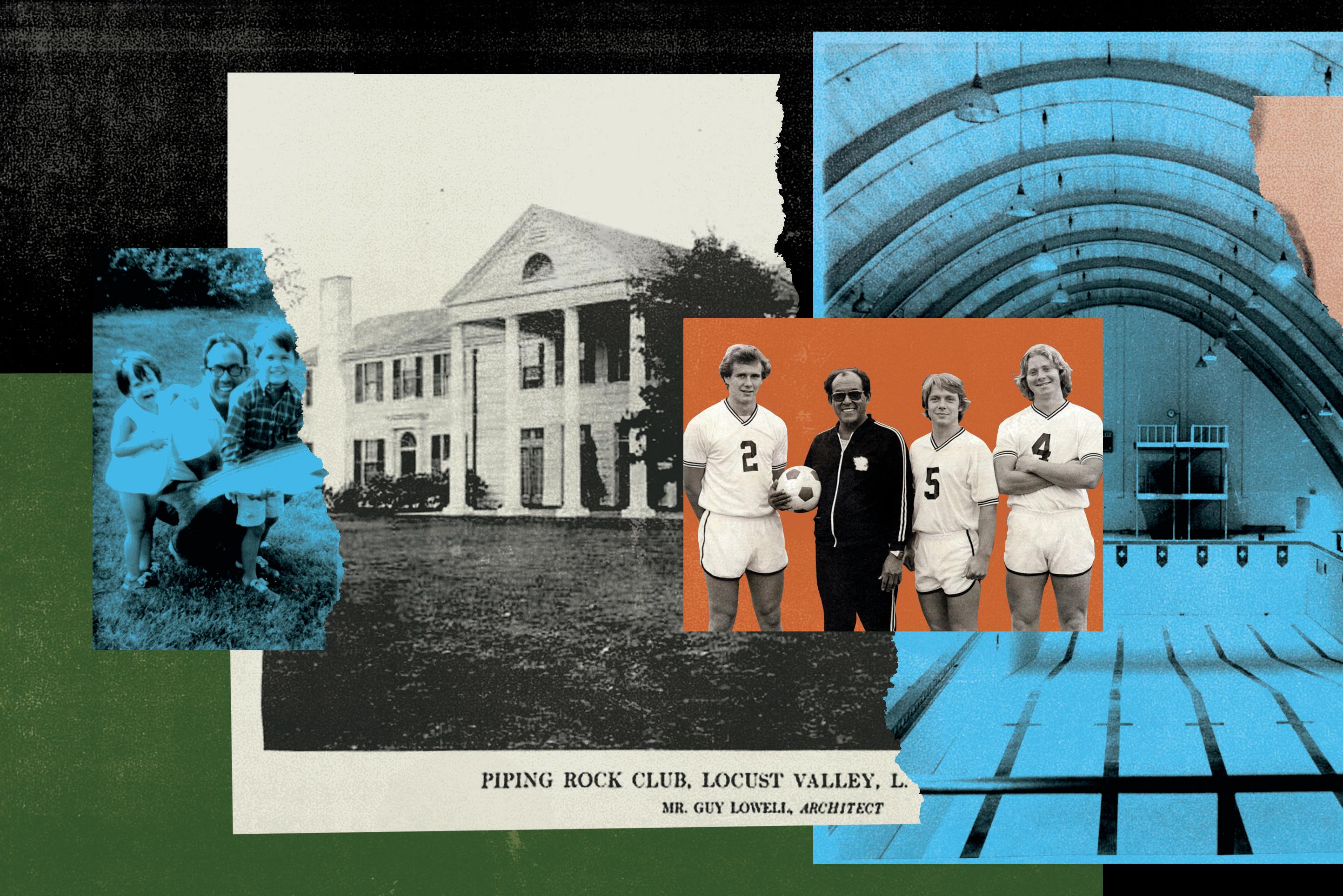
street, the beggars and the laborers, the horns of ships in the harbor and cars on the streets. The world came to Shanghai, and young Charlie Butt soaked it in, waiting for his chance to get out and see it all.”
Charlie was fortunate. Born to ChinesePortuguese parents, his family resided in an area of the city known as the French Concession, an international carve-out established after the 1911 revolution that allowed its residents to largely live under the banner of Western law. As Chinese residents outside the zone suffered under an increasingly repressive national government, those within it led a life with limited restrictions. The friendships and the backgrounds of those whom Charlie befriended cut a wide swath, including “the children of Russian refugees, European diplomats, [and] American missionaries,” writes Catie.
Charlie’s natural ability to make new friends was augmented by his athletic abilities. A theme throughout his life was his knack for excelling at almost any sport he tried. That included a turn to squash in his forties that resulted in twenty-three national championships within his age bracket (singles and doubles) as well as a world title. It began early: boxing, basketball, soccer, tennis, and swimming—these were the sports that Charlie didn’t just instinctively take to as a youth, but shined at.
“I think he really had that in his back pocket all the time,” says his son, Charlie Butt Jr. (known to family and friends as C2). “I don’t know if he knew how gifted he was, but he probably did. He told me stories where he’d be somewhere in New York and someone would be like, Charlie, I watched you play basketball in Shanghai. He was shy and modest about it,

but he also loved it, of course. It was a part of his life.”
His natural gifts, says Catie, were apparent even to the untrained eye. But if that’s all you saw, then you missed what undergirded those physical attributes: his intellectual instincts.
“He somehow had a feel for people and for the game and for strategy and [as a coach] for understanding where to put different players with different skills and strengths,” she says. “You have to be smart in the way you approach a sport, and respectful of the activity and the people involved.”
As Charlie found his footing as an athlete, however, the ground underneath grew more unstable, made more so by the encroachment of World War II. After graduating from Western District Public School in 1941, Charlie enrolled at St. John’s University in Shanghai, but his
studies came to a halt after two years following the Japanese occupation of the city. When the war concluded, Charlie resumed both college and his prolific athletic career. He earned a spot on the national basketball team and set Chinese records in swimming the 50-yard, 100-yard, and 100-meter freestyle. His talent was more than just the stuff of local lore: In 1948, Charlie qualified for the Olympic Games in London in both sports. But his refusal to turn in his Portuguese passport to Chinese authorities put Charlie in the crosshairs of the new Communist government, and in 1951 he made a daring escape to Hong Kong via a British cargo vessel. He eventually made his way to Tokyo, where he secured a visa to the United States to attend Springfield College, where he had been admitted before the start of the war.
Charlie found a new home at Springfield, graduating cum laude in 1953 and later earning his MS. He found equal success as an athlete. Charlie was an All-American soccer player in 1952 and 1953, and he captained both the swimming team and tennis squads. He was also a member of the national championship volleyball team in his first year on campus.
In the fall of 1961, Charlie arrived at Bowdoin as its varsity swimming and soccer coach. It’s unlikely anyone could have forecasted how central he’d be to the College’s athletic programs over the next four decades. Just as it’s equally unlikely anyone, maybe even Charlie, could have predicted the success he’d oversee. His 1962 soccer squad won a share of the first Maine Intercollegiate Athletic Association soccer title, then won it outright in 1965, 1966, and 1968. His 120 career wins are still the most in the program’s history.
As the men’s swimming coach, meanwhile, Charlie steered the club to its first-ever undefeated season during his inaugural year at the helm. The team also placed second at the New England Championships, an accomplishment Charlie’s program achieved four more times. In addition, the coach presided over the launch of the women’s swimming program in 1976–1977. Just a dozen years later, the program finished atop the leaderboard at the New England championships. During his long career, Charlie amassed a record of 132-65 in dual meets with
the women’s team and 198 wins with the men’s squad. Along the way, more than one hundred of his swimmers earned All-American honors. Come summer, Charlie anchored himself as the aquatics director at the Piping Rock Country Club in Locust Valley, New York, an exclusive Long Island enclave “where some of the nation’s most prominent and wealthy families have added their names to the club’s membership rolls,” writes Catie. For fifty-seven years, her father was a beloved fixture of Piping Rock’s summer scene, so much so that upon his retirement in 2010, the club named its pool after him.
Springfield, Bowdoin, Piping Rock—at the time Charlie walked through their respective doors, these were not environments that necessarily had a long history of welcoming young Chinese immigrants into their ranks. But Charlie broke through in part because, as good as he was at assimilating to new environments, he also never strayed from who he was. In her book, Catie quotes her father’s recollection of his job interview at Piping Rock. Charlie wasn’t blind to the world he was walking into, and he was determined to make sure the club’s directors also weren’t blind to how he expected to be treated.
“I met with three or four people individually,” Charlie remembered. “I wondered if he was thinking how he was going to put Charlie here with all us white, Protestant buggers? A strange-looking man from out of nowhere. I was Asian, with dark skin, and there was a lot of anti-Asian sentiment those days. So, finally they said they wanted to proceed. And I said, ‘Okay.’ So, then I thought about the conditions I had heard about and that we could potentially have. I said, ‘Let’s get something straight right away if I’m going to be a teacher here. I am used to teaching at a college. When people come up to me here, you pay me that respect. I’ve heard that some pros are treated like servants, and I won’t have any of that. I’m a teacher, I’m a coach, I will run the program. I want people to call me Mr. Butt or Charlie with the right tone. I heard you say earlier that I could go eat in the back room with the chefs and all of that. No, if I’m here, I’m going to eat out here with the members and everybody else.’”

This was not an isolated moment. Charlie’s sense of fairness—for himself and those around him—was as much a part of his identity as the white sun hat that was perched atop his head during his days at Piping Rock. To know her father, says Catie, was to know a person whose empathy, courage, and authenticity helped explain how he was able to make the long journey from Shanghai to Brunswick.
“He knew he came from different circumstances,” she says. “That he had a different background and looked different in a lot of environments. But he was not going to allow those things to stand in his way.”
CHARLIE’S WAY was a true labor of love for Catie Butt—and at times became its own kind of challenging journey for her. Working around her own busy career as a corporate attorney, the
pandemic, and, of course, the loss of her father as she embarked on the research, she took some ten years to complete the project. But Catie didn’t cut any corners. She read deeply about the history of Shanghai, including personal accounts from those who’d grown up in the city during the time her father was a boy. She unearthed old newspaper articles, sifted through piles of photographs, and studied folders of letters written to the family after Charlie’s death—all in a dogged attempt to better understand her father and the different lives he’d led.
“I really came to appreciate the impact my dad had on so many different lives and all the different branches of what he would do for people,” says Catie.
In all, she also interviewed more than sixty people who were associated with her father for the book. Friends, colleagues, students—the narrative is chock full of accounts of those who found their own lives enriched by their connection to Charlie Butt.
“Charlie inspired us all,” said Rob Moore ’77, cocaptain of the New England champion, NCAA-semifinal-reaching Bowdoin squad in 1976 who went on to play professionally and was a winning coach. “I played soccer for him for four years and learned so much. He had a way of letting us play the game, not micromanaging, but teaching us through his positive attitude, his electric energy, and his constant support. We won so many games in my four years. He knew which players to play and where to get the most out of them on the field. I consider him one of the best coaches I’ve ever had.”
In one instance, Catie used a family trip to Florida to visit Betty Grebenschikoff, a childhood friend of her dad who has since also died. “She was the only living member of that whole crew, and her memory was rich and perfect,” says Catie. In another, she interviewed a group of Division III swimming coaches from across the country who invited her to join them on their monthly Zoom call. “They talked about their business stuff at the top of the meeting and then let me have the last three-quarters of the call to just ask questions and collect their stories about my dad,” she says.
Catie also labored over the writing. By 2019 she had drafted fifteen chapters, but scrapped
“I really came to appreciate the impact my dad had on so many different lives and all the different branches of what he would do for people.” —CATIE BUTT
them all because the storytelling wasn’t where she wanted it to be. In her own research, she had struggled through a number of poorly written memoirs and histories. If she was going to honor the richness of her father’s life, Catie says she wanted to publish something that people would actually want to read.
“I thought a lot about what I wanted to include,” she says. “Just because something was interesting to me didn’t necessarily mean it would be interesting to someone else. I’d never done anything like this.” She laughs. “I write contracts and PowerPoint presentations. But I wanted [this book] to be an easy read so that even if you didn’t know my dad, you’d find the book enjoyable.”
But Charlie’s Way is also a family record. An in-depth attempt to not just document Charlie’s full life, but also to remind those who have and will come after him who they come from and what they are also capable of. C2, who read an early draft of the book, thinks his sister has accomplished that in spades.
“Rereading the history, and just having it put together chronologically in a much more defined way, allowed me to learn more about how he grew up,” says C2. “I’ve got four kids here now, and they all loved him and enjoyed the time they had with [their grandfather]. So, I think having them understand more of who he was is really powerful for the family.”
ON A FRIDAY in early July, I met with Catie Butt in Morrell Lounge in Bowdoin’s Smith Union. She is tall and athletic and carries herself with the measured demeanor of someone accustomed to navigating highly competitive spaces, from corporate boardrooms to the swimming pool (she was an All-American swimmer at Ohio Wesleyan University). In tow was a copy of Charlie’s Way, which had just been published
a few days before, and a poster announcing its arrival hung on a nearby wall.
It was a fitting place to meet. When they were kids, Bowdoin was a second home for Catie and her brother, including the building where we met, which in a previous life was an athletic center, Hyde Cage, with an indoor track above the main floor. Catie motioned above where we were sitting. “We spent a lot of time up there,” she said with a laugh. And elsewhere. They raced around the grounds of Whittier Field, played hide-and-seek among the pines that tower over the stadium, and rang up their father’s charge account at Moulton Union Dining Hall. “We knew every nook and cranny of these buildings. This is where we grew up, in a sense. Just little brats running around, and not always with adult supervision. If our friends were with us, their parents knew exactly where they were. We were at Bowdoin, and that was okay.”
Charlie established a part of his life at Bowdoin, and in doing so, so did his children.
As high schoolers, Charlie Jr. and Catie used the campus facilities as their own training ground. Charlie Jr. practiced hockey and soccer, Catie swam and ice skated, or stationed herself in Gibson Hall to rehearse piano.
“At my dad’s ninetieth birthday, there was a big party for him [at Bowdoin] the alums had organized,” Catie recalls. “When I spoke that night, I said I felt like an honorary Polar Bear for sure, and people totally got that. There’s a real association that we feel to this institution.”
After we talked, Catie and I walked across campus to her car, where she had a few items from her father’s life to show me. There was a pair of plaques that honored his recognition as an All-American college soccer player in 1952 and 1953. Tucked around them was an even more important piece of family lore: the safety belt Charlie used in the late 1950s, when
he was hired as a diver to retrieve tools that workers accidentally dropped in the East River during the building of New York City’s Throgs Neck Bridge.
“Throughout his life, whenever the bridge came into view, Dad never missed an opportunity to ask any members of our [usually eye-rolling and grumbling] family who were within earshot, ‘Did I ever tell you how I helped build that bridge?’” Catie writes in Charlie’s Way. “The more the story was told, the more he seemed to enjoy impishly concluding that construction of the Throgs Neck Bridge would never have been completed without him.”
But these pale in comparison to what Catie has also brought: her father’s suitcase from Shanghai. It’s worn and slightly stained, but all of its handsome features remain: its leather trim, its metal locks, its decorative colored stripes. A faded prepaid label still clings to its top.
The suitcase is also impressively small— maybe two feet wide. But oh, what it packed. Not just clothes and mementos, but dreams and hopes. Looking at it now, it’s awe-inspiring to think about all that emerged from this single piece of luggage. The young lives Charlie mentored. The family he built. The unique friendships he forged. The unmatched legacy he left behind.
And it all started with a swim.
Ian Aldrich is the deputy editor at Yankee Magazine.
Mark Harris is an award-winning graphic designer whose work has been featured in The New York Times, The Atlantic, and many other publications. See more of his work at mrkhrrs.com.
All funds raised from the sales of Charlie’s Way support the Charles J. Butt Scholarship Fund at Bowdoin College. To purchase the book, go to bowdo.in/charlies_way.
Sam Brody ’92 arrived at Bowdoin dreaming of writing novels, but a single course changed his path—now he is a professor at Texas A&M and an expert on flooding and resilience.
Interview by Scott Hood
You came to Bowdoin thinking you’d be a novelist. How did that change?
I had a love affair with Maine, and when I decided I was going to be the next great American author, my English teacher in high school said, “Well, you know, Bowdoin College is where Hawthorne and Longfellow went.”
Two weeks into my first year, I decided I probably wasn’t going to be the next great American author. Then, I took Environmental Studies 101, taught by Ed Laine, and that changed my life.
What did you learn at Bowdoin that carried into your career?
Bowdoin was about the place and the landscape, and my ES major gave me more access to the surrounding area. I could really explore and learn about the physical environment and human impacts. I had some great, inspirational teachers and mentors. They got me to where I am today.
Why was the Hill Country flood in Texas so devastating?
It’s a symptom of what is always going wrong in this country—putting people and structures in harm’s way. Knowing or ignoring the risk. There were communication issues and warning system issues, but the fundamental problem is putting those cabins, and those people, in the most flood-prone area in a flood-prone region. It’s the same problem as paving and developing in Houston, where we had the largest urban flood event in US history in 2017. It’s the same as loading up risk in Southeast Florida on the coastline. It’s really where we put the built environment without accounting for the risk.
Why is media work important to you?
During Hurricane Harvey, I wanted to check on our neighbor and rescue this person, and
my wife looked at me and said, “You are not someone who’s going to rescue. Go talk to the media. That’s your job. And she was right. I gave dozens of interviews, and I’ve continued ever since. Scientific articles get peer readers, but media lets me tell the story to millions. It’s a way to create awareness and talk about these fundamental problems.
What role do natural systems play in mitigating floods?
I’ve done decades of research on wetlands. Freshwater wetlands are the best naturally occurring flood mitigation devices out there, better than anything we can construct. I’m a big proponent of protecting natural wetlands— not just for habitat and water quality and aesthetics, but specifically for flood mitigation. When we alter a wetland, we’re not just giving up storage. We’re replacing it with parking lots and rooftops that accelerate runoff into downstream communities.
Are FEMA flood maps reliable?
The 100-year floodplain map is supposed to show where there’s a 1 percent annual chance of flooding. But in urban areas we see an unacceptable percent of impacts outside that boundary. In Houston, more than half of insured claims are outside the FEMA map. Nationally, it’s about a third. That’s why we created [the] “Buyers Aware” [app]. It’s like Zillow meets risk. You type in an address, and you can see your flood or fire risk in a simple format, plus what you can do to mitigate it.
What about rebuilding?
The big problem is we rebuild the same thing in the same location and expect a different outcome. Each community has its own
characteristics, but the toolbox is the same: avoid, resist, accommodate, and communicate. Avoid the highest-risk areas. Resist with structures like levees or reservoirs. Accommodate by letting wetlands or parks flood. And communicate risk clearly, so people actually understand. Too often we just throw in a new warning system that gives false confidence and spurs more risky development.
You’ve also been back in Maine recently, helping shape policy after major storms. What did that mean to you?
It was full circle. At Bowdoin I studied Merrymeeting Bay, looking at how towns’ plans and policies affected the ecosystem. Decades later, I came back to work on the governor’s commission and help write Maine’s “Eye of the Storm” report. I was applying the same regional thinking I first learned as a student. Some of the very people I learned from were still around. It was surreal and deeply rewarding.
Are you optimistic about society’s ability to deal with these issues?
I am. After Hurricane Harvey, Texas said enough’s enough. They poured billions into resilience and passed some of the strongest disclosure laws in the nation. If it can happen in Texas, it can happen anywhere. We still move in the wrong direction sometimes, but I’ve seen wonderful changes that make me hopeful.
And the novelist dream?
I want to write historical fiction when I retire. For now, the stories I tell are about floods, resilience, and how to build a safer future.
Sam Brody ’92 is a professor at Texas A&M and directs the Institute for Disaster Resistant Texas.


Tracing the history and renewal of a Bowdoin tradition.
ALONG WITH “The Offer of the College” (adapted from the opening lines of The College Man and the College Woman, by Bowdoin’s seventh president, William deWitt Hyde, in 1906) and a quote about the common good (taken from the inaugural address of Joseph McKeen, Bowdoin’s first president), the “Bowdoin Hello” has become part of the College’s identity for incoming students and their families.
Despite references that attribute the tradition to 1960s fraternity rules for freshmen pledges, the “Bowdoin Hello” dates to the administration of President Hyde (1885–1917). The tradition is in keeping with Hyde’s philosophy about building community and would no doubt have been mentioned by him in daily chapel services that students were expected to attend. The phrase first appears in the pocket-sized Student Handbook for Bowdoin College, initially published in 1892 by the YMCA. Among the “pointers for freshmen” is the following advice: “Say ‘hello’ to every Bowdoin man, even if you have never ‘met’ him.”
In the fall of 1892, there were 196 undergraduates at Bowdoin, the curriculum was prescribed for each class, fraternities inspired loyalty and fueled rivalries, and Phi Chi, the sophomore hazing society, enforced “discipline” on first-year students. Occasional scuffles between Bowdoin
students and “yaggers” (Brunswick boys and men from the other side of the railroad tracks) caused the internal divisions among the students to evaporate while facing a common foe. Thus, the Bowdoin Hello helped to counter divisive elements in campus life.
The YMCA was succeeded by the Bowdoin Christian Association (1926) and the Inter-Faith Forum (1955), but the description of the Bowdoin Hello remained virtually unchanged until the final issue of the handbook in 1968: “Bowdoin ‘hello’—In keeping with the democratic traditions of the College, students always speak to one another on the campus and downtown. In the passage of time, this ‘Hello’ has developed into a genial ‘Hi.’”
In practice, the Bowdoin Hello has waxed and waned in popularity over the years. With the abolition of Phi Chi in 1934, the successor Student Council Disciplinary Committee was criticized for allowing the tradition to fall into disuse. It was revived in the ’40s, ’50s, and ’60s, but after the last edition of the handbook was published, it again nearly disappeared from campus. After a hiatus of five years, the College issued its own student handbook, crammed with useful and necessary information for surviving in a complex academic environment, but without mention of the “Hello.” A quick search in back issues of The Bowdoin Orient between 1972 and 1999 uncovered only three brief mentions of the “Bowdoin Hello.” It wasn’t until Barry Mills’s presidency that it regained some traction, especially on campus tours and in welcoming remarks for incoming students. In 2017, the Bowdoin Student Government passed a resolution requiring that its members “shall render a genuine Bowdoin Hello when passing another person on a Bowdoin thoroughfare.” The Bowdoin Hello has also been the subject of Commencement and Baccalaureate speeches in recent years.
It’s a tall order to expect that more than 1,800 students will greet fellow students on campus and in town with the Bowdoin Hello, especially in a world where ear buds can bring podcasts, music, and phone conversations into a realm of personal privacy and where smartphones provide access to information superhighways. What worked for an all-male student body of 196 in 1892 may not translate directly to the lived experiences of 1,841 students on campus of different genders. I’m glad that some students are inspired by this long-standing tradition, but the spirit of seeing and appreciating those around us transcends the word “Hello.”
As my daughter reminded me, perhaps the Bowdoin Hello, like other important things in life, is something that can be given or accepted, but never taken or mandated.
John R. Cross ’76 is secretary of development and college relations.
When I was about four, my father told me I was “not meant to work for the man.” I believe that planted the seed for me to be an entrepreneur. My beauty tech startup, on the go GLAM, happened by mistake. I had no background in tech or beauty, but there was a need, and I was the target audience. I wanted my makeup done at seven in the morning for an event, and everything was closed. I thought, “I wish there was an app where I could book someone to do my makeup in my hotel room.”
Now I am a serial entrepreneur. In my management consultancy, every client is different, and people are at the core of what I do in all my ventures.
I’m actually very private, though, and never imagined I would go on a dating show. During the pandemic, a few casting directors reached out on Instagram, and after a lot of hesitation, I decided to interview for the reality show Ready to Love. It was vulnerable and at times uncomfortable but ultimately freeing. Although I did not find love, I learned so much about myself—what I need, what I won’t tolerate, and how to remain authentic even under a spotlight. The hardest part for me was losing my sister, Giana, unexpectedly while I was filming and having to live through that in the public eye.
One of the most powerful experiences I had at Bowdoin was performing in The Vagina Monologues. Giving voice to stories of womanhood, pain, resilience, and joy set me on a path for how I show up today as a leader, founder, and advocate for women.
I’m inspired by women who own their truth unapologetically. Seeing people bet on themselves and win. I’m especially inspired by those who’ve faced adversity and who are navigating systems that weren’t built for them.
For more from this interview, visit bowdoin.edu/magazine.

Business coach, strategist, tech entrepreneur, dynamic speaker, and self-described introvert Joy M. Hutton ’04 says her social and cultural experiences at Bowdoin taught her to speak up, not shrink.
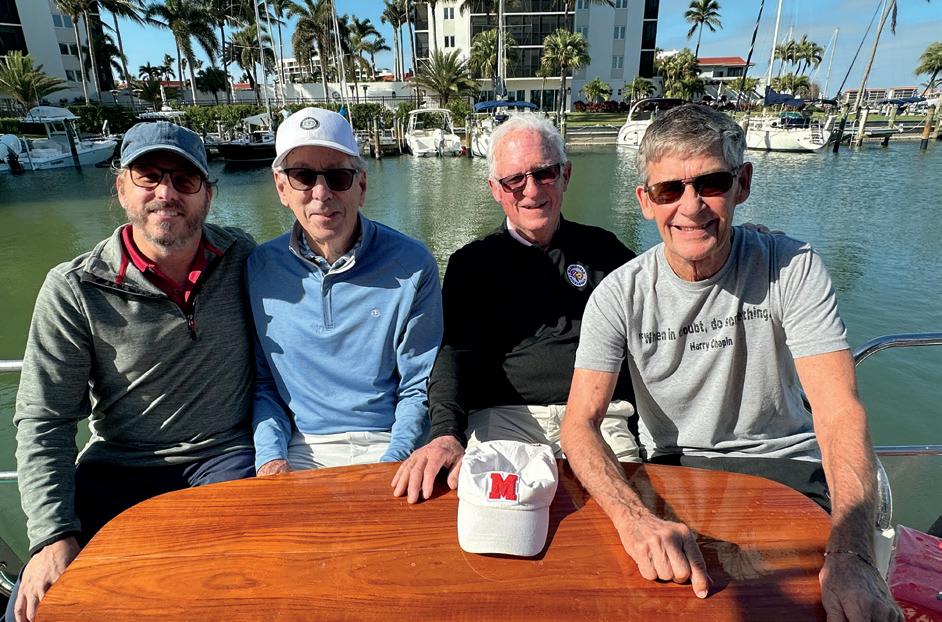

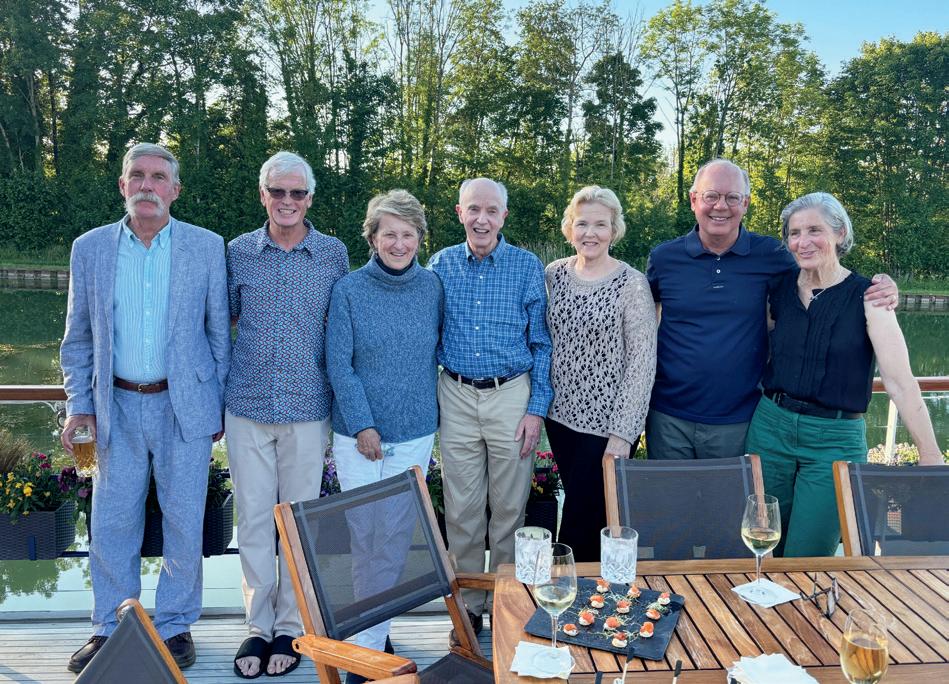
From a bowdoin.edu/news story, June 17, 2025. David Treadwell Jr. has been honored by the Alumni Council with a Polar Bear Award. Through his long involvement with Bowdoin’s host parent program, Treadwell has provided warmth, guidance, and a sense of belonging to students from all walks of life. He is an advocate for young people, consistently offering mentorship, encouragement, and a welcoming presence both on campus and in the greater Brunswick community. Treadwell has served as assistant secretary to the board of trustees, participated in numerous class reunion committees, and supported Bowdoin’s Office of Career Exploration and Development (CXD) as a mock interviewer. Established in 1999, this award recognizes significant personal contributions and outstanding dedication to Bowdoin, honoring a record of service rather than a single act or achievement.
From a bowdoin.edu/news story, June 17, 2025. Roger Tuveson has been honored by the Alumni Council with a Polar Bear Award. Through decades of exemplary volunteer service, Tuveson has served as cochair of numerous reunion committees, supported the Annual Fund as a class agent, volunteered for admissions, and contributed to the Bowdoin College Athletic Hall of Honor as a member of the selection committee. Tuveson has been a fixture for years as an enthusiastic alumnus and parent— and as a fan of Bowdoin’s women’s hockey, women’s basketball, field hockey, swimming, and baseball teams. He is a proud grandparent of members of the Classes of 2017 and 2022. Established in 1999, the award recognizes significant
personal contributions and outstanding dedication to Bowdoin, honoring a record of service rather than a single act or achievement.
From Wayne Burton: “A historic moment it was on the floor of the New Hampshire House when the pragmatic representative and distinguished attorney Walter ‘Terry’ Spilsbury ’76 and I, the idealistic EdD, debated a bill I supported allowing high school students to gain financial credits toward higher education by performing public service. Alas, idealism bowed to pragmatism and lost the vote 206 to 162 (the motion was to kill the bill) with most Republicans voting to defeat the bill and most Democrats voting for it. So it goes these days. But this country was born in a burst of idealism requiring us to combine both if we are to leave this planet better than we found it. I thought I saw [George] Washington smile a bit in the portrait behind the podium. Maybe it was the light.”
From a bowdoin.edu/news story, June 17, 2025. Thomas Sides has been honored by the Alumni Council with the Foot Soldier of Bowdoin Award. Sides’s dedication to Bowdoin and its community and his belief in the common good and in paying it forward have been heralded as remarkable, as has his care for the College, his understanding that it must grow and evolve with the times, and his active encouragement that it do so. After serving on his fiftieth reunion committee, he became a class agent and since that time has been a stalwart volunteer, serving as cochair of his fifty-fifth reunion
Remember
The following is a list of deaths reported to us since the previous issue. Full obituaries appear online at: obituaries.bowdoin.edu
Philip B. Thomas ’37
July 23, 2025
Robert N. Cleverdon ’44
August 26, 2024
H. Willis Day Jr. ’47
July 25, 2025
Willard C. Richan ’49
June 23, 2025
Bernard D. Barton ’50
April 19, 2025
Noel V. Coletti ’50
June 22, 2025
Robert J. Waldron ’50
March 2, 2025
Robert S. Bernson ’55
July 15, 2025
Peter M. Pirnie ’55
November 17, 2024
Robert H. Trask Jr. ’55
May 8, 2025
Michael A. Coster ’57
May 22, 2025
Gerald L. Evans ’59
June 22, 2025
George D. Leavitt III ’59
June 22, 2025
Deane B. Turner ’59
June 16, 2025
Robert L. Baldwin ’60
July 5, 2025
Harwood Ellis Jr. ’60
May 18, 2025
Robert E. Knowlton ’60
June 16, 2025
Duncan B. Oliver ’60
June 10, 2025
Robert N. Smith ’60
May 24, 2025
Lyman A. Cousens ’61
April 24, 2025
John W. Reynolds ’61
April 23, 2025
Timothy W. Currier ’62
June 1, 2025
H. Wilson Eastman ’62
July 26, 2025
Stevens W. Hilyard ’62
April 27, 2025
Thomas F. Lockwood ’64
September 2, 2024
K. William Clauson ’65
July 31, 2025
Timothy J. Robinson ’65
April 27, 2025
Berle M. Schiller ’65
July 22, 2025
Roy C. Boon ’66
June 19, 2025
William Margolin ’67
July 22, 2025
Warren I. Beckwith Jr. ’68
May 17, 2025
Harvey M. Davis ’68
February 14, 2025
Glen L. Ortman ’69
August 3, 2025
Stephen M. Weld Jr. ’69
June 25, 2025
Robert F. Eddy ’70
July 7, 2025
George M. Walker II ’71
April 18, 2025
Robert D. Buckland ’72
August 6, 2025
Charles J. Lemay ’72
May 22, 2025
Ann Frick Blair ’77
May 5, 2025
David C. Sweetser ’77
July 19, 2025
Thomas T. Pennington ’78
May 6, 2025
Sarah E. Hughes ’81
July 13, 2025
Michael C. Szwajkowski ’88
July 10, 2025
GRADUATE
Richard N. Leavitt G’71
June 21, 2025
Theresa L. Bernier
June 19, 2025
John M. Karl
June 27, 2025
Mary Jo Maguire
May 20, 2025
Bowdoin obituaries appear on a dedicated online site, rather than printed in these pages. Updated regularly, the improved obituary format allows additional features that we can’t offer in print, specifically the ability for classmates, families, and friends to post photos and remembrances.
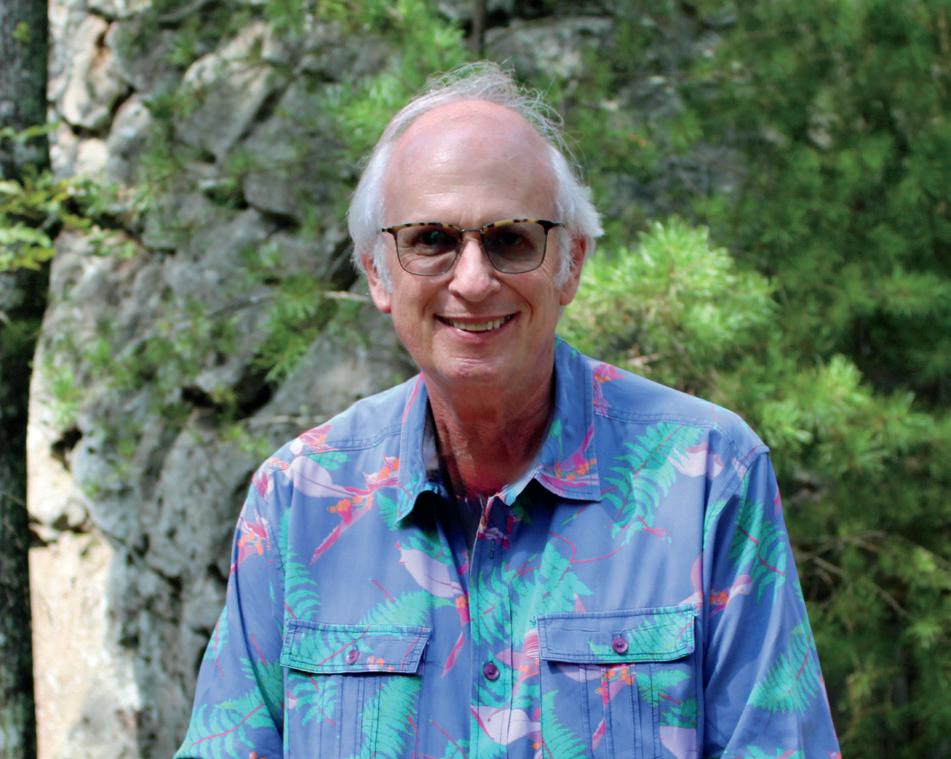
An expert in the psychology of aging, Sam Popkin ’77 describes his own life as a series of scenes in a new memoir.
IN HIGH SCHOOL, I was focused on pursuing a music degree. When I visited music schools I was interested in, I felt completely out of place. My mother’s college roommate was the wife of Joe Kamin, public relations director for Bowdoin. They strongly encouraged me to apply. I feel lucky to have stumbled upon Bowdoin.
PROFESSOR MATILDA WHITE RILEY, with her area of expertise in the sociology of aging, was a terrific role model. Until my retirement, I was engaged in clinical psychology work that brought hope to many who felt hopeless—and skeptical about receiving mental health services from the Department of Veterans Affairs. I have been told over the years by many veterans that, had they not met and worked with me, they would have suicided. I’m not sure anything could be more rewarding.
SINCE RETIRING, I am more in touch with and considerate of my mortality and the reality that our lives are temporary. I have done a lot of planning. One of my preparations is a memoir I wrote over the past year, Scenes Through the Narrow Window WHEN I WAS ON MY WAY OUT OF BOWDOIN, I was saying goodbye to Professor of Music Elliott Schwartz. He looked at me and said with a smile, “You would have made a great music major.” How beautiful and ironic is that?
For more from this interview, visit bowdoin.edu/magazine.
committee and as a fund director, sharing his insights with younger generations. The Foot Soldier of Bowdoin Award was created by the Alumni Council in 1999, to honor “one who exemplifies the role of a foot soldier of Bowdoin through his or her work” for the College. It was created through the generosity of David Z. Webster ’57
From a Greenberg Traurig LLP press release, August 21, 2025. A. John Pappalardo, a shareholder in Greenberg Traurig LLP’s Boston office, was selected as a Massachusetts Lawyers Weekly 2025 Hall of Fame honoree. The Hall of Fame recognizes top Massachusetts lawyers who have been practicing for thirty or more years and who have made significant contributions to the development of the law and bar while improving the quality of justice in the Commonwealth. Pappalardo and fellow inductees will be honored at an annual awards ceremony in Boston on September 16. Pappalardo is a founding member of Greenberg Traurig’s Boston office. During his fifty-plus-year career, he has conducted many significant representations, tried landmark cases, and represented Fortune 500 companies in connection with their business dealings in Massachusetts and across five continents. His international practice focuses on federal white collar criminal defense, representing corporations and individuals in federal and international investigations. He has served as lead counsel in many high-profile cases, including representing former YUKOS Oil Company CEO Mikhail Khodorkovsky in historic
fraud and tax evasion trials in Moscow from 2003 through 2009. Prior to entering private practice, Pappalardo served as US Attorney for the District of Massachusetts, where he led successful prosecutions including cases against a US congressman, the head of New England organized crime, RICO cases against corrupt police officials, and international conspiracy involving US residents and the Irish Republican Army. His nine-year tenure in the US Attorney’s Office also included roles as chief of the public corruption unit, chief of the criminal division, and First Assistant US Attorney. Pappalardo is regularly recognized for his legal contributions by top publications, including Law360, Best Lawyers in America, Who’s Who in American Law, Super Lawyers of Massachusetts, and New England Super Lawyers
From a bowdoin.edu/news story, June 17, 2025. Caroline Curtis has been honored by the Alumni Council with a Polar Bear Award. A member of one of the first graduating classes at Bowdoin to include women, Curtis was a cochair of the host committee for Leaders in All Walks of Life: Celebrating Fifty Years of Women at Bowdoin. During her service on the Alumni Council, she was a steadfast supporter of the Maurice B. Littlefield Alumni Council Internship Fund. She also volunteered for her class reunion committees and served as alumni marshal at her fiftieth reunion in 2022. Established in 1999, the award recognizes significant personal contributions and outstanding dedication to Bowdoin, honoring a record of service rather than a single act or achievement.
From Linda Durfee: “Linda Durfee proudly attended University of Kentucky graduation in May, when her daughter, Katherine Henneberger ’20, received her PhD in mathematics.”
From a bowdoin.edu/news story, May 14, 2025. Michael Fiore was awarded one of medicine’s top prizes for anti-smoking efforts at the annual meeting of the National Academy of Medicine (NAM) in May. “It is quite likely that today we know someone who is alive because of Michael Fiore,” said Dr. Clyde Yancy. Fiore, he stressed, is “responsible for saving untold thousands of lives.” Yancy was on the selection committee for the 2024 Gustav O. Lienhard Award for Advancement of Health Care and was speaking at the meeting. Established by NAM in 1986, the Lienhard Award honors individuals for exceptional contributions to improving US health care services. Fiore has devoted his career to advancing science and promoting policies that collectively aid individuals in their efforts to overcome tobacco dependence. Fiore, the University of Wisconsin Hilldale Professor of Medicine, cofounded the University’s Center for Tobacco Research and Intervention in 1992 and chaired the organization until last year. He has produced hundreds of articles, chapters, and books on tobacco addiction and contributed to US Surgeon General reports on the subject. His achievements also include setting up the 1-800-QUITNOW nationwide hotline in 2004 and helping draft federal guidelines on smoking treatment. Fiore is a nationally recognized expert on quitting smoking who has shared his insight with, among others, the US Senate and the audience
of Good Morning America. In 2009 he earned the Common Good Award from Bowdoin, given by the McKeen Center to alumni who have “demonstrated an extraordinary, profound, and sustained commitment to the common good, in the interest and for the benefit of society, with conspicuous disregard for personal gains in wealth or status.” In his acceptance speech, Fiore pointed out that, although smoking rates have declined substantially since the 1960s—from around 45 percent of adults to around 11 percent today— 15 million Americans are still expected to die over the next few decades from a disease directly caused by their smoking. The risks of smoking are generally regarded as “yesterday’s news,” he said, because most of those affected are “the poor, the least educated, and those with mental health and substance abuse diagnoses. I dedicate the award to them,” added Fiore, “and to our continued effort to truly eliminate tobacco dependence from our society.”
From an Alaska Bar Association news article, April–June 2025. Everett Billingslea was one of several attorneys who reflected on running Alaska’s 2025 Mount Marathon Race in an Alaska Bar Association publication. The event takes competitors a thrilling 3.1 miles and 3,000 feet up the beautiful peak overlooking Seward, and then a brutal 3.1 miles and 3,000 feet back down to the finish line. Held every Fourth of July, this year’s race was its ninety-seventh iteration. Billingslea has run it forty-two times, competing nearly every year from 1980 to 2023. He is one of only six men who can say they have completed over forty Mount Marathons, and he doesn’t plan to miss a race
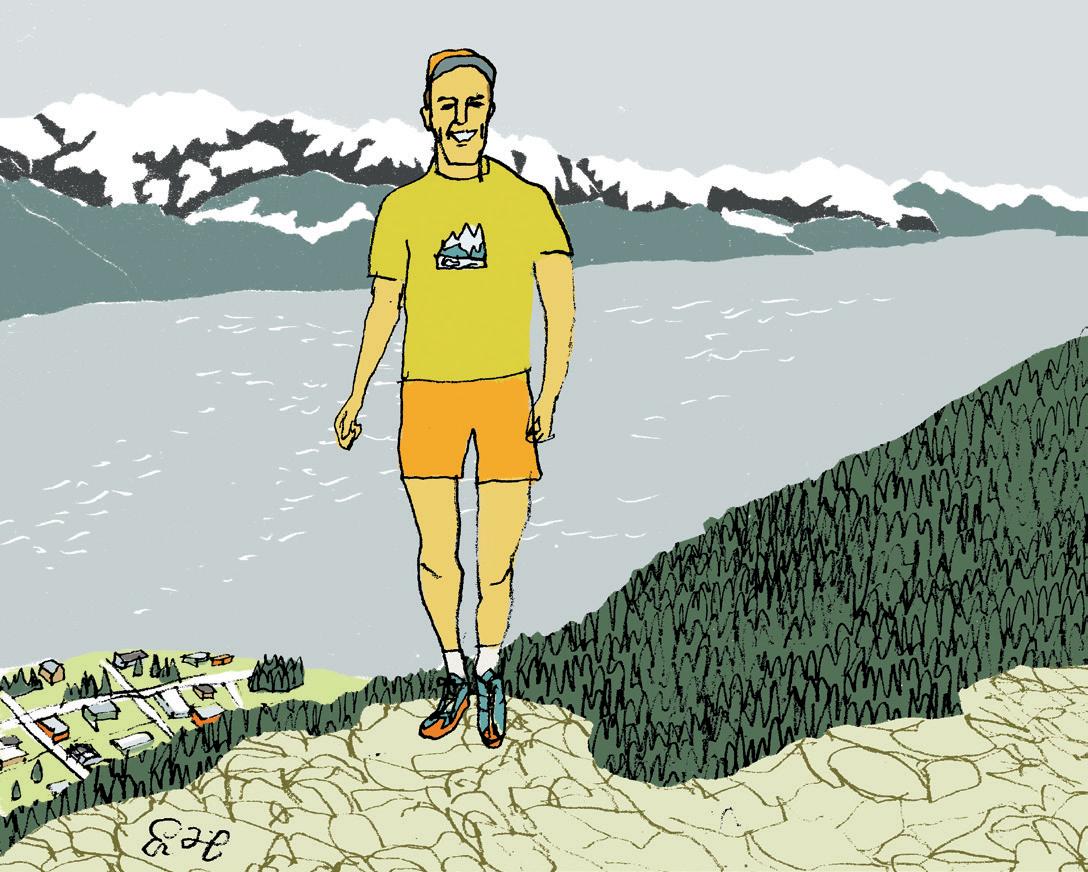
“I think the race attracts people who have the willpower to grind through arduous and sometimes painful tasks.”
—EVERETT BILLINGSLEA ’83 ON THE MOUNT MARATHON IN SEWARD, ALASKA, IN WHICH HE HAS COMPETED FORTY-TWO TIMES
anytime soon. When the event was canceled in 2020, Billingslea drove down to Seward and ran up the mountain anyway, earning him a hand-embroidered Mount Marathon finisher patch from his daughter. The annual competition is a family occasion for him—his two adult daughters have never been anywhere but Seward on the Fourth of July, even though they live on the East Coast. One of his best race memories is toeing up to the starting line next to Kilian Jornet, one of the top mountain runners in the world. He says, “I think the race attracts people who have the willpower to grind through arduous and sometimes painful tasks,” noting that this is something that can be helpful in the practice of law.
Morgan Adams: “Excited to announce my contribution as a chapter author (Chapter 25!) for the American Bar Association’s textbook, the fourth edition of Truck Accident Litigation. The textbook is now out. My partner, Danny Ellis, is the chapter author of Chapter 19, ‘Construction Zone Crashes.’ Danny and I are both NBTA board certified in truck accident litigation, a rare area of legal specialization (with less than 100 lawyers in the US). We also opened our third office specializing in truck accident litigation, with offices now in Tennessee, Washington, and South Dakota. Weird that my military retirement kicked in. The government thinks I am older than I feel!”
Chris Messerly ’81, Joanne Lerner Messerly ’80, Chad Olcott ’99, and Neil Moses ’80 enjoyed a hiking trip to Portugal this past spring with Chad’s company, Parallel Adventures, which is headquartered in Brunswick, Maine. Joanne says, “We encourage all Bowdoin alumni to check out these trips and support a fellow alum!”
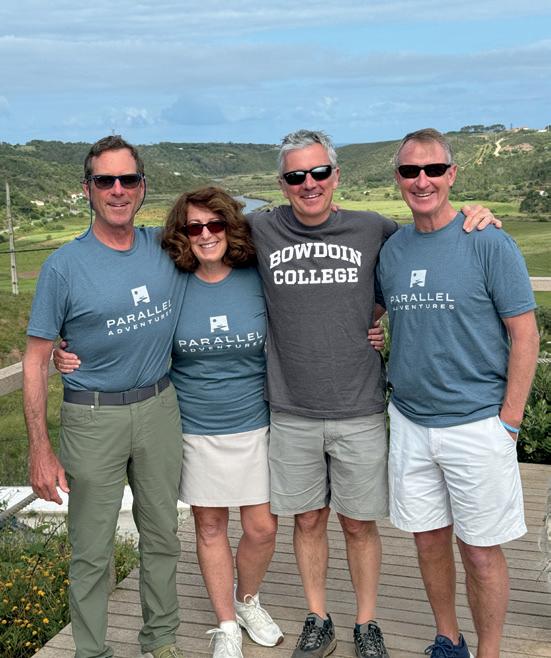

Jillian Horton ’24 represented three generations of the Horton family during Commencement Weekend in May. Pete, who is ninety-four years old, even marched in the alumni parade!
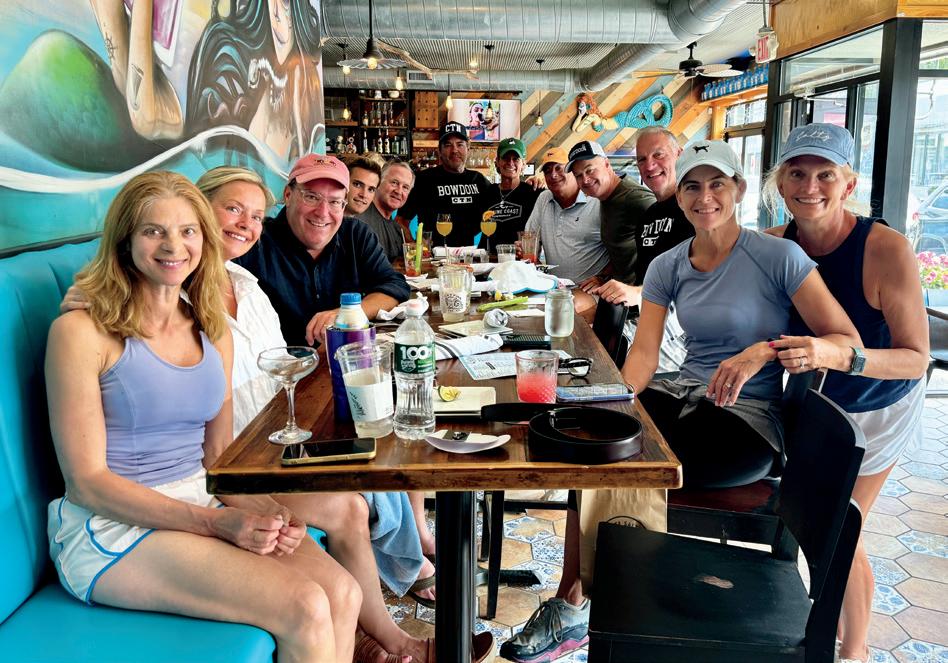
Dominique Rabitor, Karin Battiston, Jeff Battiston ’88, Andrew (friend of the DeFreitas family), David Lyman ’88, Brad Rabitor ’88, Eileen Carter Williams ’90, David Mazzella ’88, Rob DeFreitas ’88, Joe Williams ’88, Beth Lyman, and Kim Mazzella, gathered in Scituate, Massachusetts, in June to celebrate the wedding of Rob and Sarah Smith DeFreitas’s ’88 daughter, Kayla. Eileen said, “The mother of the bride was busy doing other things!”
From a Reed Smith press release, May 6, 2025. James Boudreau has joined international law firm Reed Smith as part of the roster of employment-related talent in their Philadelphia office. Boudreau’s practice involves leading large teams of attorneys in defending employers in nationwide class and collective wage and hour actions, as well as class actions under the Fair Credit Reporting Act (FCRA). He also devotes a significant portion of his practice to complex trade secret and restrictive covenant litigation and has taken several such matters to final judgment. Boudreau has garnered a national reputation for forging creative solutions to complex employment disputes and is well known for staying ahead of cutting-edge issues that may impact national employers.
1989 From a bowdoin.edu/news story, June 17, 2025. Mark Lenhart has been honored by the Alumni Council with an Alumni Footprints Award. Lenhart’s leadership and commitment to fostering global learning opportunities exemplifies his dedication to supporting the next generation of students. As executive director of CET Academic Programs, he has played a pivotal role in advancing international education. His work as a trustee and chair at the Fund for Education Abroad has been transformative, and his frequent speaking engagements at national conferences on study abroad safety, underrepresentation, and the LGBTQ student experience have furthered his impact on the educational community. Lenhart’s decades of service at Bowdoin include his work on the Alumni
Council, as a primary volunteer and peer organizer of pride events, on reunion committees, and in support of admissions and CXD programs. Established in 2004, this award recognizes a volunteer who has left, in the words of Henry Wadsworth Longfellow, “footprints on the sands of time,” through professional, academic, and/or volunteer activities, demonstrated leadership for the common good, and a commitment to serving others.
Keith Gittens-Jones: “I am the host of Phantom Electric Ghost Podcast, which broadcasts live on YouTube, Facebook, and LinkedIn and is available on major podcast streaming platforms like Apple, Spotify, and iHeartRadio. I interview creative people from around the world in a flow-state, present-moment style. The podcast has a ListenNotes score of 38 with a Global rank of 2 percent. I have been podcasting since 2016 and have over 1,200 episodes.”
From a bowdoin.edu/news story, April 21, 2025. Auden Schendler returned to Bowdoin in April to discuss modern environmentalism and his recent book, Terrible Beauty: Reckoning with Climate Complicity and Rediscovering our Soul, published by Harvard Business Review Press in 2024. He spoke about the power that corporations and individuals have to make a difference on the climate, while weaving in anecdotes about his family and personal life. Schendler is a writer, adventurer, and climate leader who graduated from Bowdoin with a degree in biology and environmental studies. His path back to the College has been
winding, with many jobs, including energy technician, high school teacher, Outward Bound instructor, and think tank analyst. His most recent position is senior vice president of sustainability at Aspen One. In his talk he touched on the importance of schools like Bowdoin at a time when things can feel so dire. “There are things we like to do as human beings that require that we not live in a survival society. These things, they seem superfluous: art, culture, sport, literature, poetry— but you all know, especially here at a liberal arts school, they’re not superfluous,” he said. “These are the things that advance society…. If you live in a world where you’re constantly battling the next flood or something, you don’t get to do that. That’s the threat of a climate change world.” He shifted to speaking about the role of corporate sustainability in today’s environmental movement, including the moment he realized he did not just want to be a part of the status quo and took the job with Aspen One to create meaningful change from within the business world. “We started asking the question ‘What matters?’ and what would actually drive change, and where our power is,” Schendler said. He closed with a reminder of how human inclinations and climate activism go hand in hand. He urged students to take action, promising them it will not just improve the world but also improve their own lives. “If you’re presented with an opportunity to work on climate change in a meaningful and not token way, and in the process of doing that add meaning to your life—endowing your life with some of the oldest aspirations humans have ever had, the notion of living a graceful life, a dignified life—I don’t think you can help but do it.”
From a Kenyon College online news story, April 2, 2025. Zoë Kontes and Iris Levin ’05, both faculty at Kenyon College, were selected out of a pool of applicants to lead the first iteration of a new donor-funded travel program in association with courses they each teach. The trips, which ran over spring break in March 2025, were meant to enhance classroom learning with the personal experience of a given subject’s topography, material culture, flora and fauna, and geopolitical context. Kontes, NEH Distinguished Teaching Professor of Classics, led the students in her Greek archaeology course to Athens to the National Archaeological Museum, traveled by ferry to the island of Aegina, conducted site visits to Corinth, and spent a full day at the Acropolis and Acropolis Museum, with other stops along the way. Levin, assistant professor of biology and environmental studies, conducted graduate research in the Galápagos Islands. In addition to identifying insects, reptiles, birds, and sea creatures they had studied prior to the trip, it was important for Levin that the students got a chance to meet with local people and begin to understand the complex interactions between humanity and nature on the islands. For a number of them, the most important takeaway from the trip was gaining a more nuanced understanding of the interplay between the competing needs of tourism and conservation and how the people on the island are finding ways to solve complicated ecological problems with sometimes the simplest of solutions. Kontes says, “It was our Bowdoin study abroad in Greece and the Galapagos that inspired our careers, and eventually these travel courses.”
Vacation homes and other treasured assets (including closely held business interests) have been important parts of your life. When the time comes to part with them, consider gifting them to Bowdoin. Gifts of this nature can provide tax benefits, create streams of income for life, and be transformative for the College.
To learn more about gifting property (real or personal), contact Stephanie Ward Ball ’94, director of gift planning.
207-725-3172
giftplanning@bowdoin.edu bowdoin.edu/gift-planning
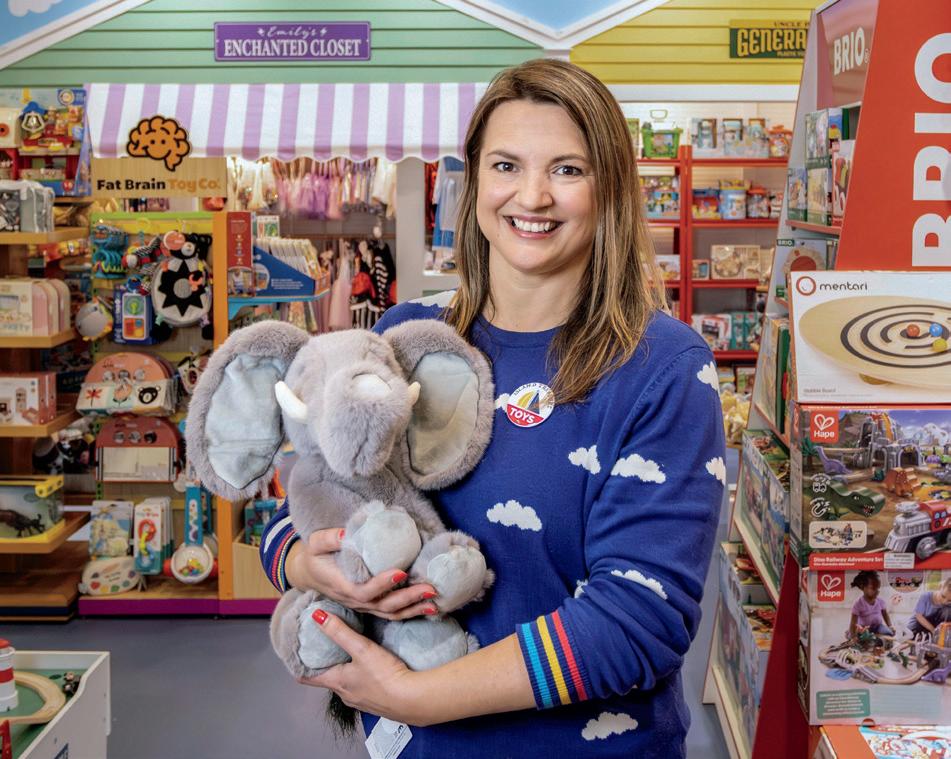
Emily Drappi ’02 used her marketing and digital skills to grow and manage a family toy store in her home state of Maine.
I WORKED FOR TEN YEARS AT AN E-COMMERCE STARTUP that eventually rebranded as Wayfair. My husband, Paul, whom I met at Wayfair, was asked to launch their Brunswick branch— the perfect excuse to move our family to my home state. When we became owners of Island Treasure Toys, our plan was that Paul would manage the stores, but I couldn’t stay away. I loved being hands-on that first holiday season, talking to customers about kids they were shopping for, wrapping piles of gifts—it felt like the North Pole.
MY FIRST JOB IN HIGH SCHOOL was in a small wooden toy factory. We made pull-along toys sold at L.L. Bean. I painted a lot of little wooden wheels! Very elf-ish.
WHEN THE PANDEMIC HIT, our e-commerce experience came in handy—we quickly got a website up and running. I was still working full-time at a Portland marketing agency but also working at night on the toy store and entertaining our two sons, Leo and Marty, during lockdown. I finally followed my heart, and I have never looked back.
BEING A PSYCHOLOGY MAJOR has helped me understand customers’ needs and motivators. My work-study job as assistant web coordinator, doing everything from web coding to creating graphics, was also helpful. Those skills were a big part of why I got the opportunities I did in my early days.
For more from this interview, visit bowdoin.edu/magazine.
2000 From Dave (“Ferris”)
Lawrence: “Dave Lawrence, Seth Ritter, Tim Dwyer, and Tim Hayes traveled to Iceland in late June to explore the country’s spectacular scenery, nature, culture, and cuisine. We traveled by camper van, circumnavigating the country over ten days on the iconic ‘Ring Road.’ We were so impressed we are working on convincing our wives to let us go back!”
James Bass:
“In June 2025, I graduated from the US Naval War College in Newport, Rhode Island. Still in private practice in Augusta, Maine, but had the wonderful opportunity to go back on active duty for a year. I went down with my wife and our two young boys, and we had an absolute blast! Such a great family adventure with lots of memories. Hope all’s well with classmates and friends.”
Christine Caron Domen: “Due to unplanned factors, we [husband Jonathan Domen (Bryant University ’02)] were remiss in sending our wedding photo at the time we were married. However, this year we will celebrate our fifteenth wedding anniversary and thought it was about time to send it in. We will be celebrating with our two children, who enjoyed a Reunion Weekend trip to campus with us in 2022!”
From a bowdoin.edu/news story, June 17, 2025. Sara Edel has been honored by the Alumni Council with a Polar Bear Award. A dedicated alumni volunteer for more than two decades, Edel was a founding member of RepresentAsian, Bowdoin’s Asian alumni association. Her leadership, previously as secretary to the vice president and more recently as chair of the communications committee, has been
instrumental in the group’s evolution. Edel’s candid advice, patience, empathy, and wit have been credited with contributing to RepresentAsian’s success, as have the events she has hosted in her home state of Hawaii. She has also led multiple events as part of the Bowdoin Club of San Francisco and supported the admissions and the development and alumni relations offices and CXD through a variety of volunteer roles. Established in 1999, the award recognizes significant personal contributions and outstanding dedication to Bowdoin, honoring a record of service rather than a single act or achievement.
Kelly Kerney: “I’m writing with some news from the music world. My husband, Ethan Bullard ’03, and I have been restoring my grandmother’s West Virginia gospel music for the past twelve years. The process involved transferring a big collection of delicate, degrading magnetic tapes, which document more than seventy years of her songwriting. She wrote hundreds of songs in that time, from cheeky country ballads to heart-wrenching devotionals. Ella Hanshaw, my mamaw, will now have her music published for the first time by the Spinster label. The album, Ella Hanshaw’s Black Book, [was] released on June 13. Already, the UK world music magazine Songlines has called it one of the most anticipated albums of 2025. A few songs have been released early on Bandcamp. As an archival release, the vinyl album will include an essay by me (a novelist) and former West Virginia State Folklorist Emily Hilliard.” 2004
From Ana Conboy: “Bowdoin in Brittany! Bowdoin alum Ana Conboy met up with her Bowdoin professor and mentor, Professor of Francophone Studies
Katherine Dauge-Roth, while at the NASSCFL (North American Society for Seventeenth-Century French Literature) conference, in Lorient, France. Three days filled with engaging scholarly and pedagogical discussion on ‘Reading, Mapping, and Digitizing the Long Seventeenth Century’ culminated with a visit to the Museum of the Compagnie des Indes and a ferry ride off the coast of Lorient, in Brittany, on the longest day of the year. The sun didn’t set until nearly 10:30 p.m.!”
Hope Reese released her new book The Women Are Not Fine (Brazen Books) on July 10. She summarizes: “A century ago, in a small Hungarian village, a group of women were desperate. Their husbands beat them. They were poor, overwhelmed, and in some cases driven to kill their own children just to survive. Then a midwife offered a solution: arsenic. What followed was a mass poisoning that lasted more than two decades and claimed the lives of as many as 300 people in the region. It’s a true story— one I’ve spent years researching through archives, court documents, and expert interviews. Beyond looking at the facts of the story, I also zoom out to explore its broader meaning, talking to biologists and primatologists like Robert Sapolsky and (the late) Frans de Waal, psychologists, and researchers on intimate partner homicide, to learn how this spiraled into the largest female-led mass poisoning in modern times.”
From a Portland Press Herald news story, July 15, 2025. Sean M. Sullivan has joined the Maine Trust for Local News, the nonprofit that owns most of Maine’s daily newspapers, as part
of the company’s plan to expand its innovative storytelling and presence in the community. Sullivan is the innovation and experiential strategy lead, a new position responsible for organizing events, building partnerships, and developing readership engagement efforts. He previously worked as the executive director of the Maine Brewer’s Guild for nearly a decade and cofounded Buoy Local, a mobile app-based rewards program that incentivizes people to shop locally. It was acquired by Bangor Savings Bank in 2016. Stefanie Manning, managing director of the Maine Trust, said Sullivan’s deep roots in Maine and background with unique business ventures will help the company strengthen its ties in the community.
From a bowdoin.edu/news story, May 6, 2025. Alivia Moore, a citizen of the Penobscot Nation, was recently celebrated for conserving land in Swanville, Maine (Penobscot territory), and creating a permanent place for Wabanaki agriculture, ecological stewardship, and cultural and educational programming. Moore and two other co-leaders of Niweskok: From the Stars to Seeds accepted the 2025 Espy Land Heritage Award from the Maine Coast Heritage Trust in Augusta, Maine, at the end of April. It is the first time an indigenous organization has received the Espy Award, which recognizes those making outstanding contributions to land conservation, according to a press release. When Niweskok in 2024 secured the 245-acre farm, it took a big step forward in its mission to connect Wabanaki communities to the land and their traditional food systems, medicines, and stewardship of natural resources. The property
Dave Lawrence ’00, Seth Ritter ’00, Tim Dwyer ’00, and Tim Hayes ’00 took advantage of the perfect photo op while circumnavigating Iceland on the Ring Road over a ten-day trip in June.
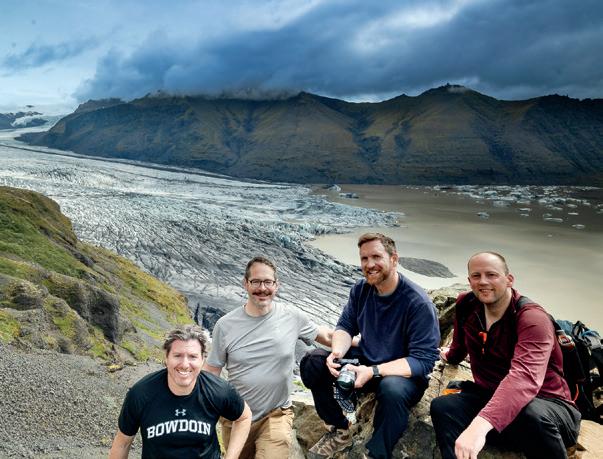

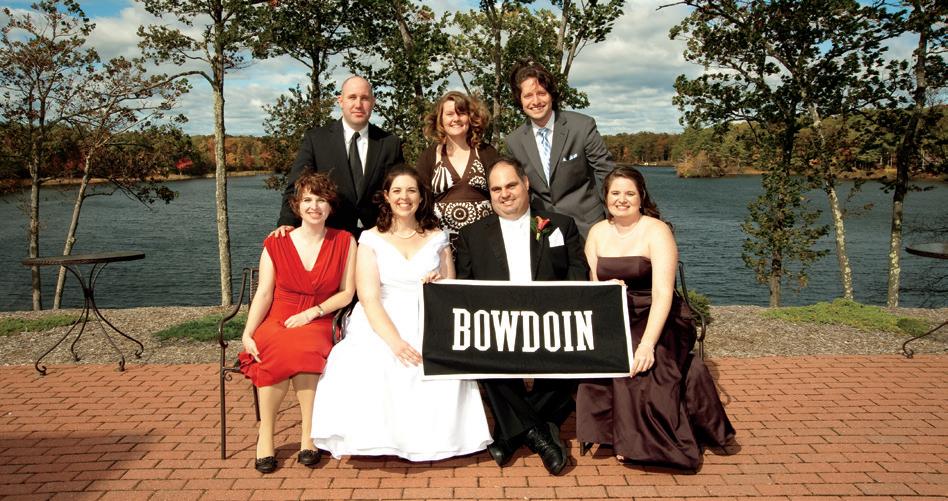
Christine Caron ’02 and Jonathan Domen (Bryant University ’02) were married on October 16, 2010, at Crystal Lake Golf Club in Mapleville, Rhode Island. Pictured: Alisia Wygant Revitt ’02, Christine and Jon, Emily Duffus Sayle ’03, Justin Minihane ’02, Stacy Barron Minihane ’03, and Justin Watras ’02. Christine decided that her fifteenth anniversary was a good incentive to finally submit her wedding photo!
Bowdoin Associate Professor of Romance Languages and Literatures
Katherine Dauge-Roth and Ana Conboy ’04 smile for a picture aboard a boat off the western coast of Brittany, after a lovely visit and dinner in Port Louis, Lorient, France. The two were there to attend the North American Society for Seventeenth-Century French Literature conference.
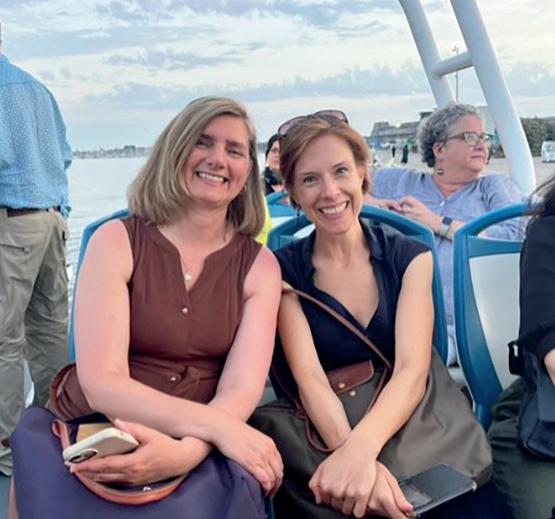
Walsh ’09 and
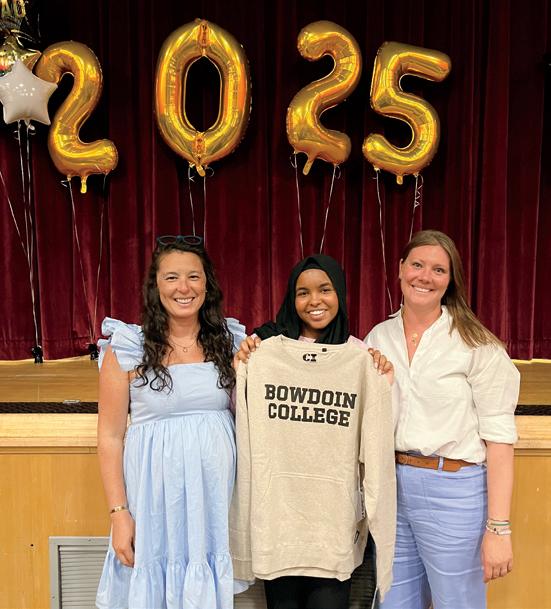
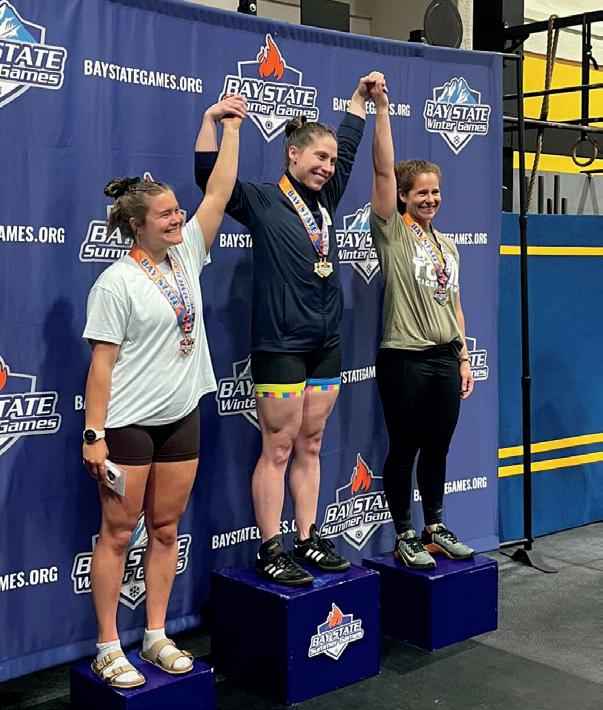
Hope Reese ’06 and Chester Eng ’11 met in Budapest, Hungary, in late April this year. Hope and Chester learned about their special connection when Hope saw the Bowdoin decal on Chester’s laptop. This moment highlighted the impact Bowdoin merchandise can have!
Elsbeth “PJ” Paige-Jeffers ’10 (center) atop the podium at the 2025 Bay State Summer Games, a significant meet on the New England weightlifting calendar. Her wins qualified her for her fourth consecutive USA Weightlifting National Championship, which will take place in June 2026.
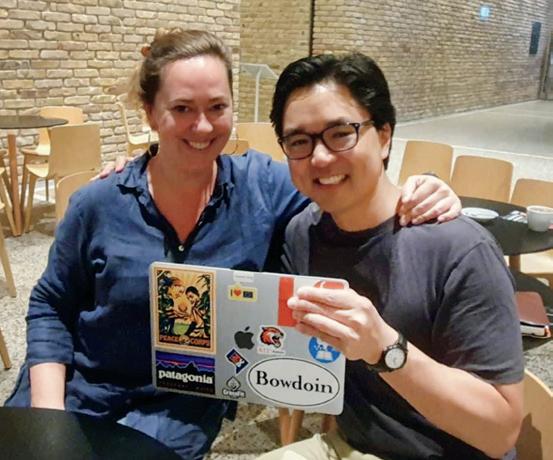

Todd Buell ’03, Todd’s partner, Anne-Sophie Hombert, and Chester Eng ’11 in Brussels, Belgium. Todd and Chester finally met in person after first connecting in October 2012 through Professor Birgit Tautz.
contains agricultural fields, mature forests, wetlands, ponds, and access to the Goose River. “We’ve already been doing this work across disparate locations for years—reinvigorating our traditional crops and land management strategies, hosting workshops, and distributing traditional foods,” said Moore. “Now, with this land, we have permanency of place—and the ability to continue this work for generations to come.”
Besides offering intergenerational programming, the land will support seed saving, wild harvesting, and the cultivation of traditional crops. Niweskok in the Penobscot language translates to “dried seeds for planting” as well as “essence of life” and “spirit,” the organization writes on its website about its vision. “Wabanaki cosmologies embed us in broad kinship networks, which illuminate our interconnections, extending from the stars to seeds. Collectively, we dreamt Niweskok into existence, and with this has come clarity on pα katəkk wéwehla, our echo, our impact into the future that we have a responsibility to nurture.”
Sam Tung: “My wife and I welcomed our second child, a daughter, at the end of February. I recently completed my first short film, Knights & Relationships, and am now submitting to film festivals. It was scored by Louis Weeks ’11, and Chris Wilkins of Bowdoin security served as our primary armorer. I also recently completed storyboarding Christopher Nolan’s upcoming adaptation of The Odyssey—with my copy of Homer’s epic from my Bowdoin days in hand!”
From a Princeton University online news announcement, March 3, 2025. Alexandra P. Foradas has been named the Haskell Curator of
Modern and Contemporary Art at Princeton University Art Museum, where she will lead the museum’s program in global modern and contemporary art. Foradas arrives at Princeton as the museum prepares to open a bold new building in the fall of 2025, an ambitious project that will double the space for the exhibition, conservation, study, and interpretation of its globe-spanning collections, encompassing more than 117,000 works of art. As the new Haskell Curator, she will work with the museum director, chief curator, and a team of fifteen curators to activate the museum’s collections in postwar art. She joins a collaborative curatorial team charged with originating exhibitions, strategizing acquisitions, and advancing research to engage the university community and museum visitors alike. Foradas will also play an integral academic role on Princeton’s campus, supporting research and learning at the graduate and undergraduate levels.
From Elsbeth Paige-Jeffers: “Elsbeth ‘PJ’ Paige-Jeffers is the reigning weightlifting World Champion in the women’s 71-kilogram, 35–39 master’s category. In Rovaniemi, Finland, PJ totaled 181 kilos, beating Czechia by 8 kilos to claim gold. On June 1, 2025, the International Weightlifting Federation introduced new body weight categories, such that PJ will remain the 71-kilogram Masters World Champion in perpetuity. PJ now competes in the new 69-kilogram body weight category, in which she is the top 35-39 master’s lifter in the nation. PJ additionally holds all New England records in her weight and age categories. Her snatch record of 84 kilos, clean and jerk record of 110 kilos, and total record of 190 kilos will also exist in perpetuity after June 1. PJ is also the national champion in the
women’s 71-kilogram, 35-39 master’s category and attended her third senior USA Weightlifting National Championships in Colorado Springs, Colorado, in June 2025. On July 19, PJ competed in the Bay State Summer Games, a significant meet on the New England weightlifting calendar. She won both the open and master’s 69-kilogram divisions, snatching 80 kilos and clean and jerking 103 kilos for a total of 183 kilos. PJ out-totaled silver by 21 kilos and broke two master’s records. By snatching 80 kilos, she broke her own snatch record for the 69-kilogram, 35-39 master’s category. She also broke her own total record in the 69-kilogram, 35-39 master’s category with her total of 183 kilos. This total also qualifies her for her fourth consecutive USA Weightlifting National Championships, which will take place in June 2026.”
Chester Eng: “Hope Reese ’06 and I were delighted to learn we are both Polar Bears during my late April trip to Budapest, Hungary. We are both members of Skylarks, a public speaking club in the Pearl of the Danube. We learned this important information about each other when Hope noticed the Bowdoin decal on my laptop. Because I usually attend Skylarks meetings online (from Bosnia and Herzegovina), Hope and I might not have learned about our special connection if I had not visited in person and did not bring my laptop. Hope joined Skylarks earlier this spring to prepare for the launch of her book The Women Are Not Fine on July 10, while I joined Skylarks one year ago. We both greatly enjoy Skylarks’ weekly Tuesday morning meetings. Also, Todd Buell ’03 and I finally met in person in Brussels,
Belgium, after first connecting in October 2012 through Professor Birgit Tautz. Besides both being German majors at the College, Todd and I learned that we share another important commonality: we are both Toastmasters.”
From a Todd & Weld LLP press release, June 11, 2025. Nick Pisegna has joined Todd & Weld LLP’s government investigations and criminal defense practice group, focusing on defending clients in pre-indictment government investigations and at trial. With his extensive courtroom experience and understanding of the criminal justice system, Nick delivers strategic and effective counsel tailored to each client’s needs. Before joining Todd & Weld, Nick served as an assistant district attorney in the Middlesex County District Attorney’s Office, where he spent years as a trial prosecutor in Middlesex Superior Court. He was responsible for all aspects of prosecution, including grand jury investigations, plea bargaining, pretrial motion practice, and conducting jury trials. He handled and tried cases that involved violent crime, sexual assault, domestic violence, shootings, narcotics trafficking, and motor vehicle homicide. During his time at the district attorney’s office, Pisegna also served as the supervising assistant district attorney in multiple district courts in Middlesex County.
From a bowdoin.edu/news story, May 15, 2025. Lucas O’Neil is making a name for himself in the world of stand-up comedy, although he describes himself as more of a “dramedian.” O’Neil, an English and theater major, brought his latest show—Emotional Man—to the Bowdoin campus, where he performed in front of a small group


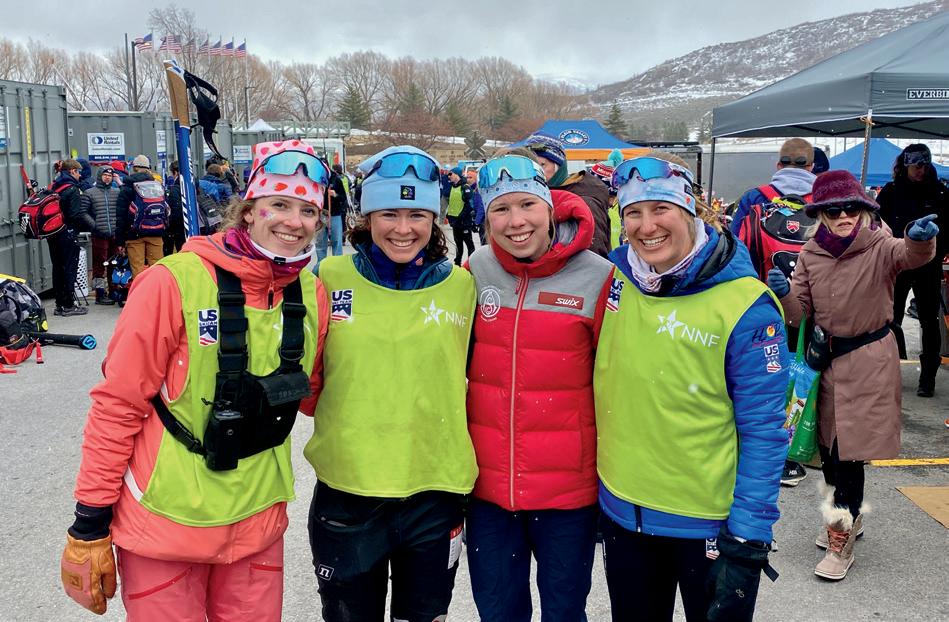
of lucky students. The show, he explains, deals with what has happened in his life over the last few years, including the global pandemic and the death of his mother. As a result, he says, not all of it is funny. O’Neil explains that he thinks about the show as an exploration of the people who make you who you are, and who you become without them. “Basically, most of my material over the years was about my family and my role in it, and then two things happened: My mother passed away, and we endured a global pandemic. And it felt like a pretty hard ‘before’ and ‘after’ point for me. So, I tried to structure the show in that way: there’s jokes, jokes, jokes, and then The Bad Thing happens, and we all contend with that together in real-time(ish). The moments that are sincere revealed themselves in doing the show and working on it. How can you bring in heavy topics and address them with care and comedy? I was struck by how socially acceptable it is for people, especially men, to publicly miss their fathers. But I didn’t see that same ease with mothers, and so I tried to make a show that countered that tendency in some way. The short answer is: This is the show I could make at that time. I chose to do stand-up based on my real life and completely forgot that bad things could happen in my life. Maybe I’ll become an absurdist comedian next. I’m currently editing my first special, Emotional Man, which I filmed in Chicago this past November. Hopefully, that will be released somewhere on the internet this summer.”
From a bowdoin.edu/news story, June 17, 2025. Ryan Davis has been honored by the Alumni Council with a Young Alumni
Service Award. Davis’s work as a lead class agent and a 1794 Society ambassador is highly valued. Along with soliciting peers for gifts of all levels and brainstorming new ways to encourage them to give, he has often reached out to invite peers to events around the country. Davis’s service on his fifth and tenth class reunion committees and his support of CXD’s Sophomore Bootcamp program help demonstrate his dedication to keeping alumni connected to the College and each other. Established in 1999, this award is granted annually to a Bowdoin alumnus who has graduated within the past ten years, recognizing a record of service to the College rather than a single act.
Carolyn Veilleux: “We [Matthew La Rosa, New York University Polytechnic Institute ’17] are enjoying newlywed life in Brooklyn, New York, and always look forward to gathering with our lovely Bowdoin friends!”
From a Talking Biz News online media blog, July 31, 2025. Steff Chávez has been named US defense correspondent at The Financial Times, covering and reporting on US defense and national security policy. She was most recently their Washington reporter, covering the Trump administration for the politics and foreign policy team. She also launched the White House Watch newsletter. Previously, she covered the 2024 presidential election and the final year of Joe Biden’s term in office. Prior to Washington, she reported on the US aerospace and defense industry as a Chicago correspondent and a member of the breaking news team. She also wrote about
domestic airlines and automakers, and the Midwest more broadly. She joined The Financial Times in 2020. Chávez has a degree in political science and art history from Bowdoin College and was a journalist in residence at the University of Chicago Booth School of Business.
From a bowdoin.edu/news story, June 17, 2025. Diamond Walker has been honored by the Alumni Council with a Young Alumni Service Award. Walker’s dedication to Bowdoin and the Bowdoin College Black Alumni Association (BCBAA) has been transformative. From hosting virtual programming for alumni of color during the pandemic to spearheading efforts to connect Black alumni, her contributions have been impactful and far-reaching. As an active member of the BCBAA Coordinating Council, she has played a pivotal role in establishing the mentorship program and has led meaningful events on campus and in New York City. Walker has served as an event speaker, supported CXD’s Sophomore Bootcamp program, and served on the AF/AM50 host committee. Established in 1999, this award is granted annually to a Bowdoin alumnus who has graduated within the past ten years, recognizing a record of service to the College rather than a single act.
From Rachel Zafren: “Firstyear Kira Scott ’28 won the U20 Cross Country Skiing Skate Sprint National Championship at the 2025 Junior Nationals in Soldier Hollow, Utah. Cheering her on were Bowdoin skiing alums Rachel Zafren (coaching for team Alaska), Lily Johnston ’20 (coaching for team Intermountain), and Aggie Macy ’24 (coaching for team Northeast).”
Sally Rose Zuckert: “A bunch of Bowdoin alums [Sally Rose, Bjorn Ludwig ’23, Laila McCain ’21, Hannah LeBlanc ’16, and Tam Do ’06] finished up an amazing two weeks at Columbia University’s Klingenstein Summer Institute this June. The program is a highly selective, fully funded fellowship that provides an intensive, graduate-level professional learning experience. And Bowdoin had the most alumni representation there—so cool! We all became new friends, and we were feeling so thankful for the Polar Bear connection. It was lovely!”
From Linda Durfee ’76: “Katherine Henneberger received her PhD in mathematics from the University of Kentucky in May 2025. Joining Kat to celebrate her graduation were her mother, Linda Durfee, and three of her 2020 classmates: Tori Clarke, Beatrice Cabrera, and Jacob Baskes.”
From a Peace Corps press release, July 24, 2025. Jack Andrews of Kennebunk, Maine, has been accepted into the Peace Corps. Andrews will depart for Morocco on September 12, 2025, to begin training as a youth development facilitator volunteer. He will collaborate with local counterparts to assess youth needs and design empowerment programs that view youth as assets. He joins the twenty-two Maine residents currently serving in the Peace Corps. Volunteers serve in host communities for two years following three months of training and receive a living stipend, housing, extensive language and technical training, and financial benefits that can include graduate school fellowships after service.

Bjorn Ludwig ’23, Sally Rose Zuckert ’19, Laila McCain ’21, Hannah LeBlanc ’16, and Tam Do ’06 during the two-week fellowship program at Columbia University’s Klingenstein Institute in June. Participants in the prestigious program explore curriculum, pedagogy, and assessment design in their teaching discipline, informed by current research and practice.
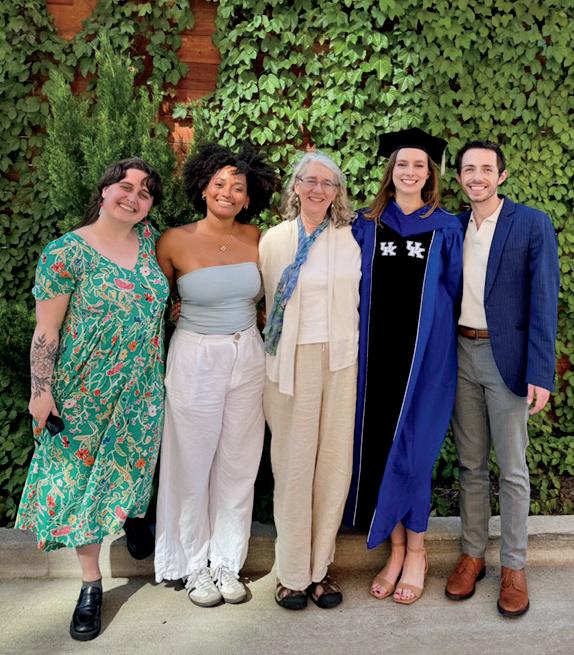
Henneberger ’20 earned her PhD in Mathematics from the University of Kentucky in May 2025. Joining Kat to celebrate her graduation were Tori Clarke ’20, Beatrice Cabrera ’20 and her mother, Linda Durfee ’76, and Jacob Baskes ’20.
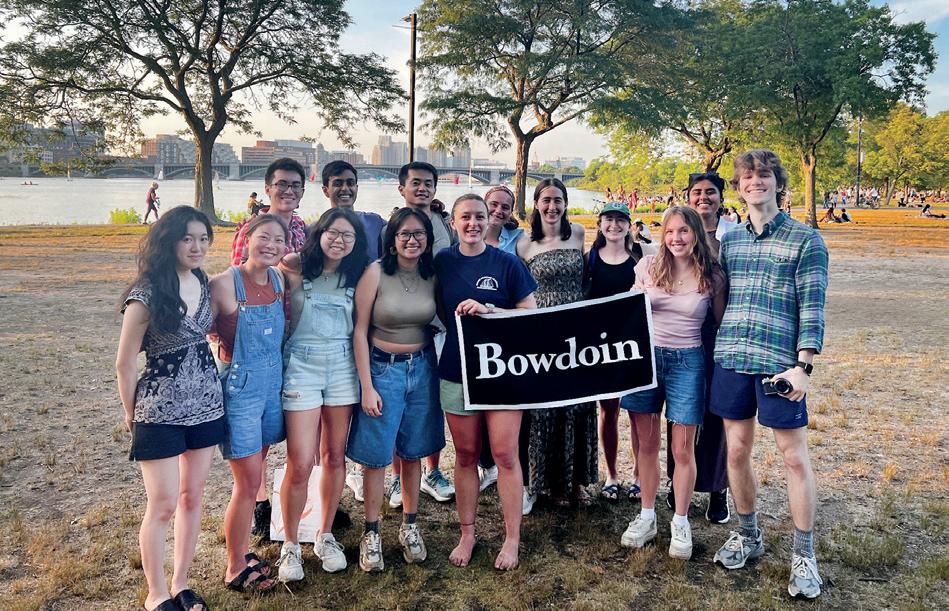
Miranda Muang, Sammi McLemore, Sebastian Sanchez, Jiahn Son, Zunain Husain, Khuê Anh Tran, Linguo Ren, Luisa Wolcott-Breen, Avery Leisle, Zelia Egan, Claire Wyman, Rania Janmohamed, Rachel Scruby, and Mason Daugherty—all members of the Class of 2025—convened in Boston in July for a reunion picnic. The Classes of 2023 and 2024 were also represented, but departed prior to the photo op.
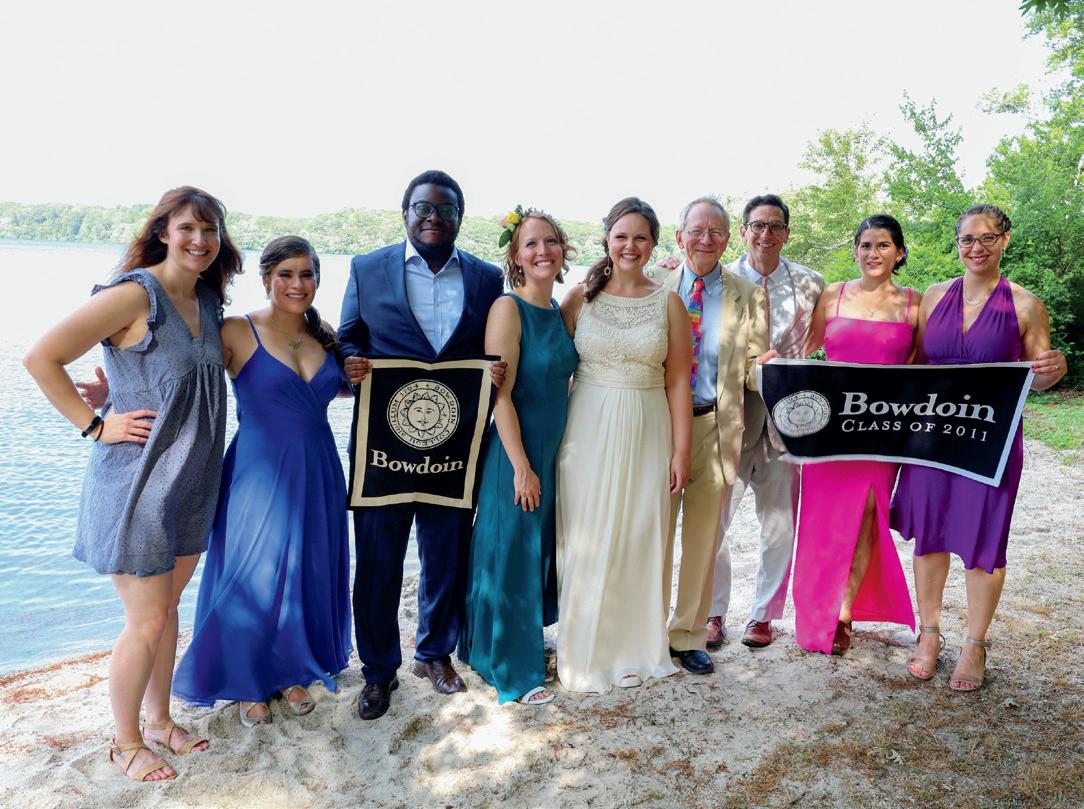
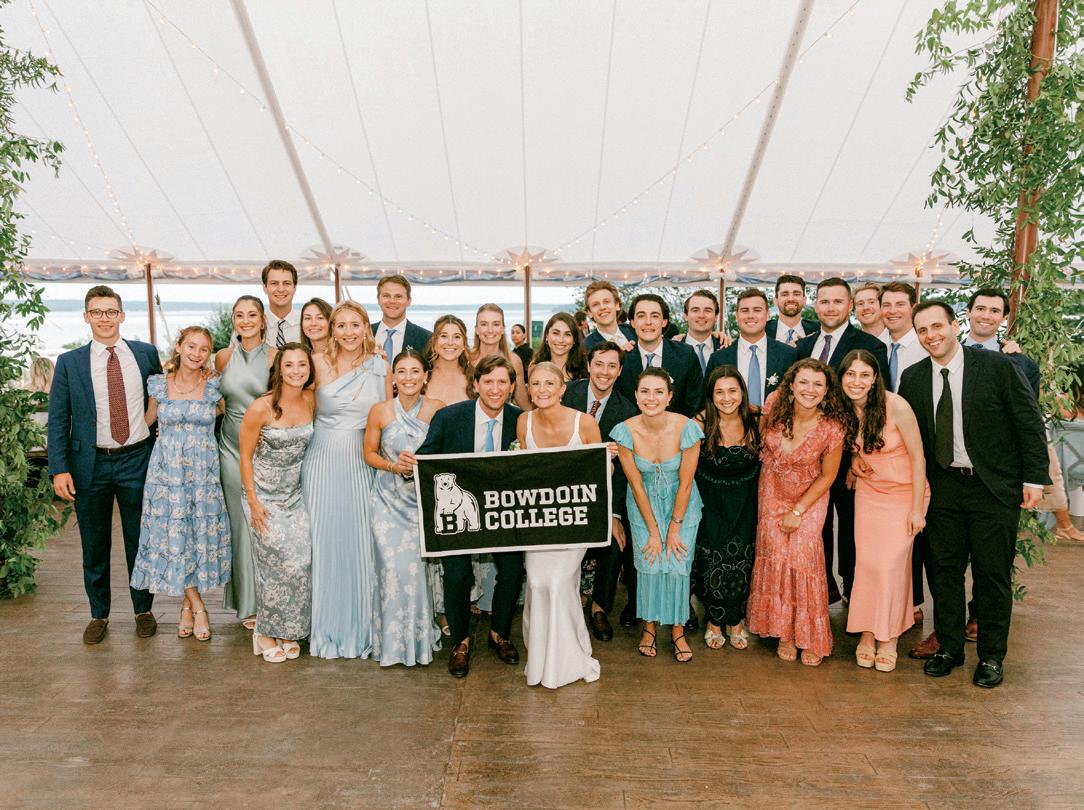
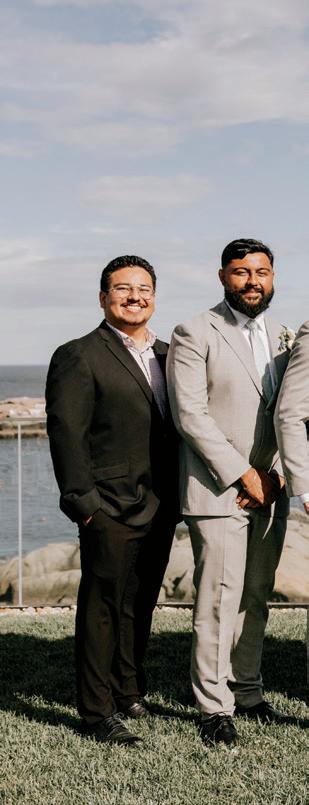


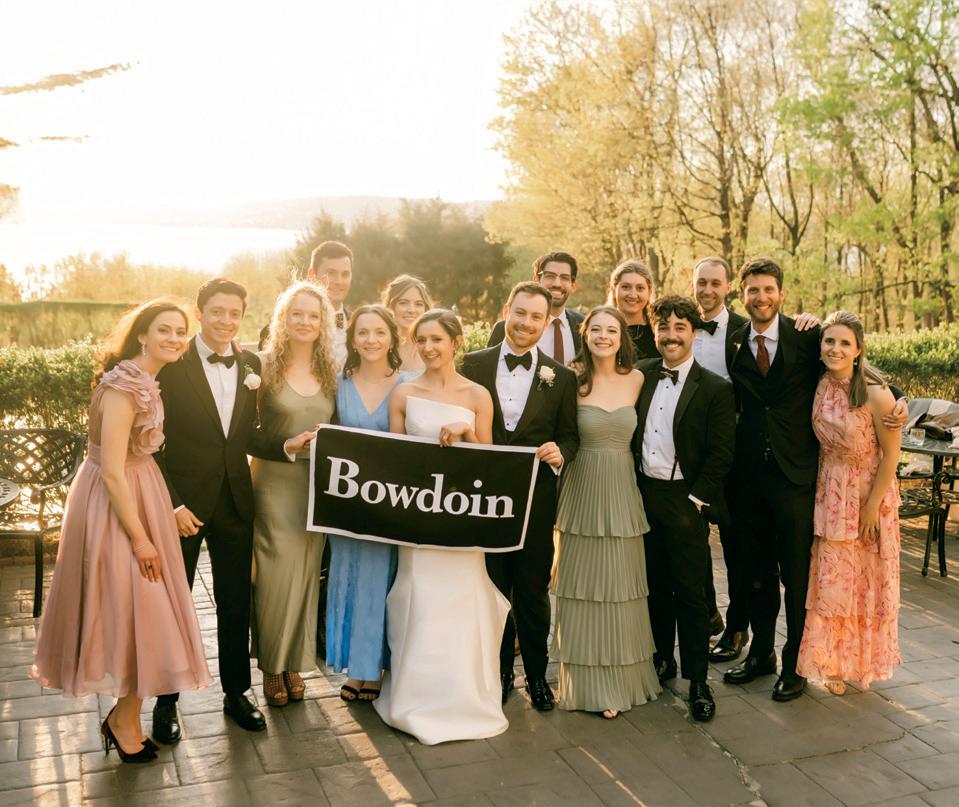
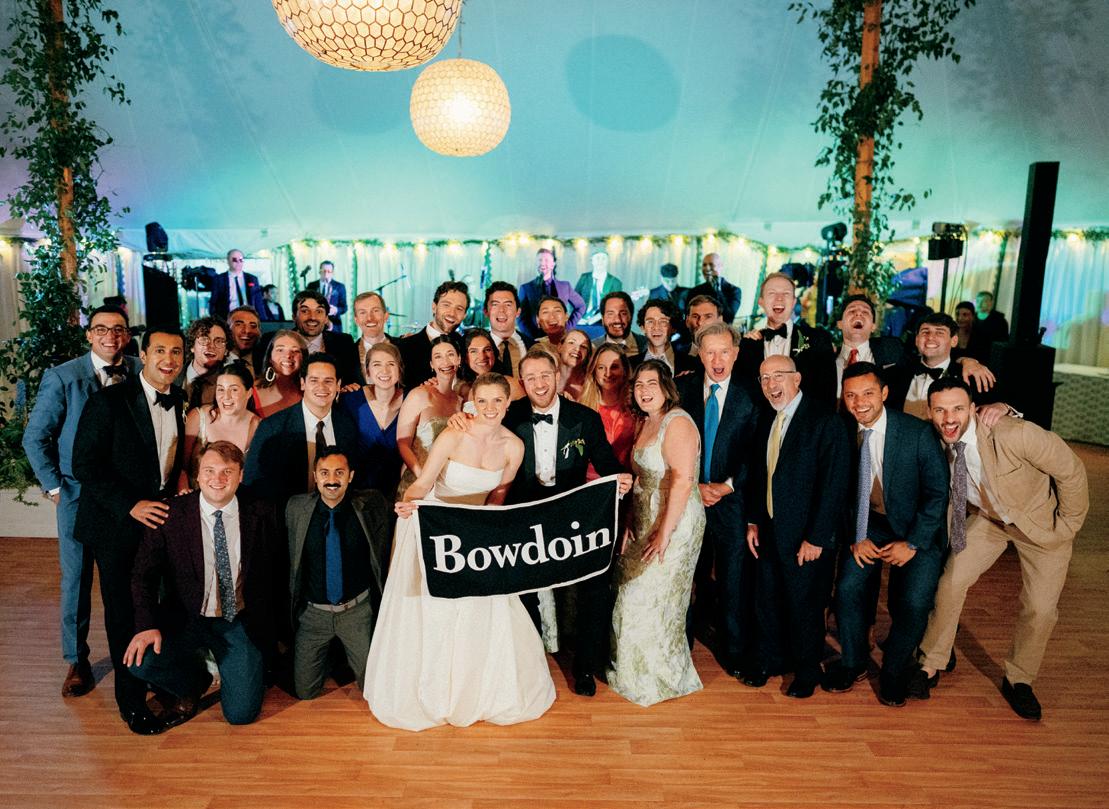
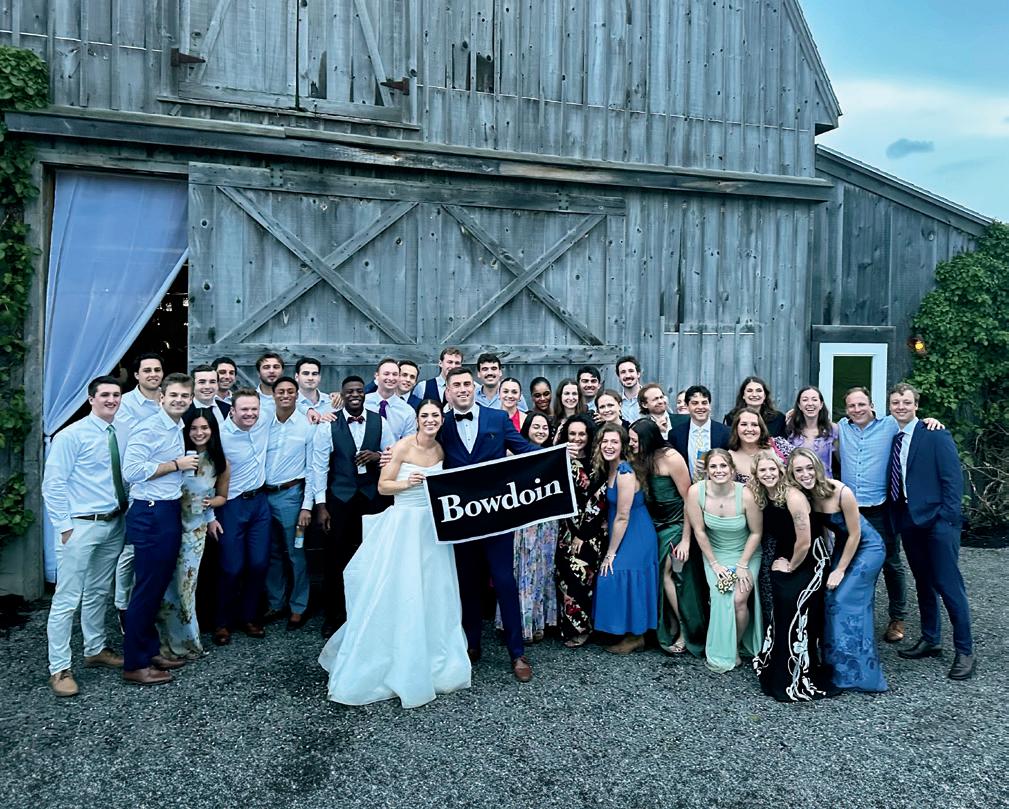

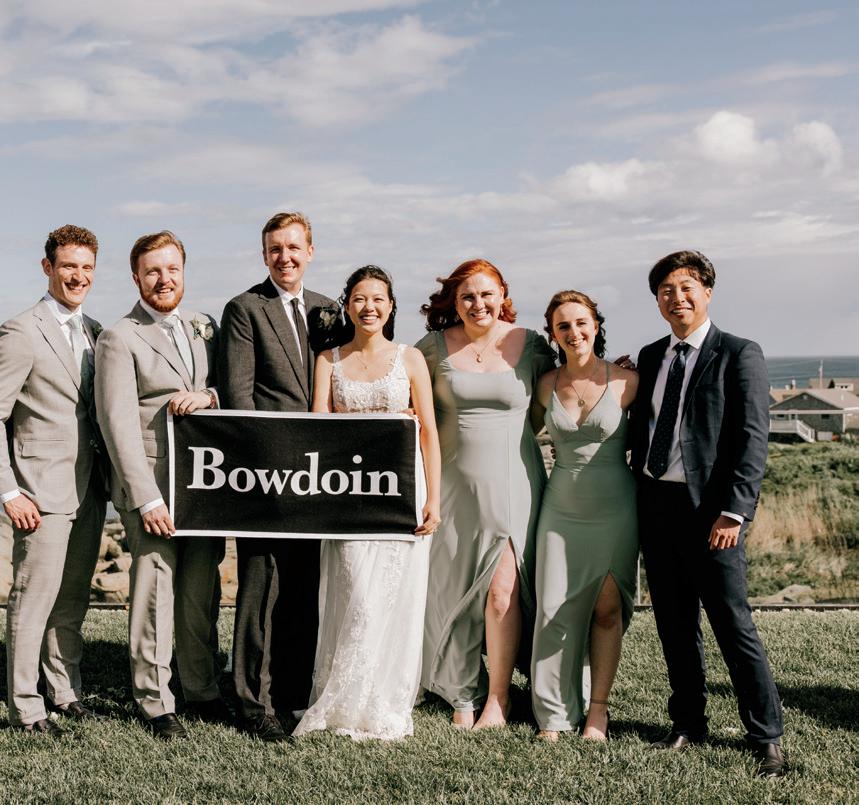


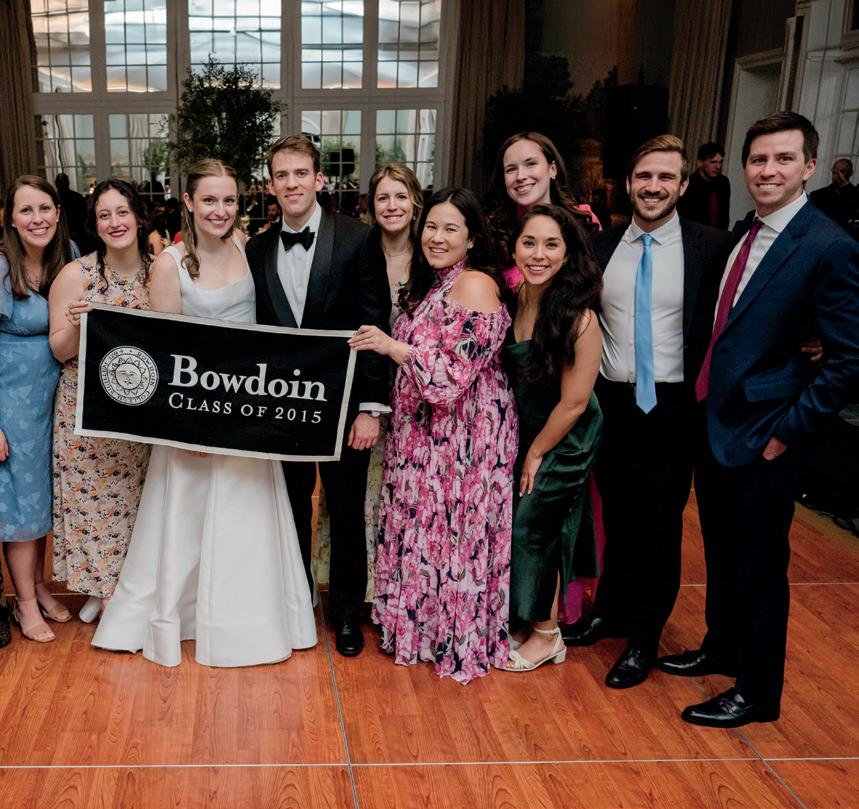
Celebrate
1. Caryn Oppenheim ’11 and Amy Lowight were married on June 23, 2024, at Coonamessett Pond in Falmouth, Massachusetts. Pictured: Rachel Ibarra ’11, Aviva Fiske ’12, Tawanda Pasirayi ’12, Caryn and Amy, Jeff Oppenheim ’76, Zach Milner ’07, Leah Powers ’11, and Alicia Jalbert ’11.
2. Casey Chase ’18 and Matthew Lison ’18 were married on August 24, 2024, on French’s Point in Stockton Springs, Maine. Pictured: Henry Haig ’18, Tully Ross Haig ’18, Sarah Trenton ’18, Keegan Pieri ’15, Mettler Growney Sullivan ’17, Marle Curle Van Siclen ’17, Kelsey Bumgardner ’18, Steve Van Siclen ’18, Juliana Fiore ’18, Clare McInerney ’18, Caroline Watt ’18, Matthew and Casey, Allison Rutz ’20, Seth Cooper ’19, Peter Bensen ’18, Spencer Antunez ’18, Emily Serwer ’16, Sam Ward ’18, Krista Smith ’18, Matt Melanson ’18, Jill Rathke ’18, Peter Cronin ’18, Cullen Geary ’18, Natasha Belsky ’19, Jay Kourkoulis ’17, Jason Nawrocki ’18, Matt Sullivan ’17, and Daniel McMullan ’18.
3. Samuel Honegger ’20 and Felicia Wang ’20 were married on June 8, 2024, in York, Maine. Pictured: Octavio Orozco ’20, Ronmel RugamaMontenegro ’20, Caleb Perez ’20, Jean-Paul Honegger ’15, Samuel and Felicia, Kate Hoadley ’20, Rebecca Londoner ’20, and Hyungyu Lee ’19.
4. Grace Klein ’13 and Alex Bishop (Penn State ’12) were married on June 21, 2025, in Pittsburgh, Pennsylvania. Pictured: Quinn Cohane ’13, Zina Huxley-Reicher ’13, Basyl Durnan ’13, Nate Meyers ’13, Alex and Grace, Morgan Browning ’13, Tristan McCormick ’13, Michael Hannaman ’13, Molly Krueger ’13, Nani Durnan ’13, and Christina Jang ’13.
5. Erin McKissick ’16 and Leah Haberman (University of Washington ’18) were married on September 28, 2024, in Kingston, New York. Pictured: Colby Joncas ’19, Sydney Smith ’19, Kendall Schutzer ’18, Jeffrey Chung ’16, Erin and Leah, Jenny Hughes ’16, Lara Adoumie ’16, Westerly Gorayeb ’16, Bailey Moritz ’16, and Miriam El-Baz ’18.
6. Carolyn Veilleux ’16 and Matthew La Rosa (New York University Polytechnic Institute ’17) were married on April 20, 2024, in Tarrytown, New York. Pictured: Alana Carpenter ’16, Marc Veilleux ’14, Sophie Sawyers ’16, Harper Scott ’16, Chris Carr ’16, Emily Carr ’16, Carolyn and Matthew, John Izzo ’15, Caitlin Shaffer Izzo ’16, Hannah Feuer ’16, Julian Tamayo ’16, Andrew Millar ’16, Jacob Ellis ’16, and Sarah Kinney ’19.
7. Parikshit Sharma ’17 and Eliza Graumlich ’17 were married on June 4, 2025, at the historic Hotel Peterhoff in Shimla, Himachal Pradesh, India. Pictured: Parikshit, Lisa Mackenzie ’17, Preston Thomas ’17, Martin Bernard ’17, Eliza, and Emily Saldich ’17.
8. William Goodenough ’16 and Kelsey Gallagher ’17 were married on May 31, 2025, in Woodstock, Vermont. Pictured: Ian McDowell ’16, Nikhil Dasgupta ’16, Kelsey and William, Jesse Weiss ’17, Jai Vaidya ’16, Sophie Binenfeld Gilmore ’17, Justin Ramos ’17, Marisa BrowningKamins ’16, Hannah Hodess Delancy ’17, Annie Glenn ’17, Shannon McCabe ’17, Rebecca Fisher ’17, John Studzinski ’78, Brett Hodess ’82, Oliver Lawrence ’16, Alex Cheston ’16, Shan Nagar ’16, James Jelin ’16,
Jack Weiss ’17, Natalie Kiley-Bergen ’17, Ellis Palmieri ’17, Chris MacDonald ’16, Paul Delancy ’17, Brendan Civale ’17, Emi Gaal ’15, Alexander Thomas ’16, David Miller ’16, Adam Lamont ’16, Evan Eklund ’16, Matt Gutierrez ’16, and Andrew Fradin ’16. In attendance but obscured in the photograph: Brooke Goddard ’17.
9. Kasey Cunningham ’22 and Alex Tyson ’22 were married on May 24, 2025, at Flaherty’s Farm in Scarborough, Maine. Pictured: Aaron Carlton ’21, Jason Otis ’22, Jake Maus ’22, Sophia Lemmer ’20, John Page ’21, Adham Sobhy ’22, Brendan Ward ’22, Myles Hugee ’22, Frank Paine ’22, Brian Lenaghan ’22, Will Matovu ’22, Jake Pollock ’22, Graham Rutledge ’22, Kasey and Alex, Pat Zepf ’22, Alex Clark ’22, Abby Kelly ’19, Katelyn Cox ’21, Tess Huckaby ’22, Ailish O’Brien ’22, Nora Greene ’22, Ben Mason ’22, Grace Monaghan ’22, Lauren Caffe ’22, Dalton Dear ’22, Lilly Armstrong ’23, Jay Sayler ’23, Penny Mack ’22, Gabe Peckler ’23, Katryna Dukehart ’23, Ruby Siltanen ’21, Maddie Rouhana ’21, Kyla Gary ’25, Karlye Pallotta ’22, Stephanie Dailey ’23, Ben Ross ’22, and Ben McKenzie ’23. In attendance but not pictured: Natasha Fingar ’21.
10. Kate Witteman ’15 and Seth Massey (Yale College ’16) were married on April 22, 2025, in New York City. Pictured: Christian Boulanger ’15, Emma Young Boulanger ’15, Kendall Kyritz Griffin ’15, Meaghan Dwan Titterton ’15, Natalie Kass-Kaufman ’15, Kate and Seth, Adrienne O’Donnell Lefeber ’15, Caitlin Whalen ’15, Sage Mikami ’15, Alison Considine ’15, Tristan Van Kote ’15, and John Lefeber ’14.
If you need to borrow a pair of snowshoes, a pressure cooker, a gardening tool, a guitar, a telescope, or any number of randomly useful objects, head to Curtis Memorial Library in Brunswick. A short walk from campus, Curtis is a trailblazing example of how the modern library can be an engine for the community—beyond the world of books. It’s all about sustainability.
A key part of the new “sharing economy” is the so-called Library of Things (LOT). Established at Curtis in 2018, the LOT loans out a variety of items to students and lifelong learners. Patrons can now borrow from around 1,500 (mostly) donated items, including sporting equipment, kitchen gizmos, musical instruments, repair and maintenance tools, tech appliances, party supplies—the list goes on. The movement has grown into a worldwide phenomenon, with many hundreds of libraries joining the LOT Mutual Aid group and creating a global forum for the swapping of ideas.
Outside of the Library of Things, Curtis offers the community a host of other nontraditional library services, including two weekly “swap shops”: a hardware exchange, where locals can drop off items they no longer need, such as leftover tiles or extra screws and bolts, and pick up anything that might help them finish a project; and an art supplies swap, in which patrons are encouraged, again, to drop off what they don’t need and take what they can use. (There’s also a quarterly plant swap!) On top of all this, the Brunswick library alternates with Patten Free Library in nearby Bath to host a monthly “repair café,” with volunteers on hand to lend advice on how to fix everyday items, like computers, pieces of furniture, and appliances, rather than throw them away.
If users want to get creative on-site, they can visit the library’s “Creative Hive.” Here you can pursue hands-on activities, including arts and crafts projects, sewing, 3D printing, software design, and photography. There is also a genealogy station, where patrons wanting to preserve their family’s photographic heritage can bring in dusty old albums to be digitized and stored online.
Curtis also puts people in touch with other community programs offering free or low-priced options: for example, users can borrow a pass for the Maine GearShare program, giving them access to a variety of outdoor equipment, from camping gear to hiking boots to canoes to fishing rods. A library card also entitles you to a pass for regional museums and parks.
While books and traditional media still comprise the majority of offerings, the role of the library as a community hub meeting a variety of the local population’s needs expanded considerably during the global pandemic. The growing popularity of e-books means less need for physical books and frees up more space for the library’s many new programs. As it responds to the needs of the community, Curtis has found less call for larger traditional programs like author events, and more of a tendency toward micro-groups, where patrons can learn about practical skills like cookery, gardening, and DIY.
The mantra for libraries everywhere has always been “borrow, don’t buy,” and as they expand into areas beyond books, the same principle applies. “When people want to buy a tool or undertake a project, better to do it through the library,” says executive director Liz Doucett. “Here you can borrow items that may otherwise end up being thrown out. In this way, public libraries are among the best sustainability tools this country has.”
Finally, did you know that Curtis Memorial Library is a pioneering member of the Sustainable Libraries Initiative, or SLI? The initiative, which is now nationwide, was established in New York ten years ago to help libraries integrate sustainable thinking into their operations. Curtis Memorial Library was the first library outside New York to join SLI when it became a certified sustainable library in 2023.
All items in the photo on the right are available for borrowing at Curtis. To see more, go to curtislibrary.com/library-of-things.

